







SUMMER 3/2016











It’s time for everyday extraordinary.
TISSOT CHEMIN DES
It’s time for everyday extraordinary.
TOURELLES AUTOMATIC COSC.
TISSOT CHEMIN DES









A VERY SPECIAL PIECE THAT TAKES ITS NAME FROM TISSOT’S HOME ADDRESS IN LE LOCLE, THE CRADLE OF THE WATCH INDUSTRY IN SWITZERLAND. IT HAS A POWERMATIC 80 MOVEMENT WITH UP TO 80 HOURS OF POWER RESERVE, A DOMED SCRATCHRESISTANT SAPPHIRE CRYSTAL AND A
TOURELLES AUTOMATIC COSC.
A VERY SPECIAL PIECE THAT TAKES ITS NAME FROM TISSOT’S HOME ADDRESS IN LE LOCLE, THE CRADLE OF THE WATCH INDUSTRY IN SWITZERLAND. IT HAS A POWERMATIC 80 MOVEMENT WITH UP TO 80 HOURS OF POWER RESERVE, A DOMED SCRATCHRESISTANT SAPPHIRE CRYSTAL AND A


SEE-THROUGH CASEBACK.
SEE-THROUGH CASEBACK.
BY TRADITION




TISSOTWATCHES.COM TISSOT, INNOVATORS BY TRADITION 1ST PRIZE IN THE CLASSIC CATEGORY PRIZE IN THE CHRONOGRAPH CATEGORY Classiqu 2015 Classiqu 2015 Classiqu 2015 Classiqu 2015 Chronographe 2015
TISSOTWATCHES.COM TISSOT, INNOVATORS
1ST PRIZE IN THE CLASSIC CATEGORY 1ST PRIZE IN THE CHRONOGRAPH CATEGORY 3ème Prix Classiqu 2015 3ème Prix Classique 2015 2ème Prix Classique 2015 1er Prix Classique 2015 1er Prix Chronographe 2015

ZEGNA.COM



DESIGN PORTRAIT.
www.bebitalia.com 0160, Budapeshti st. 7 Tbilisi, Georgia Tel. 00995 0322389192 www.motif.ge - info@motif.ge
Michel Club, seat system designed by Antonio Citterio
 ANTONIO BARTOLI
ANTONIO BARTOLI
ITALY – JOURNEY INTO A BEAUTIFUL WORLD
Where should I begin? An encyclopedia would not be big enough to hold the stories that I'd like to share about the ‘Great Beauty’. Italy has the highest number of UNESCO World Heritage Sites in the world: from the Dolomite Mountains to the Aeolian Islands; it has the fine San Gimignano towers (San Gimignano is Mestia’s sister city) and the splendor of fog-covered Ferrara; romantic Verona and mysterious Pompeii; amazing monuments in Pisa and the Arab-Norman architecture of Palermo; Hadrian's memoirs in Tivoli and Matera, a city carved into the prehistoric canyon (Matera was declared Italian host of European Capital of Culture for 2019); Andrea Palladio’s neat villas and Villa d'Este baroque; and the Trulli of Alberobello and Ravenna mosaics. Fifty one Italian wonders number among the UNESCO list of World Heritage Sites. While these attractions are so numerous that I can’t describe them all, doing so would still not do justice to the beauty that this one country holds. Italy unites landscapes and art, history and the future, ancient knowledge and quality of life.
The Grand Duchy of Tuscany became the first state to abolish capital punishment as early as 1786. An Italian invented the microchip. An Italian holds the record for being the woman astronaut to have spent the longest time in space. Thus, this country is a crossroad between humanity, beauty and creativity. This was probably designer Aldo Rosi’s inspiration to create the cupola, an Italian coffee maker that looks something like a cross between a tower and a basilica.
Here in Italy, people know how to create innovative architectural and landscape designs that mirror millennial history. Leonardo’s ‘Last Supper’ city Milan the hosts the XXI Triennale International Exhibition “21st Century. Design after Design” (the exhibition runs until September 12: don’t miss out). Italy is Europe’s second largest industrial country and its largest organic food producer. It is the world’s number one superyacht and wine producer. It is the third largest exporter of electronics and fourth most efficient of electricity consumer. Italy’s flexible medical care is among the world’s top five healthcare systems. It is the country of choice for foreign students. Yes, this is Italy – where tradition meets innovation. Moreover, it is a place that lets you taste life.
Our country is a place of big, contagious passion. Eighty five percent of tourists report being satisfied with their trip to Italy, with half of these returning for a second visit. This indicator is much higher than for any other country in Europe; the results were published by the Society for Consumer Research (GFK).
I would like to draw your attention to additional two points. Firstly, Italians are experts on the art of enjoying life, and consequently, travelling to Italy means partaking in ‘everyday happiness’. A high quality of life is our strength, derived from many sources: cultural heritage, entertainment, hotels and restaurants, and beautiful nature. The second point concerns travel plans: visitors will enjoy the most unfamiliar places.
Tourists tend to be concentrated in four regions: Lazio, Tuscany, Lombardy and Veneto host 60% of visitors. However, visitors that have experienced the ‘real’ parts of the country are the ones that really want to come back. They have visited less tourist-centric sites such as Umria, Marche, Abruzzi e Molise, Basilicata, and Calabria (where you can see the famous Riace Warriors, some of the most exquisite sculptures from antiquity, at the renovated Reggio national architecture museum). The Italy that you do not expect it the one that will surprise you the most. It is a country spread over mountains and built upon sea shores. Visit www.borghipiubelliditalia.it and www.alberghidiffusi.it (the latter covers Italy’s exceptional hotels).
Whether your guide is Goethe’s memoirs or Rossellini’s Journey to Italy, beauty is the destination in this country. Being here is akin to taking a journey to know your own self. Travelling, especially in Italy, is a major source of new experiences, and this magazine is dedicated to travel.
...Cities with world-renowned art exhibits, less-famous small towns, the magic of the La Scala theatre, history, architecture, design...
Our choice has to be specific. Such choices widen our horizons and present us with the opportunity for adventure. This is how big endeavors begin. And it is how we should start, so that all of us may continue our wondrous journey around this beautiful world.
6 VOYAGER 3/2016
Ambassador of Italy to Georgia
ANTONIO BARTOLI Ambasciatore d’Italia in Georgia

Italia un viaggio nella bellezza
Da dove cominciare? Non basterebbe un’enciclopedia per raccontare ai lettori la "Grande Bellezza" dell’Italia. Il Paese con il più alto numero di siti patrimonio dell’umanità. Dalle cime delle Dolomiti ai vulcani delle isole Eolie, dalle torri di San Gimignano (gemellata con Mestia) al fascino nebbioso di Ferrara, dal romanticismo di Verona ai misteri di Pompei, dai miracoli di Pisa alle architetture arabo-normanne di Palermo. Dalle Memorie di Adriano a Tivoli ai preistorici Sassi di Matera (capitale della cultura europea 2019). Dal nitore delle ville palladiane al barocco di Villa d’Este. Dai trulli di Alberobello allo splendore dei mosaici di Ravenna. Sono 51 i siti italiani nella lista UNESCO. Troppi per elencarli tutti. Eppure non abbastanza per rappresentare la complessità di una bellezza diffusa, di un territorio unico, in cui paesaggio e arte, storia e futuro, saggezza antica e qualità di vita si fondono intimamente.
Fu uno stato italiano, il Gran Ducato di Toscana, il primo al mondo ad abolire la pena di morte, nel lontano 1786. E’ un italiano ad aver inventato il microchip. Un’astronauta italiana a vantare il record del volo spaziale più lungo per una donna. C’è un filo conduttore tra umanesimo, bellezza e creatività. Lo stesso che ha ispirato, ad esempio, la "cupola" del designer Aldo Rossi, la caffettiera un po’ torre, un po’ basilica. Un modo per progettare un paesaggio domestico innovativo, ma al tempo stesso specchio di una cultura millenaria. E’ la Milano del Cenacolo leonardesco ad ospitare (non mancatela: chiude il 12 settembre) la XXI Esposizione Internazionale della Triennale, dedicata al: 21st Century. Design After Design. Seconda potenza industriale in Europa, ma anche primo Paese europeo per agricoltori organici, prima al mondo nella produzione di superyacht e di vini, numero tre mondiale tra gli esportatori di macchine utensili e numero due per efficienza energetica, tra le top 5 globali per l’efficacia del sistema sanitario, meta preferita dai millennials per studiare all’estero, l’Italia e’ questo: tradizione e innovazione. E soprattutto: gioia di vivere.
Il nostro è un Paese che suscita grandi passioni. Contagiose. L'85% degli stranieri si dichiara soddisfatto del proprio viaggio in Italia e quasi la metà è già alla seconda esperienza di visita. Un
indice di gradimento molto più alto di quello registrato da altre mete europee. Lo rivela uno studio appena condotto dalla società di ricerche GfK.
Due gli elementi più interessanti. Il primo è che gli italiani sono percepiti come esperti nell’arte di vivere. E visitare l’Italia significa, appunto, fare esperienza di questa "felicità quotidiana". La qualità della vita è vista come il nostro principale punto di forza, prima ancora delle altre motivazioni: patrimonio artistico, divertimento, alberghi e ristoranti, bellezze naturali. Il secondo elemento è un programma (per viaggi futuri): è l’Italia meno conosciuta quella che piace di più. Il turismo rimane concentrato in quattro Regioni (Lazio, Toscana, Lombardia, Veneto hanno ricevuto nel 2015 il 60% dei visitatori stranieri). Ma i viaggiatori più soddisfatti e motivati a tornare sono quelli che hanno avuto un'esperienza di viaggio ancor più "autentica" e consapevole. Quelli che hanno visitato regioni solitamente meno frequentate. Come Umbria, Marche, Abruzzo e Molise, Basilicata, Calabria (a proposito, i Bronzi di Riace, tra le più eleganti sculture dell’antichità vi aspettano, nel rinnovato museo nazionale archeologico di Reggio). E’ l’Italia che non ti aspetti quella che ti sorprenderà di più. Quella dei borghi incantevoli appollaiati su rocche e coste (date un’occhiata a www.borghipiubelliditalia.it), quella dei suggestivi "alberghi diffusi" (www.alberghidiffusi.it).
Dal Grand Tour dell’epoca di Goethe al Viaggio in Italia di Rossellini la bellezza e’ un itinerario geografico ma anche, e soprattutto, un cammino di ricerca interiore. Che ognuno può progettare, immaginare e vivere in modo personale. Il viaggio, specialmente quello attraverso il Bel Paese, è esperienza totale. Ecco perché le scelte di questa rivista sono ben articolate. Dalle grandi città d’arte alle cittadine meno conosciute, dalla magia della Scala ai tanti eventi culturali in cartellone in tutta la Penisola. E poi storia, architettura, design. Una selezione necessariamente limitata, certo. Ma che dà il senso della varietà di visioni ed esperienze possibili. E offre un solido punto di partenza. Da dove cominciare?
Da qui, appunto. Per poi continuare, ognuno a modo suo, il viaggio affascinante nella bellezza.
7 VOYAGER 3/2016


ITALY – JOURNEY INTO A BEAUTIFUL WORLD 8 ROME MUSEUMS/TEMPLES FOUNTAINS/PIAZZAS RESTAURANTS BARS/CAFES SHOPPING MILAN MUSEUMS/TEMPLES HOTELS/BARS RESTAURANTS/CAFES 16 THINGS TO DO IN MILAN SHOPPING GASTRONOMY PASTA DISHES SAUSAGE/CHEESE SWEETS COCKTAILS WINE SOMETHING CRUNCHY, SOMETHING SOFT, SOMETHING 56 SWEET AND SOMETHING SALTY ITALIAN PASSION –AROMATIC CHARM OF DRINKING COFFEE 58 CALENDAR 60 MUSIC CHRIS BOTTI:„I JUST TRY TO FILL THE VOID" 62 DESIGN MY HORRIBLE BEAUTIFUL CLIENTS 66 QUEEN OF RINGS 70 OPERA 72 16 / 26 40 / 55 28 / 36 SANT’EUSTACHIO CAFFE Espresso Vespa Pannetone Bulgari ROMA SPARITA Pasta PIPERNO RISTORANTE Artishoke Kapreze Prada 12 13 14 11 9 10 1 6 8 7 5 4 3 2 Pino Grigio GIOLITTI Artisan Gelato ANTICO FORNO ROSCIOLI La Pizza SALOTTO 42 BAR Negroni Fontana Di Trevi Brioche s ol o mogzaurisaTvis ROMA yava espreso TeTri Rvino jelato pica koqteili trevis Sadrevani motoroleri vespa panetone samkauli pasta artiSoki salaTi kapreze CanTa brioSi Ceraceni Tiramisu TRUSSARDI ALLA SCALA CAFE Capuchino Tartufi Tolomeo-Michele De Lucchi Etro Gorgonzola 12 13 14 11 9 10 1 6 8 7 5 4 3 2 Rivolta Fendi Porselli Borsalino TRATTORIA MADONNINA Porchetta Barolo mogzaurisaTvis MILANOSOLO mamakacis kostiumis atelie fexsacmlis atelie qalis CanTa baletkebi qudebi rizoto tiramisu kapuCino soko Tavsafari sanaTi gorgonzola ruleti wiTeli Rvino
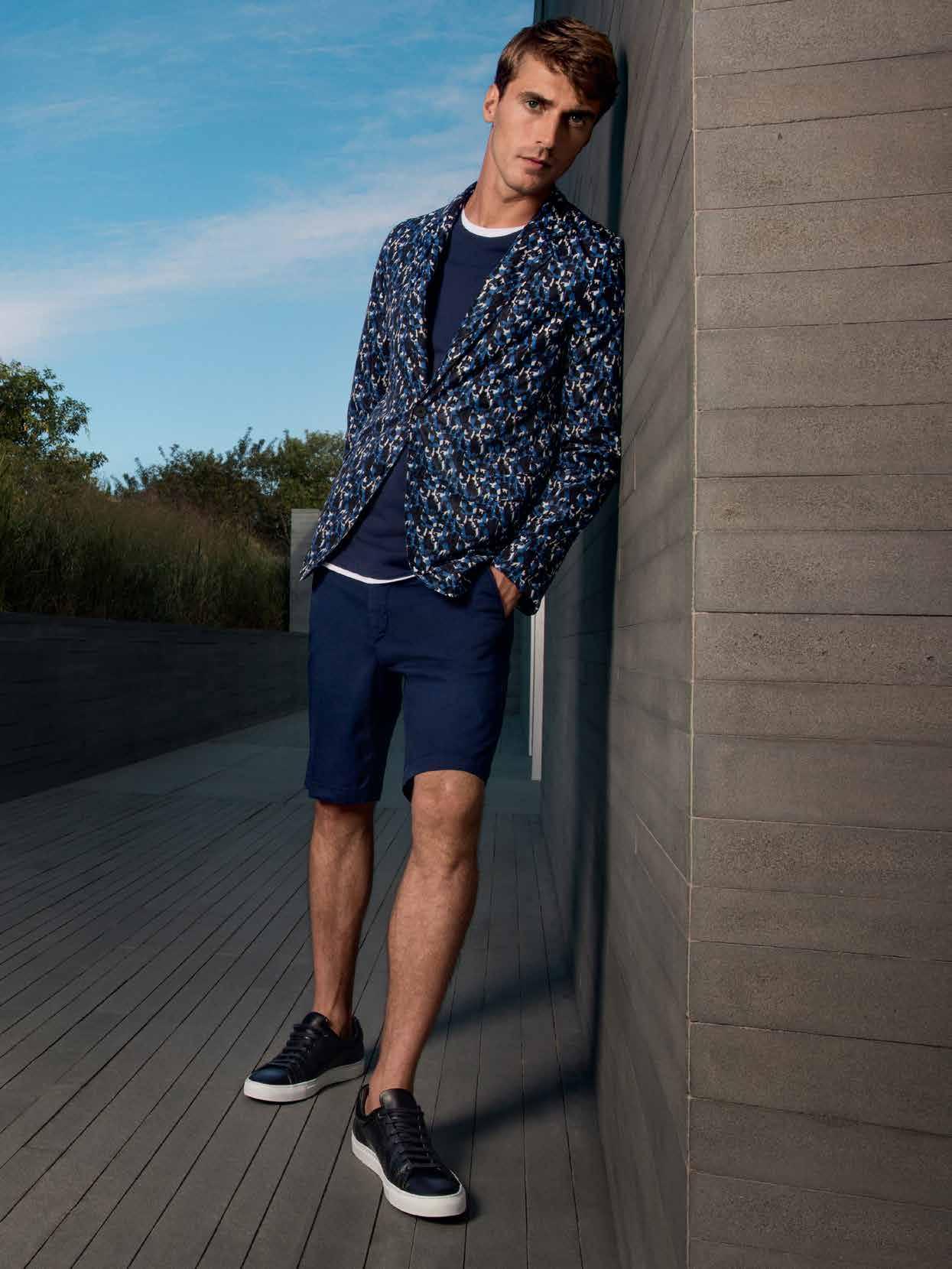


HISTORY „ROME IS MY CITY, WHILE GEORGIA IS MY HOMELAND " 76 STYLE 79 ARCHITECUTURE ARCHITECTURAL RENAISSANCE IN ITALY 82 VEHICLES MADE IN ITALY 86 SPORT TIFOSI ITALY 91 STORY AN EVIL THING 94 STATISTICS 96 NAPLES 98 VENICE THE STORY OF VENICE HOTELS RESTAURANTS SHOPPING FLORENCE SIGHTSEEING HOTELS RESTAURANTS SHOPPING CITIES SIENA PERUGIA / ASSISI LUCA / PISA SAN GIMIGNANO / VERONA WHEN THE WIND BRINGS THE SCENT OF THE SEA 118 100 / 105 106 / 109 110 / 117 Ceraceni Tiramisu TRUSSARDI ALLA SCALA CAFE Capuchino Tartufi Tolomeo-Michele De Lucchi Etro Gorgonzola 12 13 14 11 9 10 1 6 8 7 5 4 3 2
Barolo mogzaurisaTvis MILANOSOLO mamakacis kostiumis atelie fexsacmlis atelie qalis CanTa baletkebi qudebi rizoto tiramisu kapuCino soko Tavsafari sanaTi gorgonzola ruleti wiTeli Rvino
Rivolta Fendi Porselli Borsalino TRATTORIA MADONNINA Porchetta

Editor-in-Chief Tea Skhirieli
Art - Director
Nino Daraseli
Designer
Nino Kavelashvili
Illustrations by Maia Sumabdze

Translation by Lika Barabadze Photo - Shutterstock
3, 2016
Editor Salome Dadunashvili
Authors:
Aka Morchiladze
Margarita Antidze
Bidzina Baratashvili
Nikoloz Chkhaidze
Marika Shalikashvili
David Sakvarelidze
Zaza Chiladze
Mzia Chikhradze
Marina Kipshidze
Publisher: LTD SOLO
Phone.: +995 32 2 44 44 00
ISSN: 2346-8130
Printed by:
Bauer Medien Productions & Handels Gmbh
Adress: Baumannstrasse 3/19, A – 1030 Vienna, Austria
e-mail: office@bauermedien.at www.bauermedien.at Advertising:
Issue Consultation
Ketevan Japaridze
Administrative Assitant
Giorgi Vasadze
Advertisement Manager
Nazi Goshadze
Project Manager / SOLO DIRECTOR
Eka Duchidze
Project Consultant
Nino Gegeshidze
SOLO Brand Manager

Keti Nikoleishvili
Print Management: Ctrl P
Address: Tbilisi 0186, Kavtaradze 27a
Phone: +995 32 2 381 908
12 VOYAGER 3/2016
+995 599 330 364 / Published material owned by LTD SOLO. Written Consent of the Company necessary for use of any material published in this magazine.
ბოულინგ კლუბი - ლებოვსკი
• 12 ხაზიანი პროფესიონალური ბილიკი
• პულის და რუსული ბილიარდის მაგიდები
• კონცეპტუალური კაფე-რესტორანი
• ბილიარდის პრივატული ოთახი „Comfort Zone”
სამუშაო საათები: ორშაბათი-ხუთშაბათი, კვირა: - 11:00-02:00; პარასკევი-შაბათი: - 11:00-03:00
Tel: 591501010 | www.lebowski.ge | fb: lebowskibowlclub


TBILISI SOLO LOUNGE MTASTMINDA 11 Chitadze Str.

TBILISI SOLO LOUNGE ABASHIDZE 70, Abashidze Str.
TBILISI SOLO LOUNGE PALIASHVILI 23, Paliashvili Str.
TBILISI SOLO LOUNGE TSINTSADZE 12, Tsintsadze Str.
TBILISI SOLO LOUNGE Chavchavadze 29, Chavchavadze Ave.
TBILISI SOLO LOUNGE KAZBEGI 24G Kazbegi Ave.
TBILISI SOLO LOUNGE TSERETELI 73 Tsereteli Ave.

TELAVI SOLO LOUNGE Telavi 3 Cholokashvili Str.
KUTAISI SOLO LOUNGE KUTAISI 5 Q. Tamar Str.
BATUMI SOLO LOUNGE Batumi 22 Rustaveli Ave.
www.solo.ge ტელ.: +995 32 2 44 44 00


ROME
 SALOME DADUNASHVILI
SALOME DADUNASHVILI
When the spring sun touches centuries-year old cedar trees; when Trastevere cobblestones turn purple; when wisteria and Bougainvillea flowers color house walls with wild, childish coloring; and walls, already like paintings, become more vivid; when Rome is present in all its glory - you may think that you will never witness anything greater, greater than the worn-out palm frescoes on the temple walls, yellow-marble fountains or Caravaggio’s lightshades. And when the pantheon oculus looks you in the eye, if you are aware of at least some history, you may even lose your mind, because an eternity stares at you from this circular piece of sky; eternity, the second name of this city.
Rome is like a time puff pastry, a lasagne full of artefacts. It is located on the shores of the Tevere River. This is the name I like to give it, its real name, and what Italians call it. Tevere has witnessed the rise and fall of the most organized and sophisticated, corrupt and brutal civilization.
Subways can’t be constructed in Rome due to many archeological findings; water flows from the numerous small fountains, including one from the one with the small, nosy lion’s head. Its cobblestone is eternal, walked by a million centurions, pilgrims and tourist sandals.
The Jewish ghetto smells like fried artichokes, elders as
if from the paintings sit by the small shops and antique columns appear in every pothole.
Rome is impossible, just like Michelangelo’s genius. Only Italian ice-cream can lighten the weight of its importance. You’ll have some ice-cream right after you’ve witnessed something grandiose, something that has changed the course of history and civilization, and feel peaceful again. At lunchtime, when every Roman "is obliged" to grab a bite to eat, you will stand in a queue outside a shabby pizzeria, then lean against a mossy wall and sigh with pleasure –cold cheese Burrata, warm tomato and eggplant, together with a crunchy crust will melt in your mouth.
The strength of these seven hills that contained so much! The smallest one, forced by Michelangelo to turn its back to the forum, houses the Capitoline – campidoglio. Emperor Constantine’s giant finger touches the sky here and the mother wolf, Romulus and Remus stand nearby.
The popes always slept badly, saw dreams and built new squares and churches. That’s what happens when Michelangelo makes dreams come true.
And now I wonder: what did the Pope see in his dreams yesterday?
16 VOYAGER 3/2016
Author of the rubric: NINO GEGESHIDZE
PURCHASE
TICKETS ONLINE TO AVOID HUGE LINES. LEARN ABOUT ITALIAN CULTURAL HERITAGE - BE IT THE COLISEUM OR UFFIZI GALLERY, RUINS OF POMPEII OR LEONARDO’S LAST SUPPER.
TICKETS ARE ON SALE ONLINE. YOU CAN ALSO FIND OUT ABOUT OPENING HOURS AND HOW TO VISIT MUSEUMS, CATHEDRALS AND ARCHEOLOGICAL SITES.
Gregorian Etruscan museum displays ancient Greek pottery. Found in the Etruscan tombs.
St. Peter’s cathedral - the biggest Christian cathedral in the world, erected in 1506-1626, on St. Peter’s grave.
Museums in the pope’s palace - the Sistine Chapel with Michelangelo Buanaroti’s paintings on the ceilings and western wall (famous last judgment scene); Raphael’s rooms, called stanzas: Sala di Costantino, Stanza di Eliodoro, Stanza della Segnatura, Stanza dell'Incendio di Borgo. Julius II invited Raphael to the Vatican Palace. Raphael himself painted the first, stanza Della Segnatura. The others were done by his students according to his sketches.

Open every day, except Sundays, 9:00-16:00 (last Sunday of each month museums are open 9:00 to 12:30); admission: 16€
MODERN ART MUSEUM
MAXXI
21st-century Modern Art National Museum is located in the Flaminio area. It was designed by the renowned architect Zaha Hadid. Eight original structures are spread over 30,000 square meters, resembling a river delta. The museum offers a variety of experimental art and interiors.
Via Guido Reni 4
Open every day, except Mondays, 11:00-19:00, Saturdays 11:00-17:30.
MACRO
The aim of the museum’s founder (Odile Jacques) was to showcase international culture. The museum displays striking contemporary Italian and foreign artist retrospectives, solo exhibitions and large-scale cultural events. It also houses a large terrace, a bar, restaurant, and a bookstore.
Piazza Orazio Giustiniani 4
Open every day, except Mondays, 10:30-19:30.
TOP 10 HOTELS
J. K. PLACE ROMA
Via di Monte d'Oro 30 (district: Spagna); starting at 750€. Luxury.
HOTEL RAPHAEL ROME

Largo Febo 2 (district: Navona); starting at 400€. Luxury
VIA MARGUTTA 54
Via Margutta 54 (district: Spagna); starting at 350€. Luxury apartment.
D. O. M.
Via Giulia 131 (district: Navona); starting at 400€.
THE CAPITOLINE MUSEUMS
Roman copies of Greek art and sculpture have been kept on the Capitoline hill since the 15th century. Michelangelo's architectural constructions, the Palazzo Nuovo and the Palazzo dei Conservatori host these masterpieces. The latter houses the antique statue of Constantine and Bernini’s "Medusa", Veronese, Tintoretto, Caravaggio, Van Dyck and the finest work of other artists; the mother wolf with Romulus and Remus stands outside.
Address: The Piazza del campidoglio 1. Admission: 7.80€; Open every day, except Mondays.
PALATINO MUSEUMS
Museums located on Palatino hill offer excellent view of Rome. The hill is considered the birthplace of Rome. Its exhibition halls hosts the Middle Paleolithic archaeological artefacts, as well as the ancient Roman art.
Address: Via di San Gregorio; Open from 9:00 to 18:00; Admission: 12€ (entrance to the Coliseum and Roman Forum are included in the ticket price).
BORGHESE GALLERY
Villa Borghese Gardens and the palace are interesting sights to visit. They contain the Cardinal Scipione Borghese collection, which contains paintings, sculptures and antique artefacts.
Address: Villa Borghese the Piazza Borghese Scipione 5. Open every day, except Mondays, 8:30 to 19:30; Admission: 15€.
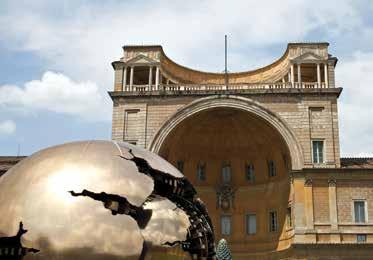
G-ROUGH
The Piazza Pasquino 69-70 (district: Navona); starting at 350€. Luxury.
THE FIFTEEN KEYS HOTEL
Via Urbana 6-7 (district: Monti); starting at 340€. Luxury.
GRAND HOTEL DE LA MINERVA
The Piazza della Minerva 69 (district: Pantheon); starting at 340€ . Provides classical comfort with a famous terrace.
CROSSING CONDOTTI
Via Mario de'Fiori 28 (district: Spagna); starting at 300€. High-class B&B.
GIGLI D'ORO SUITE
Via Dei Gigli D'Oro 12 (district: Navona); starting at 250€. Luxury guesthouse.
HOTEL ADRIANO
Via di Pallacorda 2 (district: Pantheon); starting at 230€. Houses the famous Gin Corner Bar.
17 VOYAGER 3/2016 MUSEUMS / HOTELS / ROME
COMMENT
VATICAN
Raphael's Rooms
Hotel Raphael Rome
the dome stands without any support. It is 143 meters in diameter (coinciding with the height of the building) and makes a lasting impression on visitors. It has always been a source of inspiration for architects, including Michelangelo, the creator of St. Peter’s cathedral. He made St. Peter's Cathedral’s dome 1.5 meters less wide in deference to the Pantheon.
Raphael is buried in the Pantheon area. His tomb carries the inscription: "Here lies Raphael, by whom nature herself feared to be outdone while he lived, and when he died, feared that she herself would die." The temple became a Catholic church in the 7th century.
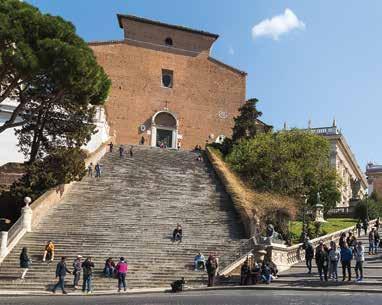

PANTHEON – (pan: all, theon - God, ancient Greek) The Emperor Hadrian built this temple in 125 BC. It is the only surviving example of ancient Roman architecture preserved in a perfect state. Emperor Hadrian, as a sign of humility, did not mention his name on the facade and paid tribute to the creator of the first pantheon: "M. AGRIPPA. L. F. COS. TERTIUM. FECIT – "Erected by Marcus Agrippa, son of Lucius, elected Consul three times".
Pantheon is known for its legendary dome. Made of Roman concrete (5,000-ton) 20 centuries ago,

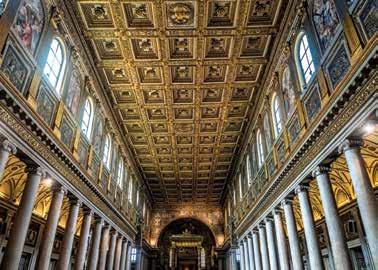
BASILICA DI SAN CLEMENTE This church (often called lasagna) is adjacent to the Coliseum. It carries the name of the third Pope. It expresses archeological diversity: a 12th-century basilica built on the top of 4th-century churches, which, in turn, were constructed on top of a 1st-century pagan temple. It is possible to visit all three spaces. The difference between the levels is approximately 18 meters. Visitors enjoy the beautiful murals, mosaics and relics.
SANTA MARIA ARA COELI _ this temple is the Rome’s most ornate, with crystal chandeliers and beautiful 6th, 8th, 9th and 11th century mosaics. It is located on the highest point of Capitoline Hill. According to the legend, the Old Testament prophet, virgin Sybil, heralded the birth of God's son to Emperor Augustus with the words "Haec est ara filii Dei", which gave the temple its name.
BASILICA SAN PIETRO IN VINCOLI Via Cavour in Vincoli - travel upstream from the San Francesco di Paola dark stairs to suddenly enter the San Pietro in Vinkoli square; here, behind the facade of a 16th-century temple, this 5th-century temple holds two important treasures: the first is St. Peter's chain, used to hold him captive in Jerusalem, and the other, no less important, is Michelangelo's Moses (1513).
Legend has it that Michelangelo was so enchanted by the realistic image of his creation that he threw a tool at it, shouting: "Parla!" ("Speak Up!").
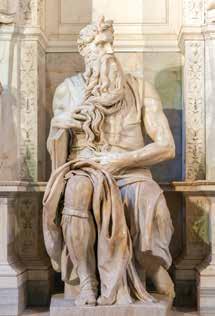
Contains a wooden statue of Christ the Newborn, made of olive tree from the Gethsemane. An impressive, 124-step ladder leads to the temple. It was built in the 13th century to commemorate the end of the plague.

BASILICA SANTA MARIA MAGGIORE _ the most important early Christian Catholic church dedicated to Virgin Mary. It is unique, as it has not suffered any alteration, unlike many Roman temples. Despite the Baroque façade, the interior was built in 440 and is adorned with 5th-century frescoes and mosaics. Every year, thousands of white rose petals are thrown from the ceiling of the temple on August 5, symbolizing the biblical legend about snow in summer.

18 VOYAGER 3/2016
BASILICA DI SANTA MARIA DEL POPOLO _


the basilica was built in 1099 on the "blood-thirsty and crazy" Emperor Nero's grave site. The locals were convinced that the dark tree that had grown on the grave and was attacked by crows was Nero's restless wandering soul. Panic was so great that the Basilica of St. Mary was built, with the Pope's consent and public funding. The temple was built in 1478 in its current form; Bernini’s baroque façade was added in 1660. This unique temple contains art by Pinturicchio, Raphael, Caravaggio and Bernini among others.
SANTA MARIA SOPRA MINERVA _ massive


13th-18th-century facade hides a rare Italian Gothic interior. The church was built on top of temples dedicated to the Roman goddess Minerva, the Egyptian goddess Isis, and Hellenistic Egyptian chief god Serapis. It houses Michelangelo's Christo della Minerva (Statua del Redentore), Filipino Lippi’s painted Cappella Carafa and the tomb of St. Catherine, the patron saint of Siena. Bernini’s sculpture, Pulcini della Minerva (1667) stands in front of the church. The smallest of the remaining 11 Egyptian statues lies on top of it with an inscription: "a strong mind needs support of solid knowledge".
SAN LUIGI DEI FRANCESI _ 16th-century temple known for probably the best work of Caravaggio, the unrivaled chiaro-scuro (light and shade) master, and the most dramatic and surprisingly modern painter of the late Renaissance period. It houses his works, The Calling of St. Matthew, St. Matthew and Angels, and The Martyrdom of Saint Matthew.
SANTA MARIA DELLA CONCEZIONE
DEI CAPPUCCINI the cathedral was built in 1626 on the orders of Pope Urban VIII (his brother, Cardinal Antonio Barberini was a member of the Order of Capuchin). The monk skeletons were moved to the cathedral in 1631.
As a result, visitors get the opportunity to
see unique, scary and kitschy exhibitsincluding the "decoration" of 400 Franciscan monks. The South entrance has an inscription: "now you are what we were. You will become what we are now".

The Marquis de Sade noted that he had not seen anything that made such an emotional impact!

SAN PIETRO _ Emperor Constantine laid the foundation for one of the world's biggest and most important basilicas of the Catholic world in 320. The temple took 200 years to be built, with the input of great masters - Bramante, Raphael, Bernini and Michelangelo. The latter’s architecturally impressive dome and religiously and emotionally unparalleled Pieta sculpture impress the viewer every time.
BASILICA SANTA MARIA IN TRASTEVERE _
the ancient church is located in the heart of the Trastevere district. It is the first public Christian place of worship, decorated with 12th-13th-century unique gilded mosaics both in the interior and exterior. It shines brilliantly at dusk and gives the legendary piazza a mystical air.

19 VOYAGER 3/2016 TEMPLES / ROME
THE TREVI FOUNTAIN COIN-TOSSING TRADITION IS STRICTLY DEFINED: TURN YOUR BACK TOWARDS THE FOUNTAIN, TAKE THE COIN IN YOUR RIGHT HAND AND TOSS IT OVER YOUR LEFT SHOULDER. ONE COIN MEANS A WISH TO COME BACK TO ROME, TWO – TO BE LUCKY IN LOVE, AND THREE –MARRIAGE.
FONTANA DI TREVI - one of the most famous Roman baroque fountains; its precursor was constructed by the legendary Agrippa, Emperor Augustus’s son-in-law, in 19 B.C. He sent soldiers to look for spring water, in order to transport fresh water to Rome via aqueduct. A young girl helped soldiers find it and the aqueduct was called Aqua Virgo in her honor. It is hard to believe that it still provides water to the fountains located in the historical center.
The Trevi fountain received its grandiose, tourist-attractive form in the 18th century when Niccolò Salvi on the order of Pope Clement XII created the sculpture, following Bernini’s sketches.


FONTANA ACQUA PAOLA – a masterpiece created by Giovanni Fontana in 1612. It is called Il Fontanone (the great fountain) in reverence. It is situated on top of Capitoline Hill, offering a breathtaking view of the city.
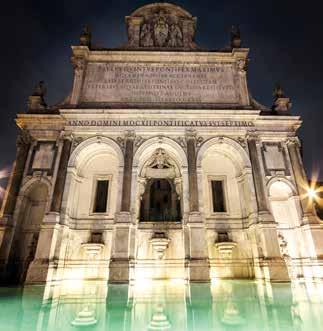
FONTANA NAVONA – the central fountain of the three located on the Piazza Navone. The "four rivers" is Bernini’s work of genius, made on the order of Pope Innocent X, in 1648. Four rivers, well-known at that time, are sculpted: Danube in Europe, a figure with hair tied in the back; Ganges in Asia, with an oar in the hand; Nile in Africa (it was unknown where the river started, so the figure has fabric on the head); Rio della Plata in America that had just been discovered.
The figure puts its hand against the sun, seemingly shielding the eyes from the Catholic star placed on the top of the obelisk. Giacomo della Porta’s (a famous "fountaineer") fountain with four tritons, stands on the south part of the piazza. Bernini later added a central figure to it. The 19th-century Neptune fountain is located on the northern part of the piazza.
FONTANA DELLE TARTARUGHE
– is located by the entrance to the so-called ghetto, one of the oldest districts in Rome. It was constructed by Giacomo della Porta (16th century). This bronze fountain was the first to be built with private funds. It is called the "turtle fountain". Rich politician Mattei used his influence to place the fountain in front of his family pallazzo.
FONTANA DEL TRITONE – Rome’s first statue fountain, created by Bernini in the 17th century, on the order of Pope Urban VIII. It is the best of the best. Every public fountain before was a marble tub that provided the public with water. Statues adorned fountains of the private, wealthy gardens only. The Triton and Trevi foun-
tains have similar coin-tossing traditions.
FONTANA DELLA BARCACCIA
- The "ugly boat" fountain is located on the Piazza Spagna, by the stairs. It looks like a sunken boat. Before a high river bed was built around the Tevere River, this district was often subject to flooding. A boat was washed ashore after one such flood. Pope VIII asked Bernini to depict this occasion.
FONTANA DELLE NAIADI – Probably the most exciting (erotic) Roman fountain with water nymphs was created by Mario Rutelli in the 19th and 20th centuries. This beautiful structure is located in Piazza della Repubblica, designed by Michelangelo (adjacent to Rome’s main station).
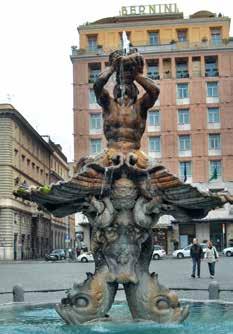

20 VOYAGER 3/2016
1
1. Fontana di Trevi
2. Fontana del Tritone
3. Fontana Acqua Paola
4. Fontana Navona
2 3 4 5
5. Fontana delle Tartarughe
PIAZZA DEL POPOLO - in ancient times, it was located by the Northern gate of the city. The local population claimed that the square was haunted by the soul of a blood-thirsty Nero; his grave was located nearby (St. Maria del Popolo church was constructed to appease the population and two more churches of St. Mary joined the square after several centuries: St. Maria dei Miracoli and St. Maria de Montesanto). One of the first fountains in Rome was built on this piazza. The Pope asked architect Giuseppe Valadie to reconstruct the piazza in the 19th century, retaining all three churches and the obelisk. Valadie created a masterpiece of urban architecture – an elegant square with an ideal view of three streets (via Babuino, via del Corso, via della Ripetta).
PIAZZA DI SPAGNA - shaped like a butterfly (comprised of two triangles) it contains the main Roman attraction and symbol - the Spanish Steps. The steps were built so that the Spanish ambassador (whose palace was located nearby) could access Trinita dei Monti French cathedral on the Pincian Hill. Francesco de Sanctis designed it. It contains 135 steps, harmoniously blending with the Pincian Hill and has terrace steps, unusual for that time.
PIAZZA DELLA ROTONDA / PANTHEON - it is impossible to visit Rome without crossing this piazza at least once. Perched on the Giacomo della Porta fountain, visitors can enjoy the best view of the Pantheon. The piazza carries the cathedral name (Rotonda means round).

PIAZZA CAMPO DEI FIORI – a beautiful and fun piazza houses the flower mar-
THE PIAZZA NAVONA _
IPerfect example of Italian baroque. Pope Innocent X was reconstructing his family’s Pamphilj Palazzo and decided to renovate St. Agnes cathedral and build new fountains. He contracted famous baroque craftsmen, such as Bernini (Four Rivers, Moor), Borromini (St. Agata cathedral) and Rainaldi (Pamphilj family palace).
ket and transforms into a place where the young gather in the evening. Dominican monk, Giordano Bruno was burned alive in this piazza on February 17, 1600. A statue of him was erected in 1888, right where his verdict was read.
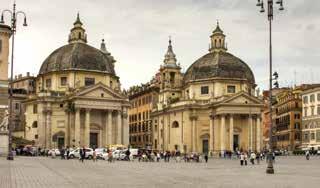

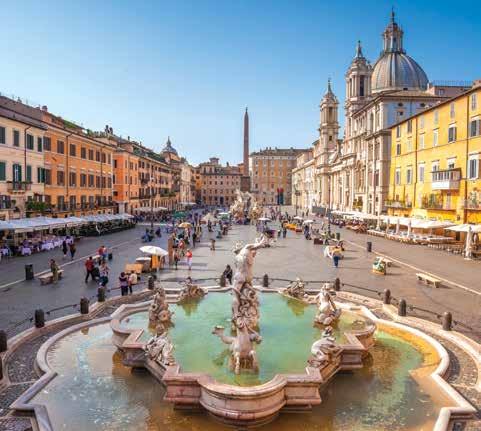
PIAZZA LARGO DI TORRE ARGENTINA – A shelter for homeless cats, this well-known piazza is located on the ruins of three important ancient temples. The west side of the square contains brick wall ruins of the main entrance to the Pompeii baths and theater complex. The Roman "Curia di Pompeii" (Senate session) was held in 1 B.C., in this complex area, while the new senate was being constructed on the Forum. This is where Brutus, Cassius and the other senators stabbed Emperor Gaius Julius Caesar on March 15, 44 B.C.
PIAZZA VENEZIA - the unity and independence of Italy was celebrated by the expansion of this area, in 1885.Vittorio Emanuele II's grand monument (nicknamed the "typewriter"), which was built in 1911 by Gaetano Koch, became Rome’s calling


card, thanks to films such as The Bicycle Thief and Roman Holiday.
Piazza Campidoglio – Capitoline Hill has been a symbol of strength since the Roman Republic. When Emperor Charles V decided to visit Rome in 1536, the piazza was in poor condition. Pope Paul III asked Michelangelo to draw new Piazza Campidoglio sketches. Michelangelo created an entirely unexpected, trapezoidal space, with a beautiful light-colored cobblestone pavement and elliptic ornaments. He designed and built the magnificent staircase system and restored the Senatorio Palazzo.
PALAZZO DEI CONSERVATORI façade was changed and placed in the "pinacoteka Capitolina" (on the right of the building). On the opposite side of the square (left), "Palazzo nuovo" (current Capitoline Museum) was built. Michelangelo considered the grand staircase "kordonatas" to be the main decorative element. A replica of the Emperor Marcus Aurelius statue is in the center; it stands on a pedestal constructed by Michelangelo (the original is kept in the Capitoline museum).
21 VOYAGER 3/2016
2 FOUNTAINS / PIAZZAS / ROME
1. The Piazza Navona; 2. The Piazza Venezia; 3. The Piazza Campidoglio; 4. The Piazza Di Spagna; 5. The Piazza del Popolo; 6. The Piazza della Rotonda / Pantheon
1 3 4 5 6
DAL BOLOGNESE
The classic restaurant serves famous dishes from the Emilia-Romagna region: bolito frito and misto. It is super popular and often full of famous people. The terrace overlooks the Piazza del Popolo. Reservations necessary. Price starting at 70€. Mondays-Sundays 12:30-15:00 / 20:25-23:00
The Piazza Del Popolo 1 (Popolo)
CASA COPPELE
Offers Roman-French cuisine. Parisian designer Jacques Garcia (author of the famous Coste hotel) created the interior, while Chef Fabio Rossi came up with the unforgettable menu: Pasta alla Gricia with Artichokes and shrimps cacio e pepe.
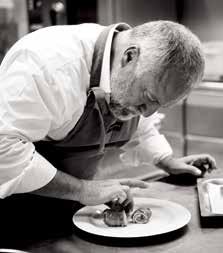


The restaurant is famous for its wine selection and cocktails (Marie Antoinette). Price starting at 75€.
Open: 12:00-15:00/18:30-24:00.
The Piazza della Coppelle 49 (Pantheon)
NINO
The restaurant has offered a choice of excellent Tuscan dishes since 1934. The legendary Florentine steak stands out.

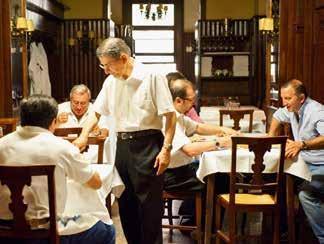

Price: Starting at 45€. 12:30-15:00/19:30-23:00; Closed on Sundays.
Via Borgognona 11 (Spagna)
Beautiful restaurant terrace.
PIPERNO
This restaurant is located on a picturesque piazza in the Italian ghetto. Here you will taste the legendary fried artichoke alla giudìa and roasted zucchini flowers; also, try any pasta dish, like spaghetti alle vongole with mussels.


Price starting at 40€. Open: 12:45-14:20/17:45-22:20; Closed on Mondays.
Via Monte Dè Cenci 9 (Ghetto)
ROSCIOLI
OPEN COLONNA
Modern gourmet restaurant located behind the Palazzo Dele Espozitsionis museum and led by Chef Antonio Colonna. The space is devoted to the lunch buffet during the day; under the auspices of the Roman city, clients can enjoy surprisingly cheap fixed-price meals.

BACCANO
Inspired by New York's legendary Balthazar, this bistro is a great place for lunch or for an aperitif. Enjoy Mediterranean dishes and oysters. Price: Starting at 35€. Open: 12:00-15:30/18:30-24:00.

Via della Muratte 23 (Trevi)
Price: Dinner starting at 60€. Lunch starting at 16€.
Via Milano 9a (Monti)
This high-quality delicatessen has been transformed into one of the most famous Roman restaurants while retaining its original function. The place is so popular that additional tables are placed by the produce counters. Cheese and sausage antipasti, carbonara and gricha dishes and a wide selection of wines are available.
Price starting at 60€.
Open: 7:00-23:30; Closed on Sundays.
The Antico Forno Roscioli, a popular bakery of the same company is located on an adjacent street and is famous for its unique pizza sold in slices.
Via dei Chiavari 34
22 VOYAGER 3/2016
L'ANTICA NORCINERIA
L'Antica Norcineria
A small shop, pride of the Trastevere, where you can taste the Roman Porchetta Panino


Via Natale del Grande 16 (Trastevere).
IL SANLORENZO
A high-end, sophisticated fish restaurant. Chef Tommaso Madalena offers the best Lazio catch, prepared with great care. The staff will help you choose, and the sommelier will offer Italian or French wines that best complement the dishes.

Price starting at 100€. Open: 12:30-14:45/19:30-23:00.
Via dei Chiavari 4/5 (Campo dei Fiori)
LA CASETTA
The famous little bistro house located in Rome's most beautiful and trendy district, Monti. Hipsters and tourists gather here.

Open: 09:00-20:00.
Via della Madonna dei Monti 62 (Monti)
True Roman trattoria, to which customers always return. Price starting at 30 €. Open: 12:30-14:30/19:30-23:30.
via dei Vascellari 29 (Trastevere)
ARMANDO AL PANTHEON
Fortunately, nothing has changed in this famous Roman restaurant, since its foundation (1961).
Try these dishes: pasta with chicken fettuccini, saltimbocca, Trippa Alla Romana and ajo, ojo e peperoncino: pasta with garlic, olive oil and pepper. Price starting at 50€. Open: 12:30-23:00.
Salita dei Crescenzi 31 (Pantheon)
COMMENT:
AL MORO
Roman restaurant by the Trevi fountain; this favorite haunt of Roman politicians and journalists boasts a high-quality, seasonal menu of artichokes, spaghetti and puntarele, and spaghetti al moro, an absolute must-taste.


We recommend reserving in advance.
Price starting at 40€. Open: 13:00-15:30/20:00/23:30.
Vicolo delle Bollette 13
AI MARMI
Famous, crowded Roman pizzeria, and everyone’s favorite. You cannot feel the Trastevere heartbeat without visiting this place (the later the better).

Open: 19: 00-02: 00.
Viale di Trastevere 53 (Trastevere)
LA REGOLA
Chef Marina Perna offers a wide variety of different species of fish with Liguria cuisine elements: antipasto Genovese and wonderful spaghetti and lobster. Price starting at 40€. Open: 12:30-23:30.
The Piazza di San Lorenzo alla Regola, 40 (Campo Dei Fiori)
YOU MAY DRINK WATER FROM ROMAN WATER FOUNTAINS.
The mayor of Rome, Luigi Pianciani established drinking water fountains in 1874. 100kg, 120 cm tall, cast-iron fountains, intended for free use have three dragon-shaped holes. There are old fountains on the Piazza della Rotonda, via di San Teodoro, behind the Roman Forum and on via delle Tre Cannelle.
There are more than 2,000 nasoni (big-nosed) Roman water fountains. Cover the outlet with a finger to direct the stream upward for a comfortable drink of water.
23 VOYAGER 3/2016 RESTAURANTS / ROME
DA ENZO AL 29
BUCCONE
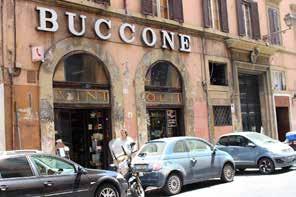
Great selection of wines and a perfect place to buy an unforgettable gift or to taste a Roman antipasto on the spot.

Via di Ripetta 19/20 (Popolo)
ROMA SPARITA
This restaurant is located in one of the oldest parts of Rome, by the beautiful Santa Cecilia church. Gourmets visit it to try just one dish: typically Roman cacio pepe pasta, which is placed in a basket of fried pecorino. Visit the church during lunch or dinner hours.

Price starting at 40€.
The Piazza de Santa Cecilia 24 (Trastevere)
STRAVINSKIJ BAR
The bar is located in the courtyard of a famous De Russie hotel courtyard. It is known for its luxurious atmosphere, rich clientele and important cocktails, especially for the gin-based drinks. Dress code observed.
Via del Babuino 9 (Piazza del Popolo)
GIN CORNER
IL GOCCETTO
Classical Enoteca with a wide selection of Tuscan wines. Open: 12:00-15:30/18:30-24:00; closed on Sundays and Mondays.
Via dei Banchi Vecchi 14 (campo de'Fiori)
THE DEER CLUB
An elegant Roman bar on the left side of the D.O.M. hotel's entrance, decorated with Venetian chandeliers. Excellent bartenders. The place is tremendously popular, so reservations have to be made in advance.
Hotel guests have guaranteed access.
Via Giulia 131 (Campo de'Fiori)
CASA BLEVE
This prestigious enoteca is located in a 16th-century palazzo. In addition to amazing wines, it offers a selection of interesting courses: parmesan and anchovies, ravioli with lamb ragu, and ham marinated in Nebolio wine. A sommelier will introduce you to Italian wines.

Prace: Starting at 65€.
Open: 12:30-15:00 / 19:30-23:00; Closed on Sundays.
Via Del Teatro Valle 48/49 (Navona)
FIASCHETTERIA BELTRAMME
The favorite restaurant of legendary Italian director, Pier Paolo Pasolini. Boasts an ideal location and excellent Roman dishes. Try truffle ravioli, lasagne and pasta carbonara. Price starting at 40€. Open: 12: 15-15: 00/19: 30-22: 45.
Via della Croce 39 (Spagna)
Attention gin-lovers! This bar, located in the famous Adriano hotel, presents an opportunity to taste 80 types of skillfully-prepared cocktails.
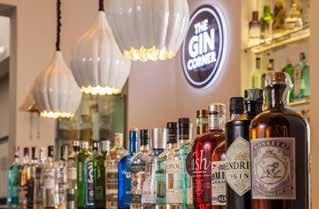

Via di Pallacorda 2 (Pantheon)
CLUB DERRIERE BAR DE FICO
One of the oldest and favorite Roman bars is placed in the charming little square and is surrounded by a lot of good restaurants.

Active: 19: 00 till late night. The bar is famous for its mojitos.
Open: 08:00- 02:00.
The Piazza Del Fico 26 (Navona)
A password obtained through a phone call is necessary, in accordance with the speakeasy concept.
Visit 1920s-style decadent club and enjoy modern cocktails while listening to Jazz.

Open 24 hours.
Vicolo delle Coppelle 59 (Pantheon)
24 VOYAGER
3/2016
SALOTTO 42
Reservation (or long queue) is required to get into this small bar located on the picturesque Piazza Di Pietro.
There is a third option: choose a drink from the interesting bar menu and, glass in hand, sit down somewhere on the piazza in the evening. Satisfaction guaranteed.
The Piazza di Pietra 42 (Pantheon)
BEST ICE CREAM IS MADE IN ROME!
GIOLITTI
This café (originated in 1890) is popular among tourists and members of parliament alike. It is renowned for its artisan ice cream.
Via deli Uffici del Vicario 40 (palazzo Montecitorio, Pantheon)
SAN CRISPINO
ANTICO CAFFÈ GRECO
Rome's most famous shopping address, a historical and very elegant cafeteria.
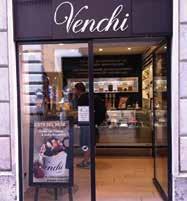

Via Condotti 86 (Spagna)
CHORUS
The beautiful bar is situated on the avenue leading to St. Peter’s cathedral. It is famous not only for the amazing view, but also for leading Roman mixologist (barman), Massimo Dadezio. Try Bloody Max and Japanese 75, as well as their famous steak tartar with Parmesan ice-cream. Open: from 19:00.
Via della Conciliazione 4 (s. Pietro)
This cafe will surprise you with its diversity. Here you can taste honey, grapefruit, melon, cinnamon, ginger and hazelnut ice cream. This place is an ice-cream paradise, appealing to the most particular of ice-cream connoisseurs.
Via della Panetteria 42
GELATERIA DEL TEATRO
A cozy place with a backyard. Try red wine or raspberry and sage ice cream.
Via di San Simone 70
TAZZA D'ORO
CIAMPINI

Classic cafe with excellent ice cream, ideally located directly behind the Botega Veneto store.

The Piazza San Lorenzo in Lucina 29 (Teidente, via del Corso)
THE JERRY THOMAS PROJECT
Speakeasy concept bar, which asks for a password (join the site for the password). It may treat its exclusivity with excessive pompousness, however the fact remains that founder Jerry Thomas remains one of the best Roman mixologists.



Open: 22:00-04:00; Closed on Mondays and Sundays
Vicolo Cellini 30 (Campo de'Fiori)
VENCHI
via della Croce 25/26 (Spagna)
Via degli Orfani 87 (Pantheon)
FATAMORGANA
Via Roma Libera 11 (Trastevere)
The piazza degli Zingari (Monti)
GELATERIA DEI GRACCHI
Via dei Grecchi 272 (Prati)
CANOVA
Federico Fellini's favorite café, with an excellent location on the Piazza del Popolo.
The Piazza del Popolo 16 (popolo)
One of Rome’s most famous coffee bars, where you must have a cappuccino or espresso.

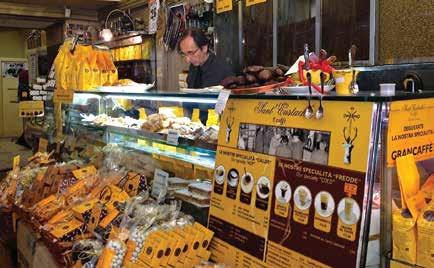
Via degli Orfani 84 (Pantheon)
SANT'EUSTACHIO CAFFÈ
It is traditional to visit this bar upon arrival in Rome. Approach the bar counter, have a shot of foaming espresso or espresso macchiato and proceed to Caravaggio's frescos. You will have a perfect Roman day.
The Piazza Sant'Eustachio 82 (Pantheon)
25 VOYAGER 3/2016
BARS / CAFES / ROME
FAUSTO SANTINI
Fausto Santini is the true Roman shoemaker, whose philosophy is harmony between architecture and comfort. Always innovative, Santini is constantly collaborating with the leading Italian architects. As a result, his products are always distinctive and absolutely unique.

Via Frattina 120 (Spagna)
DEGLI EFFETTI
The interior was designed by the famous Italian architect, Massimiliano Fuksas; it contains carefully-selected clothes by the world's leading designers: Lost And Found, Lumen Et Umbra, Maison Martin Margiela, Marsèll, NeroInk, Original Vintage Style. The men’s store is located in #79, women‘s - #93.
The Piazza Capranica 79; 93 (Pantheon)
ACQUA DI PARMA
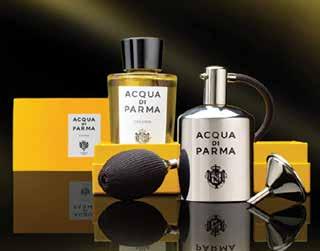
The main shop of the world-famous perfume brand; its luxurious interior was created by the well-known Canadian designer, Natalie Rhine.
Men’s salon is addition to the firm's wide variety of products. Open: 10: 00-19: 30.
The Piazza di Spagna 27 (Spagna)
SERMONETA
The high-quality glove store founded by Giorgio Sermoneta in 1960 has become one of the most recognizable accessory brands in Italy.

Open: 9: 00-20: 00.
The Piazza di Spagna 61 (Spagna)
GENTE
High fashion multi-brand store. Here you can buy accessories from the latest collections of such wonderful clothing designers as: Marina Fossati, Matthew Williamson, Miansai, Nanni, Nightmarket, Oscar de la Renta, Pepper Chocolate, Stella Jean.


Open: 10: 30-19: 30.
Via del Babuino 77, 81, 185 (Spagna)
DAVIDE CENCI
This store is the quintessence of class, regularly visited by members of parliament.
Customers can choose from carefully selected clothing and shoe collections (for men and women) of the leading Italian and British brands. A children’s store has just opened across the street.
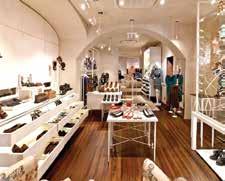
Open: 9:30-13:30 /15:30-19:30; closed on Sundays.
Via Campo Marzio 1-7 (Pantheon)
BATTISTONI
This Italian house offers a unique range of men's clothing, where each item is made with great skill. High product quality is proportional to the price.

Open: 10: 00. -19: 00; Closed on Sundays and Mondays.
Via dei Condotti 61 (Spagna)
DORIA 1905
High fashion multi-brand stores are situated in different buildings on Babuino St. (Men - #185). The Doria family opened the hat store here in 1905 in Puglia, in the city of Lecce.


Open: 10: 00 -20: 00. Saturdays from 14:00. Closed on Sundays.
Via dell'Orto di Napoli (Spagna)
26 VOYAGER 3/2016 SHOPPING / ROME
Elegance is an attitude




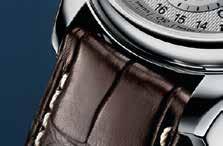



















 Simon Baker
The Longines Master Collection
Simon Baker
The Longines Master Collection
MILAN
It was drizzling in Milan. It often drizzles in Milan, and I think this fits very well with the surroundings. I stopped at the corner traffic light and I saw him – the best-dressed man that I had ever seen. Whose wardrobe you want to plunder and take all the unisex items for yourself. I won’t even try to describe all the details of his outfit. But I can tell you: this can happen only in Milan.
It is probably the most non-Italian city in the country (if we take Naples as a benchmark of all things Italian). That means no chaos, hubbub, impolite honking of car horns, or grandfathers playing dominoes in white Tshirts. Few people are named Pepe, Jiji or Dodo. Instead, there are the people who I met, leading designers and architects. Finally, there is Miuccia Prada, with its Fondazione Prada.
Shops open and close on time here. And yes, Milan’s shops are absolutely unique. Meanwhile, if you take a Sunday stroll from Duomo Square down to the canals designed by Leonardo da Vinci, you will see the other Milan: young, crowded and full of energy. A city busy laying down vertical gardens, which becomes a center of fashion and design twice per year and can seem magnificently small and calm in between.
SALOME DADUNASHVILI
Milan, with its hidden wealthy, superbly designed villas, could be used as a blueprint, with ecological architecture and an understanding of creativity that, like Leonardo’s golden ratio, accepts only perfection. Walk onto the Duomo di Milano. Simply sit in the elevator and you will find yourself between Gargoyles and Milanese pigeons. None of the flowers or ornaments are repeated in these stone gardens. This marble spirit dominates the whole city.
And, having climbed all of the stairs, you find yourself atop Duomo di Milano, Italy’s largest cathedral. Up in the sky, you are accompanied by restorers of the Duomo and Madonnina. The Milanese placed the Madonna statue 108 meters up on the top of a VI century building. Since then, the Madonnina has ‘controlled’ the sky over Milan. Industrial Milan started occupying the sky in the 50s. But there was general agreement that the Madonnina should be higher than everything else. Thus, a smaller copy was placed on the skyscraper, and another on another building.
Milan is thus under the care of three Madonnas instead of one. It supports industry with triple energy and adorning Lombardy. The end of fairy tale.
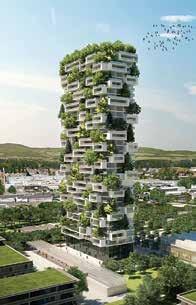
GO UP TO THE DUOMO ROOF, WEATHER PERMITTING (AN ELEVATOR IS AVAILABLE). HERE YOU CAN BASK IN THE SUN AND ENJOY ONE OF THE CITY’S BEST VIEWS. MOST IMPORTANTLY, OBSERVE THE SCULPTURES OF THE CATHEDRAL FAÇADE TO APPRECIATE ITS DIVERSITY AND UNIQUENESS.

28 VOYAGER 3/2016
Bosco Verticale
Author of the rubric: NINO GEGESHIDZE
BASILICA DI ST. AMBROGIO
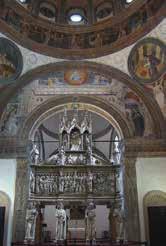

The oldest basilica in the city (379-386 B.C), this is an ideal example of Roman architecture. It was built by a bishop, later recognized as Saint Ambrogio (Sant’Ambrogio). His magnificently realistic portrait appears on IVV century mosaics. Visit the basilica to see the Christian world’s most important sarcophagus, the Altare d'Oro, which was created by famous IX-century goldsmith Volvino.
Open: Mondays-Saturdays 10:00-12:00, 14:30-18:00
SANTA MARIA PRESSO SAN SATIRO
The temple (known as a masterpiece of optical illusion, or Trompe-l'oeil), decorated by XV century genius Donato Bramante, is the classical model of the Italian Renaissance. Bramante, an admirer of simplicity and minimalism, created an infinite perspective within only 97 sm. width alcove. Open: Thursdays-Saturdays 9:30-17:30, Sundays 14:00-17:30.
Via Torino 17/18
SAN MAURIZIO AL MONASTERO MAGGIORE
The temple beside Milan’s largest nunnery hides a real treasure behind its simple façade. The rich interior was painted by the most important Milanese painters of the XVI century: Paolo Lomazzo, Simone Peterzano, Ottavio Semino, and the most important, a student of Leonardo da Vinci and Rafael, Bernardino Luini. The beautiful frescoes alone are worth the visit.
Open: Thursdays-Saturdays 9:30-17:30
Via Corso Magenta 15
SANTA MARIA DELLE GRAZIE
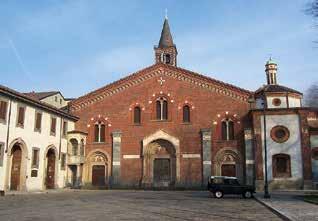

Everyone should see Leonardo da Vinci’s The last Supper at least once. It is preserved in the monastery’s dining hall.

Wall paintings eventually deteriorate, and these have undergone extensive restoration. Thus, nowadays they resemble the original only approximately.
Nonetheless, Jesus’s last supper with his disciples and his prophecy ”I tell you the truth, one of you will betray me” still evokes strong emotions in visitors.
A fresco of the crucifixion is exhib-

ited in the front; it is a masterpiece by Giovanni Donato da Mortofano. View The Last Supper Thursdays-Sundays, 8:15-18:45
Tickets can be booked a couple of days in advance at www.vivaticket.it (commission of 1, 5€ is charged) ticket price 6,5€.
The Piazza di Santa Maria
delle Grazie 2
Open: Mondays/Fridays - 7:0014:00 and 15:00-19:00; Saturdays/ Sundays - 7:30-12:15 and 17:30-21:00. Entrance is free of charge.
Piazza S. Ambrogio 15
SAINT'EUSTORGIO DA CAPPELA PORTINARI
The cathedral near the Capella Navigli canals. It is religiously significant, with three Old Testament relics being kept here. Cappella Portinari is a remarkable combination of architecture, sculpture and frescos. The chapel was commissioned by Florentine nobleman Pigello Portinari, who was a representative of the Medici Bank. This is why his namesake chapel looks like the cupola of the basilica of San Lorenzo, Florence. Its walls were painted by Vincenzo Foppa.
Open: daily 10:00-18:00
Piazza Saint Eustorgio 3
COMENTS:
• Visit the Pinacoteca di Brera Museum to enjoy at least one masterpiece –Francesco Hayez’s Il Bacio (The Kiss);

• See Michelangelo’s sculpture at Pietra Rondanini Castelo Sforzesco at the Piazza Castello

MUSEUMS
PINACOTECA DI BRERA
A large collection of Renaissance art with more than 500 masterpieces. Here you can see pieces by Piero della Francesca, Raphael, Bellini, Caravaggio, Tintoretto and Veronese.
Address: Via Brera, 28. Open Tuesdays-Sundays.
Price: 32€
PALAZZO REALE
Contemporary and new world masterpieces can be viewed at the former royal palace.
Address: Piazza del Duomo, 12.

Open: daily. Price: 12€
PINACOTECA
AMBROSIANA
A collection of Cardinal Federico Borromeo’s paintings: Leonardo’s Portrait of Musician, Caravaggio’s Fruit Basket, Raphael’s cartoon The School of Athens, Titian’s Adoration of Magi and Botticelli’s Madonna del Padiglione.
Address: Piazza Pio XI 2.
Open: Tuesdays-Sundays
Admission: 15€
29 VOYAGER 3/2016 TEMPLES / MUSEUMS / MILAN
Duomo di Milano
Basilica Sant'Ambrogio
Sant'Eustorgio
Pietro Mart (1460) Cappella Portinari
Santa Maria delle Grazie
Ultima Cena, Leonardo da Vinci
ARMANI
HOTEL
Via Alessandro Manzoni 31 (District: Montenapoleone); Price starting at 450€. Design delux
GRAND HOTEL ET DE MILAN
Via Alessandro Manzoni 29 (District: Montenapoleone); Price starting at 700€. Classic deLux

BVLGARI HOTEL
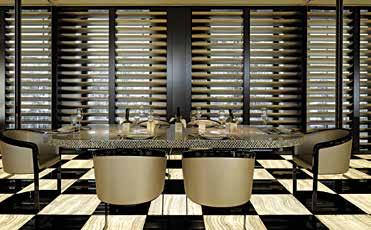
Sometimes it is worth paying more to pamper yourself and enjoy the world of fashion and design with a Bvlgari cocktail in your hand.
A table in the yard is particularly enjoyable.
Via Privata Fratelli Gabba 7/6 (District: Brera); Price: 530€.
COMMENTS:
See pink flamingoes at the Villa Invernizzi’s garden. While the villa is private property, you can negotiate with the courtier to let you in for a couple of minutes to see the amazing secret garden where these wonderful creatures live. Corner of via Cappuccini 7 and via Vivaio.
If you would like to feel like a real Milanese, you should go to the San Siro stadium, especially to a match between A. C. Milan and Inter Milan.
PALAZZO SEGRETI
Via San Tomaso 8 (District: Duomo); Price starting at 220€. Designer delux
SPADARI AL DUOMO Via Spadari 11 (District: Duomo); Price starting at 310€. Style: 80s chic

THE GRAY Via San Raffael 6 (District: Duomo); Price starting at 280€. Contemporary.
HOTEL MANZONI Via Santo Spirito 20 (District: Montenapoleone); Price starting at 295€. Classic.
16 Things, to Do in Milan
If you consider Milan to be the world’s design capital, visit the city’s Golden Square at Via Montenapoleone and the high-fashion shops at adjoining streets (Via San't Andrea, via della Spiga, via Manzoni).
Men should visit Antica Barbiera Colla di Franco Bompieri for a high-class Milanese-style shave. Via Gerolamo Morone 3.

Walk to Armani Silos at the Georgio Armani museum to see how his mind works. Via Bergognone 40. Closed on Sundays.
Think about the values common to mankind while you are observing the gold-covered building of Fondazione Prada 39K (Architect: Rem Koolhaas) while drinking a coffee at the famous bar Luce, decorated by Wes Anderson. Via Largo Isarco 2. Closed on Thursdays.

If you consider Milan to be the world’s fashion capital, where art, refined taste and industrial opportunities merge seamlessly, then you could visit Palazzo del'Arte Triennale museum. When exiting, do not forget to see the legendary strange sculptures by Giorgio De Chirico in the garden.

Women may wish to buy a pair of Porceli ballerina shoes.
Take a walk to the Navigli canal district, which was created artificially in the XII century. It was improved technically and architecturally by Leonardo da Vinci at the behest of the Duke of Milan in the XV century. The district is full of small, interesting restaurants and shops.

Strolling through the Corso Vittorio Emannuele towards Duomo, look up at the arches and try to find one of the symbols of Milan: the III century bas-relief l'Omm de Preja (Stone Man). Bow for good luck and out of respect, especially if you agree with the inscription "Deve essere privo di ogni colpi chi è pronto a dire contro altri" (“only an innocent person can judge another").


If it’s a Saturday, be sure to wake up early and visit via le Papiniano market/bazaar. If it’s a Sunday, visit the flea market at piazzale Vincenzo Cuoco to see quintessential kitsch. Who knows what treasures you may find in the chaos..
3/2016
See the Palazzo Sola-Busca at via Serbelloni 10. The building is shaped like a human ear, hence it is named the Ear House.

Going to La Scala and listening to Italian opera is amazing, even if just to drink a glass of sparkling wine in the most beautiful interior and enjoy hearing the well-known soloists.

30 VOYAGER
If you want to be really Milanese, you should respect the ‘aperitivo’ tradition and visit one of the city’s famous bars at 17:00-18:30 (before dinner), join the locals, order Negroni or Aperol Spritz, or simply any local wine (when you buy alcohol, you get mini-sandwiches for free) and enjoy the musical Italian language. To experience ‘aperitivo’, we present a list of the best Milanese bars.

BAR BASSO
This is the city’s oldest and most elegant bar, where the waiters wear white gloves. An historical event took place here in 1947: the Negroni Sbagliato (Mistaken Nergoni) cocktail was created when proprietor Mirko Stoketo accidently mixed prosecco with Negroni instead of with gin.
The bar is always filled with elegant Milanese bourgeoisie. It is the quintessence of class. Open: 9:00-01:00.
Via Plinio 39 (Viale Abruzzo)
MAG CAFÈ
Mag Café is the most distinguished of the world-famous Navighli Canal District’s bars. Its owner, Marco Russo, has elevated mixology (the art of cocktail-making) to a new level.
Try to learn his secrets from the barman. This speakeasy is hard to access. A password may be obtained from a friendly barmen or influential friends.
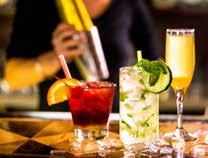




Business hours: 19:30-01:30.
Ripa di Porta Ticinese 43 (Navigli)
PAVÈ
Famous pasticceria where you can have a cocktail Milano-Turino.
Via Felice Gasati 27
Try traditional Milanese meals:
- Risotto alla Milanese (a wonderful risotto with saffron) at Ratanà; Via Gaetano de Castilia 28
- Cotoleta Alla Milanese (resembles schnitzel) at Nuovo Macello;
Via Cesare Lamroso 20
- Minestroni (classical Italian soup) at Refettorio Simplicitas; Via della Moscova 24
- Crudaiola (pasta with tomatoes, ricotta cheese and basil) at Lateria San Marco; Via San Marco 24
- Michette (sandwich with Italian sausage) Taglio; Via Vigevano 10.
AL CAMPARINO
CERESIO 7
This bar is located above the main office of famous fashion house Dsquared2; it has been astonishingly popular since 2012. Despite its high prices, you will enjoy a 360 degree view of Milan, interesting people and the amazing New Aviation cocktail. Open: 12:30-01:00.
Via Ceresio 7 (Porta Volta)
REBELOT
Mixologist Oskar Quagliarini takes his job seriously. Thus, before ordering, you should learn his menu well. Our advice is to taste the famous Oscar 697. In addition to cocktails, the bar offers an amazing range of traditional wines. Open: 18:00-02:00. Closed on Thursdays.
Ripa di Porta Ticinese 55 (Navigli)
GARRY'S BAR
This decadent, classic bar is located in an historical hotel and attracts guests from various countries; it is famous for its classic and high-quality drinks. Hotel Et De Milan, via Alessandro Manzoni 29 (Montenapoleone)
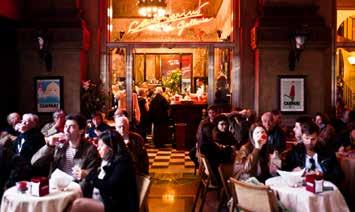

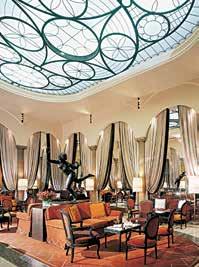
This pleasant bar is located inside Galleria Vittorio Emanuele. It was opened in 1867 by Gaspar Campari. It was Initially a restaurant and wine cellar. In 1915 it was named Camparino Bar. It is considered to be an integral part of Italian culture. Verdi, Boito and Puccini came here to rest after their La Scala performances. Umberto I, king of Italy and Edward VII, king of the United Kingdom, drank at this bar.
Camparino was always the best place for bohemian artistic gatherings. The bar counter is made of redwood, lights and mosaic – all are works of famous Italian masters of that time.
The Piazza Duomo 21
If you still feel energetic and don’t want to go back to the hotel, join the Milanese during the night hours: Colònne di San Lorenzo –sit on the pavement, have something in a plastic glass and remember the happy times of college.
Carlo Ponte; Via Granelli 1
Sacrestia-Farmacia
Alcolica; Via Conchetta 20
Magnolia; Via Circonvallazione Idroscalo 41

Plastic; Via Gargano 15

31 VOYAGER 3/2016
BARS / MILAN
GELATO, GELATO, GELATO!
Be daring and try the unusual, non-traditional flavors of Milan's best ice-cream shops:
- I GELATI DI NANINA
(Via Vicenzo Foppa 52). Lemon and basil or Mojito.
- GELATERI PAGANELLI (Via Gustavo Fava 14). Grape sorbet: Cabernet or South Tuscan Muscat.
- LA BOTEGA DEL GELATO (Vvia Pergolesi 3). Exotic fruits: Chinese mandarin or dragon fruit.
- MARGHERA
(Via Marghera 33). Milanese legendary ice-cream shop.
- VENCHI (piazza dei Mercanti 21). Quintessential chocolate ice-cream; you can eat in the central railway station and the airport's duty free zone.
PIZZERIA DA GEPPO
I claim with full responsibility that this small pizzeria, located away from the center of Milan, makes the world's best pizza.
People cross continents to taste it. They also have a delivery service. Please check the operating hours before visiting.
Via Giovanni Battista Morgagni 37
COVA
Napoleon’s soldier, Antonio Covano, opened a pastry shop near La Scala in 1817. It has hosted balls and parties since the XIX century.
It has been visited by politicians and representatives of the cultural beau monde, including Garibaldi and Hemingway, who often mentioned this café in his work. Elegance and refinement are the main assets of this cafe-bakery.

Via Montenapoleone 8
AL GIN ROSA
This is considered to be one of Milan’s historic cafes. It was called the "Lion’s Basement" when it first opened in 1860, in the "Venetian Palace", on the Piazza San Babila. The new owner (the company Gin Rosa) combined the place’s "old spirit" with modern services in 1999. "Rose Gin" and "Donini Miture" mixed according to the old recipes remain its signature cocktails.
Galleria San Babila
YOSHI
The former sushi chef at Milan’s Nobu restaurant wakes up early in the morning to bring hand-chosen fish from the market. None of these fish are caught during spawning times; each of them is instead caught with a pole rather than a net. His work environment shines with cleanliness and creates a cozy feeling. A special Japanese atmosphere is created with yellowish light reflected from the screen-partition; the interior is decorated with colorful bouquets selected by Yoshi. Price: starting at €40-50.
Via Giuseppe Parini 7
CUCCHI
Cucchi has the vintage atmosphere of old Milan through its interior and its furniture; this cafe-bakery opened in 1928. In the 1930s it became Milan's first cafe-chantant, and foreign artists from around the world performed here.
Cake "Saint Honore" is its main dessert, especially since it was admired by the filmmaker Gabriele Salvatore and philosopher Franco Boleli.
Corso Genova 1
COMMENT:
I recommend having at least one breakfast of cappuccino and brioche (local croissant) in the city's legendary cafe and, like a true Milanese, order a drink at the bar counter:
CAFFÈ MARCHESI ; Via Santa Maria alla Porta 11
CAFFÈ SISSI ; The Piazza Risorgimento 4
CAFFÈ SCARINGI ; Via Pacini 15

CAFFÈ BASTIANELLO ; Via Borgogna 5
OBICÀ MOZZARELLA BAR
This Italian appetizer restaurant offers the best Mozzarellas di Bufala Campana. Also, it offers traditional Italian dishes and products that are made in front of the customer, just like in the best sushi bars. Its continuously updated menu relies on fresh produce.


Carlo Petrini’s Slow Food philosophy became a way of life. It expresses unwavering respect for the local traditions.
Price starting at €30.
Via Mercato 28, Milano
32 VOYAGER 3/2016
PEPPINO
BAGUTTA
Peppino has retained its timeless quality since 1950. Try Paker (a type of pasta) with tuna and oregano sauce or fish antipasto misto. Price: starting at €50; Closed Sundays and August.
Via Durini 7 (San Babila)
PISACCO
Chef Andrea Bertoni and architect Tiziano Vudapieri’s concept turned Solferino street into one of Milan’s most fashionable streets (the Dry Bar and Pizzeria owned by the same group is located in front of the restaurant). The restaurant is always full. Sample their fried chicken and the oven-roasted potatoes. The atmosphere is informal and lively.
Price: starting at €35. Open: 12:00-15:00/ 19:00-01:00; closed on Mondays.
Via Solferino 48 (Brera)
PESCETTO
Fish lovers are presented with a unique opportunity to select the morning catch at the counter and order dish prepared according to their own taste.
Via Alessandro Volta 9 (Brera)
LANGOSTERIA
10
Connoisseurs of lobsters, crabs and other seafood will find a real treat. Price per person: starting at €80. Open: 19:00-24:00.
Via Savona 10 (Porta Genova, Navigli)
TRATTORIA MADONNINA
This is one of the oldest trattoria in Milan, open since 1782. Outstanding dishes: risotto giallo (yellow risotto), pasta al ragu, polpetone. Open: 12:30-14:30/20:00-23:00.

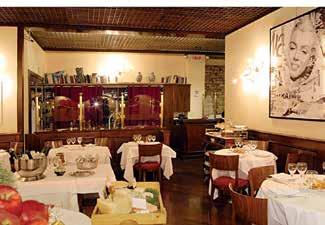
Via Gentilino 4 (Navigli)
This is a classic Milanese restaurant with a rich collection of paintings. The building was named as a historical monument in 1991. It is located on the so-called Milan’s Gold Square and is the only restaurant open for business all day long. It is usually full of a high-fash-

ion industry representatives. The restaurant offers legendary osso buco milaneze.
Price: starting at €45. Closed on Sundays.
Via Bagitta 14 (San Babila, Montenapoleone)
TRUSSARDI ALLA SCALLA
Chef Luigi Taglienti turned this place into one of the best gourmet restaurants. Its unexpected menu is inspired by street food: lamb with traditional yogurt sauce, veal or shrimp burgers.
The best seats are by the windows facing "La Scala". Sip Coffee on the first-floor cafe, in

the shade of the legendary Patrick Blanc vertical garden.
Price: starting at €40. Open: 12:30-14:30/ 20:00-22:30. The restaurant is on the second floor (the café is located on the first).
The Piazza della Scalla 5 (La Scalla)
EAT'S BISTRO EXCELSIOR
A gourmet supermarket located on the ground floor of a mall designed by the architect Jean Le Nouvel. Here you can buy high-quality produce and also taste food at the bistro (featuring a wide variety of meat and pasta). The bistro is ideal for a quick snack while shopping.

Price per person: starting at €40. Open: 10:00-22:00, no break.
Galleria Del Corso 4 (Behind Duomo)
EATALY MILANO

Italian gourmet Mecca, located in Italy's major cities ,where visitors buy the producepasta, fish or meat - and taste it on spot (the shopping center in the upper floors).
Excellent for a quick snack.
Open: 10:00-24:00.
The Piazza XXV Aprile 10
33 VOYAGER 3/2016 CAFES / RESTAURANTS / MILAN
This small yard was totally different ten years ago. A garage, a fruit shed and Italian designer Romeo Giles' workshop neighbored in perfect unison. Franka Sozzani came for visit. She soon realized that this would be the perfect space to open the Photo Gallery – a rare event in Milan at the time. Franka had worked on Vogue magazine’s editorial board for 10 years and was well acquainted with all of the photographers and the fashion of the region. She opened her gallery with an exhibition of Louise Dahl Wolf, an unknown photog-
10 CORSO COMO

This conceptual space became legendary initially. Its sophisticated and unique tasteful clothes, shoes and accessories are guaranteed to put you at the forefront of fashion trends.
Go up to the second floor of the gallery, learn about art in addition to the design, then sit in the famed café in the courtyard, take a Negroni cocktail in your hand, and like a true
BIFFI
This Boutique offers high fashion Italian and international designer clothes and shoes.





Corso Genova 6
CAVALLI E NASTRI
This famous vintage clothing and accessories shops offers you select clothing apparel and a unique collection of accessories, including different models of the 1920-1980 period.
Young fashion designers and new models are also presented.
Via Brera 2 (Brera)
EXCELSOR
This avant-garde designer shopping mall showcases the following designers: VALENTINO, JIMMY CHOO, PIERRE HARDY, SOPHIA WEBSTER, Bags by GIVENCHY, PROENZA SCHOULER, CHLOÉ, JIL SANDER, MANOLO BLAHNIK-'s shoes and accessories. HELMUT LANG, THEORY, RAG & BONE AND ALICE + OLIVIA clothing collections , MARIO PORTOLANO, RODA,NO KA 'OI-'s Sportswear.
Galleria del Corso 4 (Duomo)
PORSELLI
The world-famous handmade "Ballerina" shoes for women are sold here. This Italian dance shoe became a distinctive brand in 1919. The name comes from the Milan-based company owner, Eugenio Porselli. Immaculately selected raw materials and

rapher who reached amazing success. She and her partner, Chris Rose, who created lights, tables and flower pots, soon realized the possibilities that this place presented. A fashionable clothing store and a bookstore replaced the garage and fruit shed. Here you could find clothes not available anywhere else in Milan. Soon a café was added due to the popular demand.
Milanese intellectual, severely criticize everything you see. Open: 10:30-19:30.
Corso como 10 (Porta Nuova)
BORSALINO
Here you can find the most beautiful handmade stylish hats for any season.
Borsalino is a hat-lover’s paradise: here, you can choose from world-famous designer hats of any shape, material or pattern.

Galleria Vittorio Emanuele II (Duomo)
unique sewing methods, and the direct relationship between the dance world, make Porcelli shoes indispensable to the world of ballet. Anyone who has worn them acknowledges their superiority.
34 VOYAGER 3/2016
The Piazza Paolo Ferrari 6 (Brera)
CAMICERIA PICCOLO
This company has made shirts since 1926, using only the highest-quality fabrics. It is an unconditional leader in this field. It offers its clients many unusual features, for example, the best products will be made according to your taste.

Open: 10:30-19:30; Mondays 15:30-19:30; Closed on Sundays.
Via Mercato 3 (Brera)
CARACENI
Unique Italian-style men's business suits are made in this shop. If you want to buy a suit, you need to call in advance (recommended to use the hotel concierge service).
RIVOLTA
Men’s shoes have been made here since 1883. The brand offers handmade Italian shoes and accessories. The shop takes individual orders and also offers ready-made items for women and men.

Rivolta shoe soles are unmistakable symbols of the Milanese brand, hand-processed and sturdy.
Via della Spiga 17 (Montenapoleone)
Each suit is handmade, adhering to the skill passed from generation to generation. In this way, the proprietors keep the craft alive – a craft which is in high demand.
Open: 9:00-12:30/15:00-18:30; closed on weekends.
Via Fatebenefratelli 16 (Brera), (Montenapoleone)
RUBINACCI
A legendary tailoring shop for elegant men's clothing in the Neapolitan style.

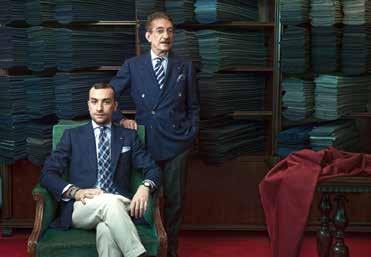



Open: 10: 00-19: 00; Closed on Sundays.
Via del Gesù 1
ALFONSO
Open: 8:00-12:30/14:00-19:00; Closed on Sundays and Mondays.
via Cesare Battisti 8
BULLFROG
Hair salon for men.
Open: 10:00-20:00; Closed on Sundays and Mondays.
Via Thaon de Ravel 3 (Isola)
PROFUMO

You can purchase high-end perfumes here: Aedes de Venustas, Al Haramain, ALTAIA, Eau d'Italie, Frederic Malle, Jovoy, Le Galion, Le Labo, Les Merveilles, and Keiko Mecheri. Open: 10:00-19:00.
Via Brera 6 (Brera)
DAAD DANTONE
A leading international brand shop: 10 Sei 0 Otto; 11 by BBS; ADIDAS by Raf Simons; Comme Des Garcons fragrance; David Koma; Emanuele Bicocchi; Escentric Molecules; Fagassent; First aid to the enjure; Gareth Pugh; If 6 was 9; Ilaria Nistri; Isabel Benenato.
Via Santo Spirito 24A (Montenapoleone)
COMENTS:
Do not plan to shop in Milan on a Monday until 15:30. Every city in Italy has its own working hours: most restaurants in Florence are closed on Sundays, and ice-cream shops on Mondays. No grocery store is open on a Wednesday evening in Bologna. Ferrara dwellers eat at home on Thursdays; restaurants are closed.
35 VOYAGER 3/2016 SHOPPING / MILAN
VILLA NECCHI CAMPIGLIO
Villa was built by the architect Piero Portaluppi, a successful entrepreneur, between 1932 and 1935, on the orders of the Angelo Campiglio family. This palace is a symbol of the beginning of rationalism in modern architecture and is emblematic of a style fashionable in Milan in the 1930s. Visit this period masterpiece if you are an Art Deco fan. It is a house of amazing beauty, which consists of XX-century paintings, sculptures and furniture.
Villa Necchi Campiglio transports you to last-century Milan. You will find yourself in the bourgeois high society atmosphere of luxury with beautiful gardens, a pool and tennis courts. Magnificent examples of XVIII-century decorative art adorn the house. Tilda Swinton’s character in the Luca Guadagnino cult film "I am Love" lived in this very house. Open Tuesdays through Sundays from 10:00-18:00.
Via Mozart 14
PALAZZO MORANDO ATTENDOLO BOLOGNINI
This palace allows you to know Milan in the XVII-XIX centuries through works of art and an impressive collection of clothing. Learn how the aristocracy lived in Milan and how the palazzo looks from the inside. Here you can find rare fabrics, clothing and accessories.



The exhibition tells the story of the history of Milan, through XVII-XIX-century art and esthetic icons. Giuseppe Canela, Angelo Ignano and XIX-century masters’ paintings with landscapes of Milan, and applied arts (bronze, maiolika) are exhibited here.

Open Tuesday through Sundays from 9: 00-13: 00, 14:00-17: 30.

Via Sain't Andrea 6
MUSEO POLDI PEZZOLI
This typical XIX-century house houses Gian Giacomo Poldi Pezzoli’s (1822-1879) impressive personal art collection. It is exemplary of Milan's neoclassical architecture. The aristocrat passionately collected paintings, sculptures, weapons, porcelain, glass, textiles, watches and jewelry. Gian Giacomo decorated different halls with various artistic styles of the past: the Middle Ages, early Renaissance, Baroque, Rococo; the best artists of the time painted the walls.
Poldi Pezzoli owned one of Europe’s finest collections of art: his home boasts a Gothic cabinet; a Murano glass hall; an arms room; a rich collection of paintings including works of Botticelli ( "Portrait of a Woman", "the Cross of Christ"), Bellini and Piero de la Francesca; amazing mechanical and solar watches; and the world's oldest, XVI-century Persian carpet. Open weekdays from 10:00-18:00.
Alessandro Manzoni 12
MUSEO BAGATTI VALSECCHI

This XV-XVI-century neo-Renaissance house exhibits a rich collection of interesting works of art. It was the weakness of the Milanese barons, Bagatti Valsecchi brothers, although they sought novelties too (they were among the first users of the bicycle and the hot air balloon).
The brothers turned into collectors’ targets. Nowadays, this residence is among Europe's best-preserved palaces. It includes valuable XVI-century items, a fireplace collection, paintings (including the work of Giovanni Bellini) and a military armor collection. Visit the beautiful museum to enjoy its painted halls as well.
Open Wednesday to Mondays from 13: 00-17: 45.
Via Gesù 5
36 VOYAGER 3/2016
MUSEUMS / MILAN
Via



ITALY - PASTA COUNTRY
Pasta is the national pride in every corner of Italy. It originated near Napoli during the Roman Empire and by the Middle Ages was found outside the country. Diverse pastas are made from the various varieties of wheat, each of them with a particular shape and paired with the respective sauces.
You can enjoy ravioli, tortellini, spaghetti, atria, lasagne, and other varieties with delicious fillings or sauces in any part of Italy. The choice is diverse (from seafood to vegetarian sauces) and can satisfy even the most gourmet taste.
Graniano pasta of Naples is considered the oldest variety. Mills and bakeries have been traced to ancient times in this region, and by the 19th century there were 70 factories preparing pasta products. In 1845 when the king of Naples, Ferdinand II, decreed that royal kitchens should be supplied with local spaghetti, Graniano was recognized as the capital of spaghetti.
A la Norma with tomatoes, garlic, olive oil and basil is the best known Sicilian pasta. Sicily is also known for its black spaghetti made with cuttlefish ink and pasta prepared with sardines.
Malloreddus is a distinguished Sardinian product. Made from small atria, its most common type is a la Campidanese, with tomato and saffron or a poultry sauce. Culurgiones is a delicious type of ravioli. Lorighittas, on the other hand, look like a golden chain and are created using a complex technique.
In Vallegio they make a delicious tortellini with silk thin dough and meat. The local tortellini reminds one of a folded handkerchief. It is served with bouillon or with butter and Parmesan cheese.
In September 2002, Italians celebrated 500 years of spaghetti. Genoa is thought to be the birthplace of spaghetti. A pasta museum in Pontedassio near Genoa exhibits hundreds of recipes for pasta sauces and dressings. A notarial act from the Genoa archives, dated February 4, 1279, is kept in the museum, and confirms the existence of a culinary dish made of dough named "Macaroni".
Some 176 varieties of pasta are displayed in the spaghetti museum. The Italian word spaghetti denotes a strictly defined pasta type, 35-40 cm long and 0.7-0.9 mm thick. All the other varieties have names of their own based on their form, color and origin.


Let’s name just a few of the Graniano collection: bavette, bigoli, bucatini, busiata, conchigliette, ditalini (the fingers), farfalle (butterflies), farfalette, fettuccine, fusilli, fuzi, garganelli, linguine, lumaconi (large snails), macaroncelli, macaroni, magliette, malloreddus, maltagliati (roughly cut), marille, orecchiette (ears), paglia (straw), pappardelle, penne (wings), pennette, pipe, rigatoni, route (wheels), sedanini, spagetti, stracci pasta, tagliatelle, taglierini, tagliolini, trofie, tubetti, vermicelli.
Sauce is paramount – there are more than 10,000 varieties. Creating dressings for pastas is one of the most respected disciplines in Italy. Each of the 20 regions in the country boasts its own sauce. Virtually everything that is edible (and sometimes even the things that are not, like seafood shells) can contribute to a sauce. In Sicily and Sardinia, you will find fish, calamari, mollusks, crabs, lobster and cuttlefish on the plate next to your pasta.
It is said that genuine Italian spaghetti does not cause weight gain as the wheat varieties that the spaghetti is made of do not contribute to fat accumulation. However, renowned opera singer Luciano Pavarotti once had to go on a strict diet replacing spaghetti with salads, meat with fish, and wine with water, losing 42 kilos in the process.
In Italy they believe that if a man cannot eat a sizable portion of pasta, he won’t be able to perform well in bed.
In recent years, life expectancy has been on a steady rise in Italy. According to WHO (World Health Organization) Italy is ranked 5th place by life expectancy in the world: average life expectancy for women is 85 years and for men it is 80.2 years (based on 2015 data). It is possible that Italians’ world-renowned cuisine along with their cheerful and optimistic attitude has a positive impact on their vitality.
GASTRONOMY

RISOTTO MILANESE
There’s a fun story about the origin of this dish. It was an experiment by an eccentric artist: in 1574 he decided to add saffron to a regular risotto. Thus, he colored the rice yellow.

The dish is made of simple ingredients that create an exquisite taste: onion browned in olive oil and butter, rice soaked in white wine and cooked in beef bouillon, butter, parmesan and saffron.
The dish is coated with honey before serving.
CAPRESE SALAD
Caprese is one of the easiest Italian salads to make. The ideal caprese consists of Capri tomatoes and fresh mozzarella.

Cut tomatoes and mozzarella are plated and sprinkled with olive oil and oregano.
Panino caprese is a variety of this dish, the difference being that fresh-baked bread is used as a plate for the above-mentioned ingredients. Caprese is great to take to the seashore or on a picnic.
MINESTRONE

Vegetables used vary according to the season. The dish may include: cereals, different types of lettuce, beats, celery, carrot, potato, spinach and fennel.

The term minestrone was not included in the 1858 Italian Language Dictionary, as it was only used in Milan.
However, it became famous in Europe after Pellegrino Artusi, a historian and writer, incorporated it in his culinary book.
OSSO BUCO
The cross-cut veal shanks braised with vegetables are often served on a bed of Milanese risotto. A teaspoon or special little spoon is used to scoop the delicious marrow. The first recipe for this dish can be found in 17th-century cookbooks. Later on, new techniques were added. The meat on the bone is covered with flour before stewing and a mix of garlic, parsley and lemon zest are added later. This gives the dish its unique taste, smell and color. Green peas, carrots, beans, mashed potatoes or polenta are often used as a garnish. Osso Buco may also be served with fried ham.
LASAGNA
This flat, square pasta dish is an integral part of Italian cuisine. It is made with different sauces, minced meat, tomatoes, spinach, vegetables and parmesan.
The first lasagne was made in Emilia-Romagna; it is now popular all over the world.

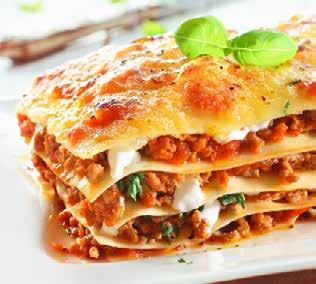
Sometimes pesto or spinach is added to the traditional lasagne in different parts of Italy. Lasagne dough, like any pasta dough, is made from a particular type of wheat.
BREADED VEAL
This is one of the oldest local dishes. Austrians also claim it (Vienna Schnitzel), though lumbulus cum panitio was first mentioned in an 1148 document which is kept in the Sant'Ambrogio basilica.
Veal is placed in eggs and then coated with bread crumbs. It is fried in butter and tastes delicious.
BOLLITO MISTO
This is a traditional Piedmont dish. It is made of different meats that are sliced and placed in boiling water with onions, parsley and carrots. Bollito Misto always contains bay leaf, rosemary, garlic, salt and pepper.

42 VOYAGER 3/2016
FLORENTINE STEAK
This delicious steak is made in Florence with Tuscan beef. Sections of the T-bone (5-6 cm long) of a young cow, aged 2 years, are used. The cut places the bone in the middle.
Florentine steak does not have fatty parts. Portions are pretty big – 800-1,500 grams. Only oak or olive wood is used for the grill, as the smoke gives a special aroma.

The steak is neither marinated nor seasoned before cooking. After grilling, it’s sprinkled with salt, pepper and olive oil. Italians enjoy this dish with no garnish, just bread and red wine. You can choose how you like it: from rare to very well done.
ARANCINI
Arancini or Suppli is an Italian appetizer that may be served hot or cold. Suppli was created in Lazio, while Arancini originated in Sicily.
Arancini used to be shaped like a cone after Mount Vesuvius. The filling was made with ground chicken. Today Arancini is rounded and usually includes mozzarella filling (Suppli). Hot cheese gets stretched like a phone wire, hence the nickname - al Telephone.

Leftover risotto is often used to make this appetizer. The rice is flattened into sheets and the filling is added. It then gets smothered in egg and flour and fried in olive oil.
FRITTO MISTO
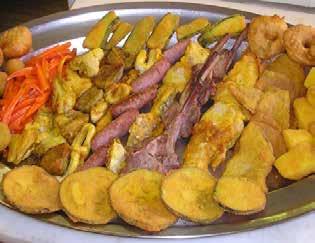
This old dish originated at the time when animals were slaughtered at home; to minimize the loss, animal entrails were cooked also. Fritto Misto is made from heart and liver and is reminiscent of Kaurma, an eastern dish.
While Italians enjoy Fritto Misto in the fall and on winter holidays, it can be cooked anytime, with the exception of hot summer days.
PESTO
Pesto is one of Italy’s gastronomic symbols. Basil leaves are the main ingredient of this sauce. It includes crushed cedar nuts, garlic, Parmesan cheese and olive oil. Walnuts are sometimes added as well.
Sauce retains its fresh taste for a long time and is healthy.
ZUCCHINI
Crunchy, salty and delicious – pairs well with aperitifs like bellini or negroni.
Botanically speaking, zucchini is a fruit, though it is often used as a vegetable in the culinary world. It is one of the easiest crops to harvest, as it thrives in moderate temperatures and requires no special care. The only difficulty is choosing when to harvest zucchini flowers. The male flowers have long stems and the female ones short stems.
Zucchini contains more potassium than a banana.
Zucchini flowers include many vitamins and minerals, such as zinc, magnesium,


manganese, potassium, copper and calcium. The flower tincture can help in losing weight.
Zucchini is used in many culinary endeavors: zucchini flower pie with risotto filling; fried zucchini; risotto with zucchini; zucchini flower tempura.
It originated in ancient Rome. Virgil describes a pesto-like sauce – morerum. The first official recipe is included in Giovanni Battista Ratto’s cookbook from 1865.
Italian cuisine - pastas, salads, soupsare hard to imagine without this sauce. It can be added to any dish or enjoyed as a spread.

43 VOYAGER 3/2016 GASTRONOMY
BRESAOLA
This meat is smoked using alpine techniques and has a very particular flavor. Elastic Bresaola has a sour taste. Only certain beef cuts are used. It is seasoned, placed in casings and dried for four weeks.

Try thin-cut bresaola with no garnish to appreciate its unique taste.
PROSCIUTTO
Production of this wonderful ham is strictly controlled: it has to weigh no more than 160 kg. The pig’s diet has to contain milk, corn and fruit only. This is how Parma ham is made; it produces pink meat with neat white fat threads. It is cooled for 10-12 days after seasoning.
Try prosciutto as an appetizer; order it with white bread or figs.

LARDO
Salted pork fat from Colonnata is a Northern Tuscan delicacy. Pork fat is covered with a thick layer of salt, garlic, rosemary and black pepper; it is placed in a marble container that is carefully locked and kept in a mountain cave or underground cellar. Local white marble was used for statues and pillars for centuries. Presently, lardo is a calling card of this small mountain town.
NDUJA
Vibo Valentia is the capital of Calabrian salami. Nduja is made from a minced seasoned pork throat and fat. It is dried, salted, encased and stored in wooden barrels. It is then smoked for several days. This soft, aromatic, red delicacy is a gourmet favorite. Enjoy it spread on a warm bread with a bit of olive oil.
PEPERONI
The precursor to peperoni was prepared in the Roman Empire: soldiers carried dry pork meat with hot pepper.
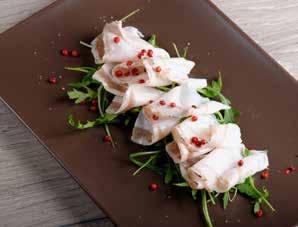
Peperoni means hot pepper. This salami originated in South Italy from the Neapolitan-Calabrian hot smoked sausage.
Peperoni is used in pizza alla diavola, sandwiches and as a cold appetizer. It pairs well with cheese and vegetables.
PROSCIUTTO DI SAN DANIELE
San Daniele ham is made according to hunting and meat-keeping traditions. The demand for this ham is so high that it is currently not produced exclusively from the Sicilia black swine. It is salted only with sea salt. After pressing, the fat moves towards the outside. The meat is dried on wooden shelves for three months. It is served with garlic and figs in the summer, and white sauce in the winter.
MORTADELLA
Bolognese sausage is made of ground pork meat and fat, sometimes mixed with beef, veal, mutton meat or entrails. The seasoning includes pepper, garlic and wine. Myrtle berry is the main ingredient of classic Mortadella.
CULATELLO
Prince Albert of Monaco, Bill Clinton and Giorgio Armani are connoisseurs of this ham. It is made of pig's rear leg. The meat is cured with salt, white wine with garlic, black pepper and spices.
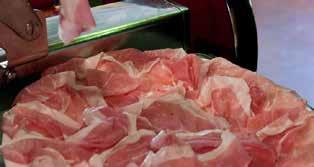
It is stored in a cool place for several days; spices are rubbed during storage.

The meat is then placed in a pig’s bladder soaked in vinegar and hung on the ceiling of a damp cellar.
Culatello is wrapped in a white-winesoaked cloth before serving, to make the skin softer.
44 VOYAGER 3/2016
GRANA PADANO
This North Italian traditional cheese is made of cow’s milk; the cow’s diet is strictly regulated. Cows may be milked only twice in 24 hours. New cheese tastes sweet, while aged cheese has a more saturated aroma. The cheese receives two stamps during production as a quality guarantee. It has a special passport that indicates province and the production code. The whole cheese is covered with the writing. Padania is the only place allowed to produce it.
PARMIGIANO-REGGIANO


Authentic parmigiano (parmesan) is different from any imitation. Its production is strictly regulated. It may be produced only in a specified territory. It is handmade and includes natural ingredients and unskimmed milk. 16 liters of milk make 1 kg of parmesan. One wheel of cheese weighs around 30 kg. It is cut with a special knife and served as an appetizer. It is often enjoyed with balsamic vinegar, cherry tomato or celery.
FONTINA VAL D'AOSTA
This cheese is made from Val d’Aosta mountain-grazed cow’s milk. The milk has to make it to a farm two hours after extraction. The cheese is kept in a damp and cool place for 3-6 months.
Aged cheese has a yellow color and sweet taste. The product receives one stamp with an image of the Matterhorn mountain. If a cheese does not have this stamp, then it is not a Fontina.


PECORINO
This goat cheese is the most famous Sardinian cheese.


Two varieties are offered: sweet and soft (indicated as "dolce" or "fresco") and hard ("mature" or "stagionato").
Sweet Pecorino is a typical table cheese, white, soft, elastic and aromatic. Pecorino Sardo Maturo is a sweet table cheese, yellow, hard and grainy.
BURRATA
Burrata is a fresh Italian cheese made from mozzarella and cream. It looks like mozzarella and the filling has a cream consistency.

Cows or buffaloes grown in South Italy produce milk that may be kept no longer than 16 hours. The cheese is porcelain white. It has a unique delicate taste.
ASIAGO
Asiago cheese is made of unskimmed milk. There are two types:
1. New cheese that matures for 40 days. It has an elastic yellow rind, a sweet taste and smells like fresh milk.
2. Aged cheese that matures for 2 years. It has a golden flexible rind, with a soft, holey part underneath. It has a stronger flavor.
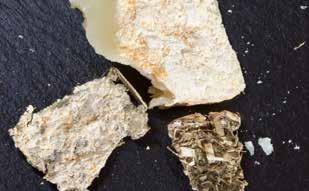
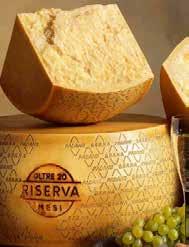
GORGONZOLA
Gorgonzola is a soft cheese made from unskimmed cow's milk. It is covered with inedible grey-pink rind, which coats soft white and blue-green cheese mass. The cheese saved its namesake village during WWII. Winston Churchill loved the cheese and therefore prohibited bombing of the village. Gorgonzola production then spread to Lombardy and Piedmont. It pairs well with red wine.
45 VOYAGER 3/2016 GASTRONOMY
CACIO E PEPE

This is the most famous Roman first course dish (served after antipasti appetizers). The ingredients include pepper and pecorino cheese.
This delicious sauce is easy to cook but difficult to execute perfectly, since an ideal balance must be struck between being too thick and too watery.
TRIPE
This dish is made of beef entrails. Sometimes it is served as a soup. Minced entrails, mixed with a tomato sauce, mint and pecorino cheese were prepared in ancient times. Like the Georgian Khashi dish, it is washed for several hours. Then the entrails are seasoned and simmered with oil and wine. Parmesan cheese is added at the end.

BRUSCHETTA
Bread has been important in Rome since ancient times. Eating food with bread (excluding pastas) is customary in Italy. Bruschetta is a popular snack –it consists of toast rubbed with garlic, topped with freshly chopped tomatoes, olive oil, salt and pepper.

LA CODA ALLA VACCINARA
This dish is made from braised oxtails, just like in the ancient Rome. After the wealthy ate the best pieces of meat, the poor were served this so-called "fifth part" - quinto quarto.

La Coda is a difficult dish to execute: preparation time is long and it uses many spices. Wine pairing is important too: aged wines from the same regions are preferred to provide the best taste and aroma.
CARBONARA
Carbonara contains eggs, pecorino cheese, roasted ham and pepper. There are several stories about the origins of this dish. According to one version, housewives created it for mine workers to provide them with a nutritious meal for the long work hours.

According to another story, the dish was created during WWII. Rome was on the verge of starvation and housewives had to use dry produce provided by foreign soldiers. They mixed "American breakfast" (bacon and eggs) with Italian pasta. This ideal recipe became world famous.
AMATRICIANA
While this sauce originated in Amatrice, it was adopted by Rome. Amatriciana sauce is made of guanciale, a cured meat product prepared from pork jowl or cheeks, olive oil, garlic and pepperoni. The sauce is usually served with spaghetti, rigatoni or bucatini pasta.
THE JEWISH-ROMAN CUISINE

Jewish people have lived in Rome for more than two millennia and in that time a tradition of mixing these two wonderful cuisines has established itself. Many Italian dishes are prepared alla giudìa (in the Jewish style). It is best to taste Jewish-Roman food in the former ghetto territories.
The Jewish artichoke dish is one of the best delicacies. Also, try Groats atria which is fried in olive oil and baked with parmesan. Fish soup with broccoli and aromatic dishes of square-cut beef pieces are also popular.
The old ghetto is now a Jewish community center. Many restaurants are located in its narrow streets by the Marcello theatre, the synagogue and Octavian gates.

46 VOYAGER 3/2016
TRUFFLE – WHITE AND BLACK
Norcia, Umbria is the home of special black truffles. Pigs are traditionally used for the truffle harvest, as they can smell the delicacy. The mushroom usually weighs several grammes. Only the lucky find big round ones.
Its skin is black-brown, while inside is ink black with distinct white stripes. Norcia truffles have a pleasant aroma that gets more refined during cooking. Truffles give any dish an exquisite taste. Gourmets enjoy truffles with extra virgin olive oil.

Alba in Piedmont hosts an annual truffle market every October-November. The World Alba White Truffle Auction is the main event. It takes place in Grinzane Cavour Castle.

Many celebrities have appeared at the auction including baseball player Joe di Maggio, Albert Hitchcock, Alain Delon, and Gerard Depardieu.
This auction has sold very expensive truffles – a 13 truffle lot was sold for 307,200 euros in 2010. The most expensive truffles were sold for 105,000 and 100,000 euros.
OLIVE HEAVEN
Olives have been grown and oil has been produced here since I B.C. The oil was used for culinary, pharmaceutical and cosmetic purposes.

More than 60 million olive trees grow in the beautiful orchards of Italy. Some 15 of these plants are more than 100 years old, while five areseveral centuries old. The natural antioxidant present in olive oil is a symbol of health in Italy. It destroys so-called bad cholesterol.
The Taggiasca is one of the best, most precious and rare olives. It is used to make extra virgin olive oil. It is less sour, has a green-yellow coloring and a delicate, sweet, fruity flavor.
The produce and wine of Alba is also available for sale during the truffle auction.
Here you can find Langhe-Roero wines, many varieties of cheese, egg pasta, smoked meat and other culinary treasures that have made this region world famous.
THE MARKET IS OPEN ON WEEKENDS 9 A.M. - 8 P.M. AUCTION ADMISSION IS 3 EUROS.
BALSAMICO
Reduced, concentrated grape juice was used by the ancient Romans for medicinal and culinary purposes. Only the Trebbiano, Lambrusco, Sangiovese, Albana, and Montuni grape varieties are used to make balsamic vinegar.
It is stored in wooden casks for at least 50 days. Aged balsamic vinegar" is aged for more than three years. Sweet and exquisite balsamic vinegar is used in many dishes.

It is traditionally mixed with parmesan; meat, different aged cheeses, carpaccio, salads, risotto and hot soups are served with the vinegar.
Some connoisseurs like to have balsamic vinegar with strawberry ice-cream.
47 VOYAGER 3/2016 GASTRONOMY
1 KG WHITE TRUFFLE COSTS 3000 U.S. DOLLARS.
GELATO
Gelato means ice-cream in Italian and Italians are very proud of this culinary treasure. The dessert contains milk, cream and sugar, and added berries, nuts, chocolate and fruit. Gelato originated in ancient Rome and Egypt.

Famous Florentine architect and sculptor Bernardo Buontalenti was interested in cooking. He invented the first ice-cream maker in 1565: it was a big pan for mixing ingredients which were then placed in wooden casks full of salt and ice. He created a mix that is reminiscent of the modern gelato. It became known as the Florentine cream or Buontalenti ice-cream. The architect presented his invention to Katherine Medici and she took Buontalenti and his recipe to France.
The first Giolitti gelateria was opened in Rome in 1800, on via Uffici Del Vicario. It is still open. Pope John Paul II liked to eat ice-cream here. Fiordilate, chocolate ice-cream with nuts, and ice-cream with chocolate chunks are the most popular flavors.
PANETTONE
This 30 cm sweet bread loaf is a traditional holiday dessert in Milan. Raisins and citron are added to the dough which is made from the following ingredients: flour, eggs, butter and yeast.
Panettone is served with coffee, sweet wines, sparkling wine, cream, and chocolate.
AMALFI LEMON

Amalfi lemon is succulent, sweet and delicious. Lemon trees are located all over the shoreline, giving it a unique appearance. Amalfi lemon is the main ingredient of local traditional dishes and is used not only in limoncello and ice-cream, but in savory dishes that add lemon zest and sauces that include lemon juice and olive oil. Lemon leaves are often used to prepare smoked meat. Amalfi lemon makes any dish special, from soups to desserts.
LA ROSA DI GORIZIA
This is a distinctive type of red radish. Connoisseurs enjoy crunchy leaves with a bitter taste. La Rosa di Gorizia looks like a rosebud about to

CONFETTI DI SULMONA
This is a world-renowned dessert. Its production tradition comes from ancient Rome. Candies were served during weddings and birthdays, though they did not resemble modern ones.
open. Inner petals turn purple in the fall. It is stored in special conditions (cold place, at 10-15 degrees) for two weeks. The leaves have a unique flavor.
TIRAMISU
Present-day Confetti was made in Sulmona in the 15th century. The candies are little pieces of art. The traditional confetto consists of pizzuta d'avola almond dipped in several layers of sugar. Almonds may be substituted for nuts, chocolate, cinnamon, or dried fruit.

Sulmona candy is served on special occasions: white for weddings, pink and blue for baptisms, green for engagement parties, red for graduations and mixed colors for birthday parties.
Some historians believe that tiramisu originated in Siena (Tuscany) in the 17th century. It was prepared for the great duke, Cosimo Medici III.

These facts have not been validated however and so the validated Tiramisu history begins in the 1960s.
It was first mentioned in a 1971 article written by Giuseppe di Clemente. Vin Veneto magazine published an article in 1981 claiming that Roberto Linguanotto came up with the recipe in the 1960s, in his Alle Beccheri restaurant.
The name Tiramisu denotes uplifting ingredients (tira mi sù means pick me up), not its aphrodisiac properties.
48 VOYAGER 3/2016
MODICA
This premier Italian chocolate is made in Sicily and is called Cioccolato di Modica. Chocolate production originated on the Modica island centuries ago, when Spaniards taught the locals how to harvest cocoa beans.
This chocolate has different flavors such as vanilla, berry, cinnamon, coffee or citrus. The dessert is wrapped specially.
Modica chocolate producers use the latest technologies to create this traditional dessert. You can enjoy it as a chocolate bar or melt it in a hot drink.
FERRERO

Pasta Gianduja chocolate spread in silver wrapping was the first product that carried the Ferrero name. Today this company offers many desserts, among them Ferrero-Rocher –a whole hazelnut with smooth chocolatey cream inside a wafer shell, covered in milk chocolate and hazelnut pieces.


Ferrero-Rocher is as popular as other desserts produced by this company: Duplo, Nutella and Kinder Surprise.
GIANDUIOTTO
Pietro Cafarelli opened the Cafarelli factory in Turin in 1826. It only uses local ingredients and traditional methods to make the best chocolate.
The company surprises customers with new wrappings that honor different holidays: hearts for St Valentine’s, Christmas trees for Christmas; however, Gianduiotto is the biggest crowd-pleaser. The name of the chocolate is associated with one of the masks of the Turin carnival. This chocolate is made of Piedmont hazelnut and cocoa beans and pairs very well with Piedmont sparkling wine Barolo.
CIOCCOLATA VENCHI
PERUGINA
LEONE
Pastiglie Leone’s exquisite taste has been on offer since 1857, when Luigi Leone started making delicious candy. This is a high quality product. Count Camillo Benso claimed that nothing had pleased him as much (excluding the unification of Italy) as violet-flavored Leone candy with liqueur. This candy was soon called Senator in his honor.
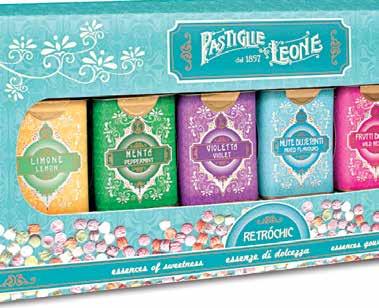
Leone chocolate factory follows old traditions: it uses only select raw cocoa beans, roasted in a special, traditional way.

The Venchi family has been producing chocolate since 1878 and follows the same traditional methods. Many maestri della cioccolata – chocolate masters - work in this company. They are proud to make chocolate using only natural ingredients –cocoa from South America or Africa, hazelnuts from Piedmont, and olive oil and almonds.
The Perugia chocolate factory not only makes chocolate, it also makes other desserts. It was created in 1907 and bought by Nestle in 1988; its Baci –Perugina chocolate-covered hazelnuts are its most famous product. Baci means kiss and Perugina is synonymous with love.
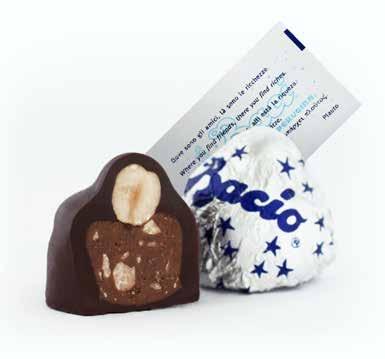
49 VOYAGER 3/2016 GASTRONOMY
Love card written in different languages is put into every wrapping.
APERITIFS are used to arouse appetite. The word itself comes from Latin ("Aperire" – "to open") and stands for a light, mostly dry, low alcohol content drink. In general, a glass of dry white wine or champagne will suffice as an appetizer, but the true aperitif requires more flavor, color and overall a different taste. Italians prefer aperitifs with a more bitter taste eg Campari, Aperol. Aperitifs are usually served with a light snack – cheese, pate, or olive.
DIGESTIFS on the other hand are enjoyed after the meal to aid digestion and are based on leaves and herbs that are believed to benefit the digestive system. Consuming such beverages dates back to the ancient Greeks and Romans. Digestifs have a higher alcohol content than aperitifs. Some fortified wines like sherry, port wine and madeira are enjoyed after meals, but should be considered dessert wines rather than digestifs.
COMMENT:
ELISIR LIMONE
LEMON SWEET LIQUEUR
With the revitalizing flavor of lemon zest grown on the shore of Lake Garda and a balanced alcohol structure, Limoncello is much more than just a pleasant digestif.

This simply-made and natural liqueur has become a mandatory after-dinner drink in the past 100 years. The flavor is saturated with aromas of fruit, citrus and blossoms, while the taste is sweet and sharp, typical of a lemon.
ITALIAN COCKTAILS ARE VERY DELIGHTFUL ANY TIME OF THE YEAR, BUT IN THE SUMMER, WHEN THE HEAT AND HUMIDITY ARE DISTURBING, THERE IS NOTHING LIKE THESE DRINKS TO COOL DOWN AND REFRESH, BE IT BELLINI, SPRITZ OR LIMONCELLO.

EACH OF THE COCKTAILS COMES FROM A DIFFERENT PART OF ITALY, FROM VENETO (OBVIOUSLY, WE ARE TALKING ABOUT BELLINI) TO FURTHEST SOUTH (CONQUERED BY LIMONCELLO)
NEGRONI SBAGLIATO
Campari is one of the most famous Italian alcoholic drinks. It is used in a wide selection of cocktails that can satisfy any taste. However, nothing compares to the Negroni Sbagliato cocktail in the hot summer days due to it containing Spumante sparkling wine. Sbagliato literally means false, and refers to the swapping of gin in the original Negroni recipe for Spumante wine, to highlight the summer mood.
BELLINI
This simple but truly divine drink was mixed for the first time in 1948 in a Venetian bar. There are plenty of ways to enrich a full glass of juice with alcohol, but Bellini is the true classic – distinguished with a brilliant simplicity.
APEROL SPRITZ
Aperol is similar to Campari and due to its slightly bitter taste is great to combine with Prosecco, sparkling water and orange. In short, what else could you wish for on a hot summer afternoon?
ROSSINI
This low alcohol drink, which appeared in the middle of the 20th century, is created through a combination of sparkling wine and fresh strawberry juice. The name was given in honor of the great Italian composer Gioachino Rossini.
APEROL
An orange-colored drink distinguished by its special taste, due to it containing numerous different components –bittersweet orange juice, an infusion of roots and leaves of various herbs.
Each component’s share in the final drink is calculated precisely. Aperol’s alcohol content is not very high for a spirit, only 11% ABV, and is probably the lightest spirit in the world.
CAMPARI
In 1867, Gaspar Campari opened a café in Milan, serving customers with a drink of his own design. The drink was bitter with a reddish color.
The liquid was named Campari Bitter and even today only a select few know the real secret of its true contents. Campari is an aperitif and is usually consumed before dinner.
CYNAR
Cynar is made from 13 herbs and plants. The oddest of them is artichoke (cynara scolymus in Latin, from which the drink derives its Italian name).
Cynar is dark brown in color, has a bittersweet flavor, and its strength is 16.5% ABV. Served on the rocks, Cynar is a wonderful aperitif.
FERNET
This bitter and aromatic spirit is also in the Amaro category. Saffron is one of more than 40 herbs and spices included in Fernet, which is used to make an inherently Italian brand, Fernet-Branca.
This recreational elixir is widely seen as the best digestif.
50 VOYAGER 3/2016 DRINKS
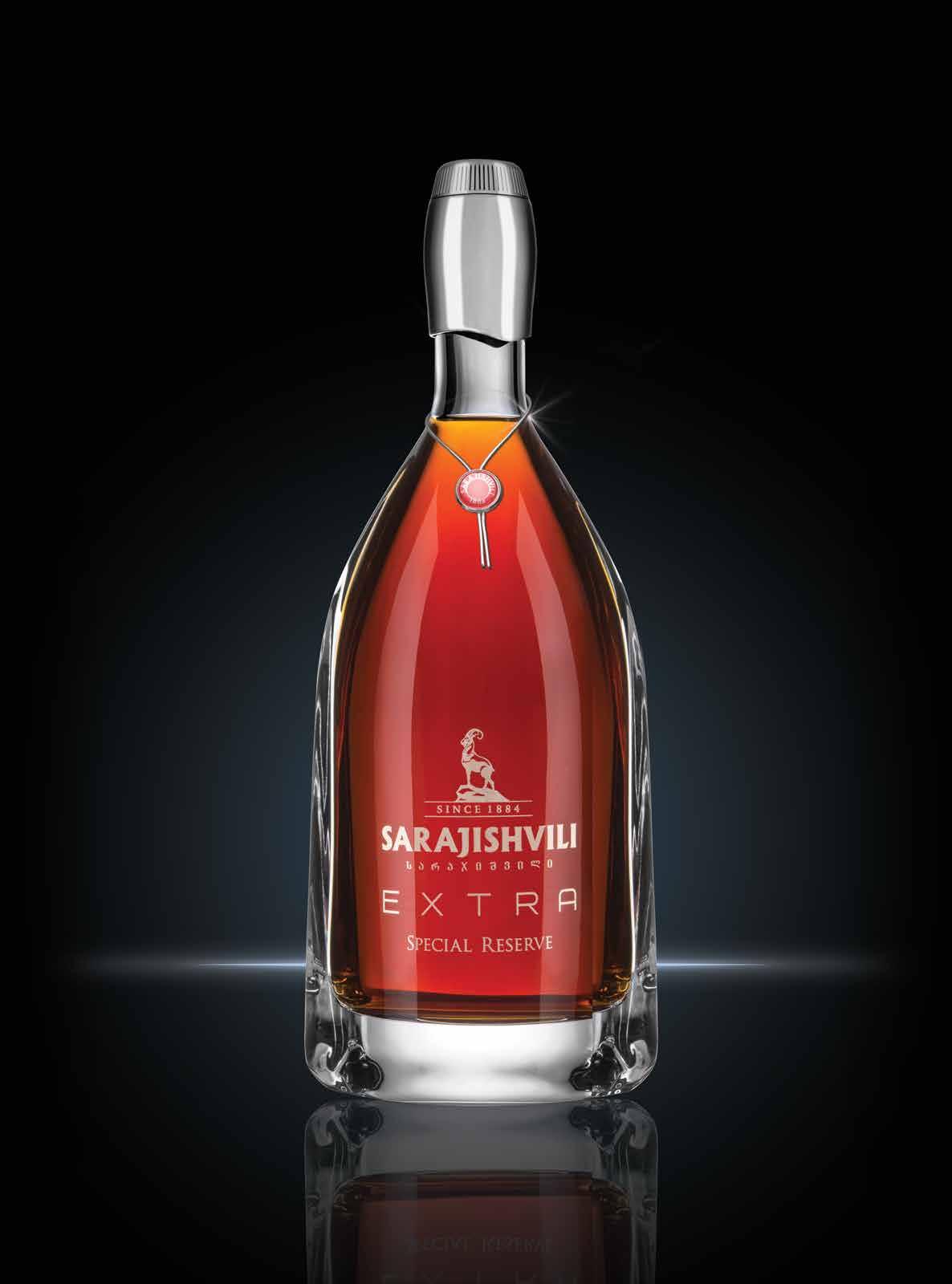
In Vino Veritas
TEA SKHIERELI
Italy’s unique winemaking tradition has been passed on from its Roman heritage, along with other knowledge and treasures. Etruscans started searching for truth in wine on the Apennine peninsula. Despite the fact that Italian winemaking has a 3000-year history, it only became
world-renowned relatively recently. Today it is hard to imagine that a century ago Italian wine was not even bottled.

Following the French example, Italians adopted the reglamentation system as late as 1963, guaranteeing the authenticity and origin of the wine produced.
Strict quality control was established, which gave winemaking a big boost. Today Italy is France’s main competitor in battle for the title of world wine superpower.
According to an evaluation by the OIV (International Organization of Vine and Wine), Wine production has increased by 10% in the past year in Italy to 48.9 dekaliters (world wine production growth has reached only 2%); last year France only had 1% increase, Spain (the third largest wine producer in the world) saw a 4% decrease.

52 VOYAGER 3/2016
IN 2015, ITALY BECAME THE WORLD LEADER OF WINE PRODUCTION
REGIONS AND WINES
Italy is officially home to 350 grape varieties, while Italians claim that they grow up to 20,000 varieties. Every region has its own grape variety. The main national grape type is the red Sangiovese of Tuscany. Home to the most prestigious Italian Sparkling wine, Francioacorta is in Lombardy, near Milan. The north of Friuli specializes in Pinot Grigio and Sauvignon Blanc white wines.
Piedmont is famous for red wines Barolo and Barbaresco made from Nebbiolo grapes. The same region grows two renowned varieties of Barbera and Dolcetto. Gavi, made from Cortese grapes, is considered the best white wine, even though sparkling wine Asti surpasses it in popularity.
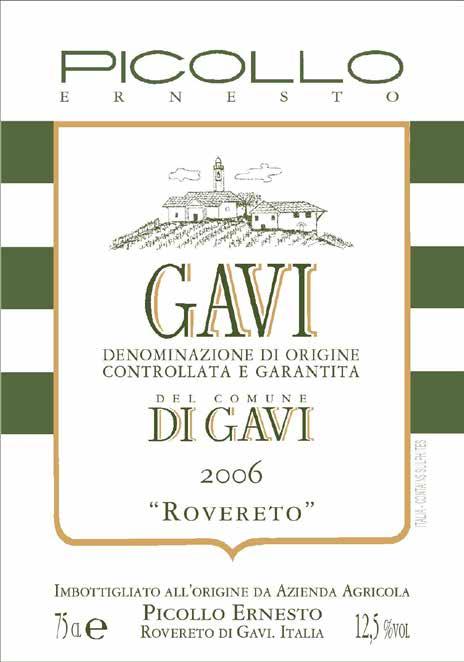
VENETO
In the Veneto region, you should pay attention to the Soave red and white wines. Veneto is primarily known for its Valpolicella commune where Amarone della Valpolicella is made. Apart from a wonderful red wine produced through blending three red grape varieties –Corvina Rondinella and Molinara – you will be offered excellent wines of the IGT category (made from foreign varieties e.g. Merlot). The most famous white wine is Soave, made from the Garganega variety, and it can easily compete with Chardonnay.
PIEDMONT
In Piedmont, you should pay attention to red wines and Moscato d’Asti. This region is famous for the Nebbiolo grape variety, which is distinguished by its high tannins, high acidity and pale color. The splendor of Nebbiolo is showcased in one of the greatest winesBarolo. Piedmont is also famous for Moscato d’Asti and Dolcetto.
TUSCANY
In Tuscany, you should try red wines and a sweet white wine called Vin Santo. This is the region where the Chianti province is situated – home to the famous grape variety, Sangiovese. Since Sangiovese became the dominant variety in the Chianti province, the wine made from Cabernet and Merlot (non-Italian variety) created a category of its own - Super Tuscan Wines, which stands apart from the Italian categorizations.
Despite the fact that these wines fall under the Chianti classification, their quality often surpasses the best Sangiovesse wines of the DOCG category. Tuscany is also famous for the Trebbiano and Vermentino grape varieties, which are very similar to Sauvignon Blanc.
ITALIAN WINE LABEL MUST INCLUDE:
THE MOST EXPENSIVE ITALIAN WINES
Giuseppe Quintarelli Amarone della Valpolicella Classico Riserva, DOCG Veneto $754
Tenuta dell’Ornellaia
Masseto Toscana, IGT, Tuscany $741
Giacomo Conterno Monfortino, Barolo Riserva DOCG $678
Falletto di Bruno Giacosa ‘Falletto’ Riserva, Barolo DOCG, Piedmont $611
Biondi Santi Tenuta il Greppo Riserva, Brunello di Montalcino, DOCG $575
Name of the producer
Wine name
Classification (Vino da Tavola, DOC, DOCG, IGT)
Origin
Harvest year
Bottle Capacity
Alcohol content
FRIULIVENEZIA GIULIA
In Friuli in the Venezia Giulia region, try white wines, especially Sauvignon and Pinot Grigio.
The region is famous for its distinguished, slightly unusual and refined Pinot Griggio and strong Sauvignon Blanc wines.
Friuli-Venezia Giulia is also the place where a very interesting, strange and slightly salty Merlot is produced.

53 VOYAGER 3/2016 WINE
PINOT GRIGIO
Pinot Grigio (grey pinot) is a variety of wine grape from burgundy (France); nonetheless the best wine from those grapes is made in Italy – the climate of northern Italy is best for this variety (presently, most of it is produced in the Veneto, Friuli, Trentino and Alto Adige).
There are three types of Pinot Grigio: mineral and dry; fruit aroma and dry; and fruit aroma and sweet.
SOAVE
Soave is a dry white wine from the Veneto region, mainly from the Veneto outskirts. It means "pleasant" in Italian. The grape variety used to make Soave is Garganega (at least 70%), Trebbiano di Soave, Chardonnay and Pinot Bianco.
Types of wine: Soave Classico, Soave Superiore, Recioto di Soave.
COMMENTS:
CUVÉE PRESTIGE FRANCIACORTA
VIN SANTO
Vin Santo ("The Holy Wine") is a dessert drink, a straw wine made from late harvest grapes of the Trebiano and Malvasia varieties on the outskirts of Florence and Siena.
This exclusive wine is aged for four years. The flavorful tastes of peach, honey and walnut are characteristic of Vin Santo. This wine is used during religious rituals and is considered the favorite wine of popes.
GAVI, CORTESE DI GAVI
Gavi, Cortese di Gavi DOCG are famous Italian white wines. Produced in Piedmont from the Cortese wine variety, it is harvested on the territories of 11 comunes (Gavi, Novi Ligure, Serravalle Scrivia, Bosio, Tassarolo, Francavilla Bisio, San Cristoforo, Pasturana, Parodi, Carrosio and Capriata d'Orba.) There are three types of Gavi wine: still, "pearly" or semi-sparkling, and sparkling.
VERDICCHIO
The Verdicchio grape variety is grown in the Marche region and aspires to hold the title of the best white wine in Italy (and beyond). The dry white wine Verdicchio dei Castelli di Jesi is produced from the selected Verdicchio grapes. This pleasant light wine has pear, almond and lemon aromas. It is an ideal pairing for a beef or pork steak, fish course, fish soups and vegetables.
COLLIO
Collio Bianco is a white wine from Collio, Friuli-Venezia Giulia winemaking region. Usually it is produced with several grape varieties. Collio Blanco production is not strictly regulated: winemakers decide what grape variety they will use out of 12 possible ones. The wine is fermented in steel or oak barrels. Winemakers are also free to decide which fermentation method to use.
VERMENTINO
This is a grape variety which is common in Piedmont, Liguria and Sardinia. Vermentino is full-bodied, has a deep color and a fruity taste. Ligurian wine is lighter and livelier due to its high acidity; Sardinian wines are like Ligurian wines with less acidity.
Wine Varieties: Chardonney 75%, Pinot Blanc 10%, Pinot noir 15%. Alcohol content -12.5%.
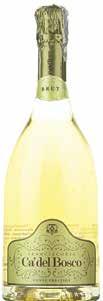

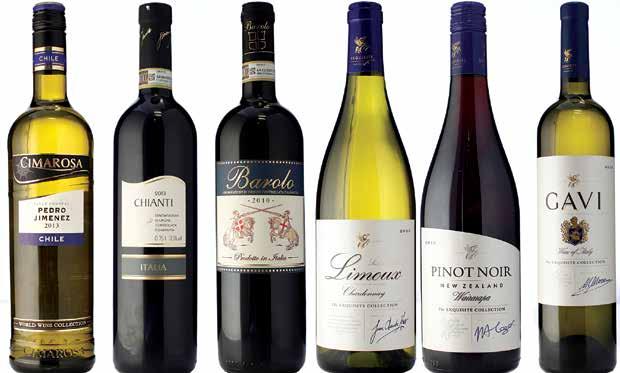
Grapes are specially selected for the production of Cuvée Prestige. As soon as the clusters are picked, they are sorted and stored in a cool place. Pressed grapes are kept in metal containers at a predefined temperature until March of the next year.
To complete the fermentation and obtain the final properties, the wine is aged for seven more months. Afterwards, with great care, the wine is mixed with reserve wines from the best harvest years (20-30%). This completes the magic ritual of winemaking. This unique technique grants distinctive properties to dry sparkling wine. The bottling takes places from April to June in the next year after the harvest. The fermentation lasts for 25 months on average.
Content: Barbera Grapes 100%
Stregth: 14%
Vineyard: Cascina Dell'Orto, Nizza Monferrato
Keeping grape skins for 15 days in sealed barrels at a predefined temperature, long aging in large oak containers (at least two years) and a final ageing in bottles gives Barbera NIZZA its great taste sealed with its unique origin.
Properties: Dark red color, strong smoy flavor, moderate tannins. Best enjoyed at room temperature.
54 VOYAGER 3/2016
BARBERA D'ASTI GATTERA,DOCG NIZZA
AMARONE


It is a dry wine with great aging potential produced in the Veneto region. Grapes for these wines are dried for three months on special shelves. Amarone is made from different grapes, mostly from Corvina Veronese.
BARBERA
Barbera is a red Italian wine grape variety from piedmont. It does not require special soil and produces an excellent harvest. It makes a full-bodied wine, sometimes very alcoholic. It gets delicate and harmonious aroma with age.
BARBARESCO
Barbaresco is one of the best Italian wines. It is a dark red wine from Piedmont, made from the Nebbiolo grape variety. After two to three years of aging, it adopts the color of onion skin.
BRUNELLO DI MONTALCINO
The Brunello grape variety is grown in the South Toscana region. Rich, strong full-bodied wines with good aging potential are made from these grapes. According to DOCG requirements, these wines must be aged in barrels for at least three and a half years and sold no earlier than four years from pressing.
CHIANTI
Etruscans produced Chianti, one of the most famous wines in the world. It is made of 80% tannin-rich Sangiovese grapes harvested on the hills between Siena and Florence. The best among Chianti wines are Rufina, Colli Senesi and Colli Fiorentini. This wines have a strong yet tender and pleasantly acidic aroma.
Traditionally, half-withered grapes are added to new wine after fermentation is over, resulting in a slightly sparkling wine. Presently, Chianti is kept in oak barrels and then placed in squat bottles.
Chianti Classico has a lively red color; you will easily find a seal on the neck of the bottle – black rooster on red background. This indicates the remarkability of the wine. It boasts a violet aroma and a dry, pleasant harmonious taste.

NEBBIOLO
Fine Italian wines are produced from Nebbiolo (red grape variety) Barolo, and Barbaresco. These wines have a high alcohol content, which can be aged for a long time. They are dry, full-bodied, with a strong essential aroma.
CHIANTI CLASSICO RISERVA, AGED AT LEAST FOR TWO YEARS, HAS WILD CHERRY AND FOREST BERRY TASTE. THE BEST HARVEST YEARS ARE: 1985, 1988, 1990, 1995, 1997.

PROSECCO
Rosso di Montalcino (Montalcino Red Wine), which is also made from Brunello grapes, can be sold without being aged in barrels.
MONTEPULCIANO
This is a ruby-colored wine, with a hint of violets in the aroma. The taste is well balanced and dry. The minimum period of aging is two years, starting from the 1st of January. Riserva is aged for three years, of which six months takes place in bottles.
World-renowned Prosecco (DOCG Conegliano Valdobbiadene), which is made from white grape varieties grown on the slopes and terraces of pre-alpine hills of Northern Italy, is a calling card of Italian wine.
It can be produced in two regions only – Veneto and Friuli. The main grape variety used in Prosecco is Glera. It can contain only up to 15% of other grape varieties (e.g. Pinot Griggio, Chardonnay). In this region, Prosecco is made as still, semi-sparkling (Frizzante) and sparkling (Spumante) wine.
Semi-sparkling and sparkling Prosecco ranges from sweet to semi-sweet, and from dry to semi-dry.
55 VOYAGER 3/2016 WINE
SOMETHING CRUNCHY, SOMETHING SOFT, SOMETHING SWEET AND SOMETHING SALTY
SALOME DADUNASHVILI
Pass through Milan’s outskirts, where the industrial city landscape turns to rustic countryside. Arrive in a small town, approach the church and stop by the D’O restaurant (though you will need to have made a reservation six months ago). You are in chef Davide Oldani’s Restaurant, well loved in Milan. Chef stands in the middle of his sparkling new kitchen and gestures energetically.
"Look, we have a wonderful oven, we bake our own bread. This is a unique way to clean the kitchen – you won’t find a single cloth wipe. The kitchen floor is squirted with water and gets dried using special valves".
Davide is a star of Italian cuisine. You can find one of his restaurants at Milan’s Malpensa Airport, probably the only one that does not require a reservation.

Despite boasting ultra-modern technology, Davide’s new restaurant has the warmth of an Italian home.
"W E SPEND LOTS OF TIME IN THE KITCHEN HERE IN ITALY. I WANT MY GUESTS TO FEEL LIKE THEY ARE AT MY HOME. WE HAVE A CHEF’S TABLE BY AN OPEN KITCHEN. YOU NEED A SPECIAL RESERVATION TO BE SEATED AT THE CHEF’S TABLE, WHERE YOU WILL BE GIVEN BOTH FOOD AND ENTERTAINMENT" .
This is true. This space is called Tinello, and the kitchen is open, without glass boundaries. It offers a spectacular view during dinner time: diners can observe Davide’s virtuoso techniques.
However, the chef’s table can be reserved only when Davide is in the house, and lately he has been travelling extensively. He is establishing restaurant concepts around the world, especially in Asia, and he has become the face of many famous brands.

”Friends visit one-another often in Italy, and we want our restaurant to reflect this. We want to feed many people. That’s our philosophy. That’s pop food, when you offer ideas along with the food.

56 VOYAGER 3/2016 GASTRONOMY
VIA MAGENTA, 18 SAN PIETRO ALL'OLMOCORNAREDOMILANO +39 02 9362209
I learned to cook when I was 18. I studied avidly until I was 36, and opened my own restaurant. I worked as a sous-chef under chefs Gualtiero Marchesi, Alain Ducasse, and Albert Roux. I opened D’O in 2003. It took me time to realize that this was what I wanted to do. I was a soccer player, but had to give up that dream after breaking my leg. I tried another dream and started to work towards making it come true".

and the warm onion sweetness is covered with melting Grana Padano ice cream. The unique taste, both sophisticated and homey, is truly miraculous. This dish and the other of edible art that Davide offers his guests follow one rule: the food must contain something crunchy, something soft, something sweet and something salty.
OUR FOOD IS A FOOD OF HAPPINESS, SO WE TRY TO TRANSPORT OUR DINERS INTO A WONDERLAND. EVERYONE IS SO BUSY NOW, AND THE ONLY TIME THAT WE TAKE FOR OURSELVES IS WHEN WE EAT.
I BELIEVE STRONGLY THAT CHEFS SHOULD NOT PLAY ‘PROFESSOR’ WITH THEIR CLIENTS. I WANT TO MAKE EVERYONE HAPPY, I WANT TO MAKE YOU SMILE WHEN YOU EAT, AND I BELIEVE THAT EATING TRUFFLES AND CAVIAR IS NOT NECESSARY TO ACHIEVE THIS GOAL".



Davide opened his restaurant outside Milan, A controversial decision: would customers travel so far? But travel they did, and formed queues. Despite the Michelin star, Davide’s tasting menu costs only 70 euros, while those at other Michelin star restaurants are priced at 170 euros or more. This is the CucinaPop concept, and Davide wants to retain the model in his new, super technologically equipped restaurant.
"I learned how to manage products correctly. I use only seasonal and Italian produce, meaning that ingredients are cheap and so are the dishes using them. I learned to cook seasonally in my childhood; I once asked my mother to make me an omelet with tomatoes, and she answered “No, Davide, I can’t make it, since it is not tomato season yet”.
Davide has special utensils, for example spoon and fork hybrids used to eat his amazing risotto.
Caramelized onion in puff pastry is Davide’s specialty dish. Pastry and onion layers are intertwined,
We want to touch all senses in food and let you distinguish all of the ingredients. I don’t like to lie to people. I avoid playing with people’s perceptions. If one is making spaghetti, it should be spaghetti. I don’t understand why people cook one course that tastes like another. Our food is a food of happiness, so we try to transport our diners into a wonderland. Everyone is so busy now, and the only time we take for ourselves is when we eat. I believe strongly that chefs should not play ‘professor’ with their clients. I want to make everyone happy, I want to make you smile when you eat, and I believe that eating truffles and caviar is not necessary to achieve this goal".
57 VOYAGER 3/2016
"IT IS BUSINESS AND NOT POETRY, THOUGH WHAT WE DO IS VERY CLOSE TO POETRY. YOU CAN’T LIE TO PEOPLE ANYMORE, EVERYTHING HAS CHANGED, AND I DON’T WANT TO OWN A RESTAURANT WHERE DINERS HAVE TO PAY HUNDREDS OF EUROS".
"WE HAVE MILLIONS OF RECEPTORS ON OUR TONGUES. WE ARE FORTUNATE TO BE ABLE TO TASTE SO MUCH: SUGAR, SALT, CRUNCHINESS, SOFTNESS, SOURNESS".
THE ITALIAN WORD ‘CAFFÈ’ COMES FROM THE TURKISH WORD ‘KAHVE’, WHICH IS DERIVED FROM THE ARABIC ‘QAHWA’.
THE FIRST ITALIAN COFFEE HOUSE OPENED IN VENICE ON THE PIAZZA SAN MARCO IN 1683. POPE CLEMENT VIII ISSUED A DECREE REGARDING COFFEEDRINKING IN 1600.
THE NEAPOLITAN FLIP COFFEE POT, OR CUCCUMELLA, WAS INVENTED IN 1819; IT HAS A DOUBLEFILTER SYSTEM, THUS COMBINING THE TURKISH AND VENETIAN WAYS OF MAKING COFFEE.
ITALIAN PASSION – THE AROMATIC CHARM OF DRINKING COFFEE
TEA SKHIERELI
Italian coffee is consumed in Italy only, as it can’t be exported, and the reason goes beyond historic experience. Coffee and Italy have a special relationship: coffee is not just a drink for Italians, it’s a national ideal, almost a religion; a real Italian passion.
Italian coffee is consumed in Italy only, as it can’t be exported, and the reason goes beyond historic experience. Coffee and Italy have a special relationship: coffee is not just a drink for Italians, it’s a national ideal, almost a religion; a real Italian passion.
If you walk into a local bar, sit at a table and ask a waiter for a shot of espresso, stir sugar into it and have a pastry – you’ll likely receive a gaze full of tolerant cynicism.
Italians don’t say espresso; they say ‘caffe normale’; they never drink it with a dessert, rather in two gulps, standing at the bar and so only paying half as much for it. Every Italian has at least five coffee breaks per day. It is almost blasphemous to order coffee with milk after lunch (cappuccino, latte macchiato). That is the time for ristretto or coretto – coffee with grappa.
Each part of the day in Italy has its particular coffee. Latte macchiato, or cappuccino, is a morning drink, as it has milk (foreigners who drink cappuccino at other times of the day are the subject of jokes among baristas). Espresso, or caffè macchiato, is an after-lunch drink; deca, or decaf coffee, is an evening drink. Italians visit bars several times per day and savor marocchino, corretto, al vetro, caffe d'orzo, granita di caffè (with cream), and caffè shakerato. Every Italian agrees that Americano is not a coffee; most call it ‘acqua nera’ (‘black water’).
Everyone has a favorite bar – this is part of the local lifestyle. Good baristas/barmen remembers clients’ preferences, are quick, and make wonderful coffee. They are also almost friends, ready to discuss any topic, from soccer to politics.
A SHOT OF ESSPRESSO COSTS LESS THAN 1 EURO (MORE IF YOU DRINK IT SITTING AT A TABLE), WHILE CAPPUCCINO COSTS 1.30.
Italians have dozens of ways to let the ‘barista’ know exactly which coffee they’d like: ‘alto’ is a smaller cup; dopio is a double, caffe al vetro is coffee in a glass cup that cools faster; bollente retains its temperature longer; homemade coffee, caffe macchinetta, is made in an aluminum moka. Many bars like to charge beforehand, especially at airports and railway stations.
Italians say ‘let’s take coffee’ (not ‘drink coffee’), probably because of the small amount. Italians call themselves coffee snobs, as they dislike coffee anywhere else in the world. The strange thing is that the coffee-drinking culture is new to Italy. Before the Second World War, coffee was an elite drink; however, mass production of the espresso machine made it accessible to everyone. Italians replaced traditional breakfasts with a cup of coffee.
Italians do not sit at a table, everything takes place at the bar. This is strange to foreigners who are used to drinking coffee at a table. Bars don’t usually have tables, and if they do, they charge more for table service Coffee drinking is a philosophy here, an emotion, the beginning of a new day, an awakening of every sense...
It’s a ritual of sensitivity and goodwill. Unsurprisingly, Naples is the home of the caffe sospeso tradition: wealthy clients pay for an additional cup of coffee so that the barista can offer it to someone less fortunate.
How is the ideal Neapolitan coffee made? What is its secret? The secret is in the coffee blend and special roast, which make the beans darker than other coffees in Italy and rest of the world. This roasting ensures that after two days, the coffee oils are more prominent and the aroma is better.

58 VOYAGER 3/2016
‘Espresso’ is a technical term. If you want to drink it, you should order coffee only. Double espresso is a faux pas in Italy – Italians drink coffee frequently, but prefer small measures. The standard coffee temperature will not burn your mouth. If you want a hotter coffee, order caffe bollente.
Espresso is very strong, and served in small shots. Espresso means ‘fast’ in Italian. It is the king of coffees. A pleasant balance between sour and bitter forms the base of espresso. The standard shot is 30-35 ml. The ideal espresso has an homogeneous, uniform, dense golden-hazel foam. The foam should be at least 2 mm thick. A shot of espresso should be served within a minute and a half of brewing; it is consumed quickly, in several sips.
Espresso macchiato is a standard espresso with a little foamed milk (15ml) spread with a bar spoon. This is the real Italian version. Macchiato means ‘with spots’.

Café Americano is an American-style coffee, brewed in a drip pot that works using gravity: hot water drips into a filtered funnel that contains the ground coffee.

Doppio is a double espresso shot.
Cappuccino is mix of espresso and steamed, wet milk (in equal proportions). It is served in a larger cup than espresso, but smaller than macchiato.
Latte Macchiato is served in a tall glass containing 40% cream and 60% milk; a shot of espresso is then added. It usually has a layer of foam, like cappuccino. Sometimes only milk is used.
Lungo is weaker than espresso, as it contains more water (50-60 ml), while the amount of coffee is the same (7g) as for espresso. Lungo is stronger than Americano.
Marocchino, mocha, and mochaccino have chocolate added.
Italians drink almost 14 billion shots of espresso annually
Italians consume 3.7 kg of coffee per capita per year
Some 270 364 Italians work as baristas/barmen
A typical Italian bar serves approximately 230 cups of coffee daily
ITALIANS HAVE DOZENS OF WAYS TO LET THE BARISTA KNOW EXACTLY WHAT COFFEE THEY’D LIKE: ALTO IS A SMALLER CUP, DOPIO A DOUBLE








Glace is cold coffee served with a scoop of ice cream in an Irish coffee glass; it is drunk with a straw.
Con panna is espresso with a fluffy ‘hat’ of whipped cream, sprinkled with cinnamon. Con panna means ‘with cream’ in Italian. It is served in a cappuccino cup.
Espresso Romano is espresso with lemon. The name manes ‘Roman’; the drink is often decorated with a piece of lemon.






Corretto is espresso with a little alcohol, for example, grappa.
Ristretto isespresso brewed with less water (7g coffee 20-25 ml water); it is a shot of the most concentrated coffee, with no sugar added, and is believed to be ‘true’ Italian coffee. The name means ‘strong’. Ristretto is served in an espresso shot glass with a glass of cold water. You should drink several sips of cold water before drinking it. Thus, you will avoid dehydration and cleanse your palate to be able to appreciate the full aroma of the coffee.
For more than 80 years, the well-known man has been asking for ‘one more coffee’ on the most famous coffee maker’s logo. In 1933, Engineer Luigi di Ponti and designer Alfonso Bialetti made it possible to make espresso easily at home.
Torre is a large shot of espresso covered with a ‘hat’ of foam. The foam does not mix with the coffee, and is 1.5-2 cm thick. It is drier and denser than cappuccino foam, hence its stable form. Torre is served in a cappuccino cup.
Caffe alla nocciola is espresso mixed with a hazelnut foam. If you order marocchino in Milan, you will give the impression of being someone who knows coffee; it’s cappuccino with cocoa at the bottom, then steam milked, topped with espresso.
59 VOYAGER 3/2016 COFFEE
ITALIAN’S DON’T SAY ‘ESPRESSO’; THEY SAY ‘CAFFE NORMALE’
CALENDAR
La Scala, Milan – one of the most famous theaters in the world – offers the following performances for opera lovers:
May 17 – June 6: The Child and the Magic; The Spanish Hour
Composer: Maurice Ravel
Conductor: Marc Minkowski
June 4 – July 2: The Cavalier of the Rose
Composer: Richard Strauss; Conductor: Zubin Mehta
June 18 – July 8: Simon Boccanegra
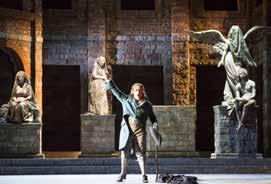
Composer: Giuseppe Verdi
Conductor: Myung-Whun Chung
September 2-26: The Magic Flute
Composer: Wolfgang Amadeus Mozart
Conductor: Adam Fischer
From the September 12, Milan will host the 21st Trienale di Milano international design exhibition entitled "21st Century. Design After Design". The main exhibition will be held in the Palace of Arts.
From June 18 – July 3, land art artist Christo will change the appearance of Lake Iseo, covering it with 70,000 sqm of yellow fabric. Cubes will float on the surface to create ‘floating docks’. For 16 days, a trail will connect the Bray Bank with Monte Isola island in Lake Iseo.

A musical festival will be held in Ravenna on June 12-13. This is one of the most renowned festivals in Europe, with performances by famous musicians. The festival will include various types of music: symphonic and chamber, opera and theatre, ballet and regional. The festival is visited by a diverse range of guests.

Fuorisalone is part of the Milan Design Week. Renowned brands and unknown designers offer up to 300,000 guests from 160 countries a unique show at the Furniture Salon. Fuorisalone combines creative expression with various methods of art and design. Visitors learn about young designers, creative associations, architecture firms, and studios, all while enjoying healthy food, sports, and music events. It is held at various locations in Milan, most notably Porta Venezia and Liberty. Brera Design District, 5 VIE art & design.
Verdi Theatre in Trieste is one of Italy’s oldest working opera theaters. It was built in 1798-1801 by architects Gian Antonio Selva and Matteo Pertsch.
Opera season: June 10, 11, 12, 14, 16, 18; Die Fledermaus (The Bat)

Composer: Johann Strauss
Conductor: Gianluigi Gelmetti
August 31 – September 10: 73rd Venice Festival. The festival will be hosted by Palazzo Del Cinema on the Lungomare Marconi (Lido di Venezia).

La Fenice Theatre is situated on San Fantin Square in the San Marco district. This is the very place where the Operas of Gioachino Rossini, Vincenzo Bellini, Gaetano Donizetti, and Giuseppe Verdi premiered in the 19th century.
La Fenice opera season:


May 7 – June 7; The Barber of Seville
Composer: Gioachino Rossini
Conductors: Stefano Montanari, Marco Palladini
Director: Bepi Morassi
May 8 – July 2: La Traviata
Composer: Giuseppe Verdi
Conductors: Francesco Ivan Ciampa, Marco Palladini
Director: Robert Carsen
Venice Architecture Biennale: an international architecture exhibition being held from May 28 - November 27. The subject this year is "Report from the Frontier".
Curator: Cielo Alejandro Aravena
Every year, Venice transforms for three weeks during its famous carnival. This features shows and marches, as well as events in the city streets and at the famous museums, theaters, and palazzos. The main event is the Maria Celebration on January 30, when the city’s most beautiful women walk through the streets accompanied by masked dwellers in carnival costumes.
The Flight of the Angel is also held on January 31, with a white dove being released from the belfry of the Ducal Palace and flying to Marco Square.
60 VOYAGER 3/2016 JUNE-SEPTEMBER
2016
March 9 - July 24: Florence’s Palazzo Strozzi hosts the exhibition From Kandisky to Pollack, featuring more than 100 European and American masterpieces from the 1920-60s.

July 15 - August 13: The Puccini Opera Festival will be held at Torre Del Lago, featuring famous pieces such as Tosca, La Boheme, Turandot, and Madame Butterfly.
The grand Arena Di Verona opera festival takes place every year in the Arena amphitheater in Verona.
The 2016 program includes:
June 24 – August 27: Carmen
Director: Franco Zeffirell
June 25 – August 28: Aida, based on Franco De Bozzio’s 1913 staging
July 2 – July 30: La Traviata
Director: Hugo Di Ana
Featuring a performance by ballet star
Roberto Bolle
July 23 – August 25: Tudandot
Director: Franco Zeffirelli
August 6-26: Il Trovatore
Director: Franco Zeffirelli
An exhibition of symbolist art will be held at the Milan Royal Palace until June 5. More than 150 works will be presented in the halls of the Palazzo Reale, including sculptures, sketches, and paintings by famous artists including as Gustav Klimt, Franz Von Stuck, and Ferdinand Hodler.
March 11 – September 25: the Museum of Culture of Milan (MUDEC) will host an exhibition of Juan Miro’s works created in 1931-81.

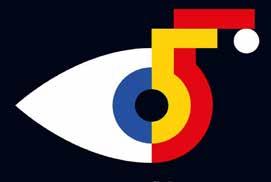
May 5: an exhibition/workshop for children entitled In the garden of Matisse will open at the Palazzo Delle Esposizioni in Rome. The event is based on the eponymous book. The main theme of the exhibition will be collage, in which Matisse became interested in the later years of his life. Armed with paper and scissors, little visitors will be able to take an imaginary journey through the garden of artistic wonders.

The Rada Delle Biscieri wine festival will be held in Chianti on June 4-5, and will feature degustation of food and wine.
Ferie delle Messi is a medieval harvest festival which takes place on the third weekend of June in San Gimignano. It involves almost the entire population, who are dressed in period clothes.
During the festival, you can see equestrian knights, tournament riders, musicians, artists, craftsmen, and numerous shows, and try various delicacies.
Volterra A.D. 1398 is a medieval market which starts on the third Sunday of August and continues for a week. This event is one of the best festivals for period costumes, entertainment, and food.

June 23-24: the old Florentine form of soccer, or Calcio, is played. Matches are usually held at Santa Roce Square. Calcio originated in Florence in the 14th century, and is something between modern soccer, rugby, and wrestling. The players wear traditional pantaloons. Four teams participate, with each representing a particular quarter of the city.
September 2-4: Monza Autodrome (northern Italy) will again host the Formula 1 World Cup leg.

The route of the Giro d'Italia bicycle race runs through large sections of the country, and passes through plains, hills, mountains, and cities.

The total distance of this year’s 99th Giro d’Italia is 3,383 km. The status of Kopi Peak has this time been granted to Colle dell'Agnello. The final phase will take participants from Cuneo to Turin. The winner receives the coveted trophy in Turin, engraved with his name.
Author of the rubric: MZIA CHIKHRADZE
61 VOYAGER 3/2016
„I JUST TRY TO FILL THE VOID" CHRIS BOTTI:

What do you feel when you are going to your favorite musician’s concert? Excitement, joy and fear; you are afraid of a disappointment; you run to make it on time; find your place in the hall and then… The lights go out and nothing matters. You forget everything and realize that you needed to attend this concert. You understand how much is in the music. You know that you can sing along with every word of every song. You unconsciously remember the lyrics. A pleasant tiredness and palms hurting from constant clapping bring you back to reality after the concert.
I believe you know Tbilisi well?
Yes, I feel at home here. I visited Tbilisi 10 years ago for the first time. I wish the world knew what an amazing city Tbilisi is – the architecture, the environment and most importantly the warm and welcoming people; I’m not even mentioning the food!
What can you say about the audience? You’re an expert now…
The audience follows you here. I’ve met many Georgians at my concerts outside of Georgia: in New York, Los Angeles, and San Francisco. It’s fantastic. It’s amazing when I visit this little city for two days and see a full house.
62 VOYAGER 3/2016 MUSIC
SALOME DADUNASHVILI
Photo : Sopho Melikidze
Your mother was a classically trained musician – when did you decide to become a musician?
I decided to become a musician when I realized that I could never be a sportsman! Every boy has a time in his life when he wants to be a football or baseball player. That’s what I wanted until I became 11-12 years old. By that time, I had already been playing the trumpet for several years. I was practicing diligently, however that wasn’t what pushed me towards choosing this profession. I believe I was 12 when I first listened to a Miles Davis album. It was the first time I understood his sound and I decided that I wanted to play like that and I would do it or die trying. I had no way out. I didn’t give my parents a choice either. I said that I only wanted to play trumpet and nothing else.
I am 53 years old now; if I had written down my dreams at 11 and sent my adult self a postcard, I would now discover that I’m living the dream. It’s fate. Call it whatever you want, but that’s how it is. I’ve met so many people in my life that just believed in my talent and helped me, for example Sting and Oprah. Also, recording business was completely different when I started my musical career.
Jazz musicians must find it hard to live in such a consumerist world, where commercial success is the ultimate measure.
That’s true. The recording business as I knew it came to an end and it will never be the same. Every studio is looking for a performer like Adele or Justin Bieber to achieve financial success. Young singers and performers stand almost no chance.
We have a very talented young performer, Beka Gochiashvili, and the whole Georgia is cheering for him. He has just started his career and reached considerable success.
I know Beka – he has a rare talent and young musicians like him who follow the acoustic jazz tradition have nothing to fear.
Beka is a child prodigy and a great career awaits him. Have you ever felt that people looked at you like a child prodigy when you were little?
No, never, and it really helps me now. Bill Evans once said that Miles Davis created his best music at the age of 40-50. The music of 20 year-old Miles is not what it became later. It’s as if his sound was cautious; later, he became more experienced, not only as a musician, but as a human and man. His sound gained emotions expressed in his best works.
Are you getting closer to Miles Davis’ sound?
David Foster is a wonderful producer who says the right things. For example, he once said: "Celine Dion will never become Barbara Streisand, she just tries to fill the void". I’m probably like that: I just try to fill the void.
What changes your life: receiving Grammy Awards, good weather, being together with friends? When do you say: "I feel good now"?
That’s how I feel when I meet musicians. I am privileged to travel with the best of the best and play with them. This is happiness. I have a very interesting tour year now. Sting and I will perform together several times and that makes me happy. He will join us at some point and we will continue touring together. Next year, 2017, I will probably consider recording an album. I haven’t found the direction yet.
What happens when you’re working on an album? What inspires you?
I live in New York now and I like wandering the streets. Generally, my albums are very different from what you hear on stage. Live performance brings a different kind of energy. I like a romantic feel in my albums. Many prefer recording radically different albums each time, but I don’t. I don’t want to be different, I want to be better, more interesting and improvising. This is what I aspire to. I practice for five hours each day in New York and for at least two hours when I’m touring.
THIS WAS NOT THE FIRST TIME THAT CHRIS BOTTI AND STING APPEARED ON STAGE TOGETHER, BUT IT WAS THE FIRST TIME FOR THE TBILISI PHILHARMONIC HALL TO HOST THIS STAR DUET. THE AUDIENCE SANG ALONG TO THE FAVORITE HITS OF BOTH PERFORMERS. EVERYBODY HAS SPECIAL TIES WITH THOSE SONGS; IT TURNS OUT, CHRIST BOTTI HAS ALSO FORMED SPECIAL TIES WITH TBILISI.

63 VOYAGER 3/2016
Photo : Lasha Kuprashvili
MUSIC
How do you manage to record so many successful duets? Are you just so friendly that everyone enjoys partnering with you?


(Laughs) No, you know, Sting and Bocelli are wonderful musicians and they understand that even the best vocal performance may turn into interesting music when paired with the trumpet. If I were Mariah Carey and tried to record duets with everyone, I would probably have a hard time, since two great voices take up too much space. Jazz musicians don’t like duets either and if they do record, they often outplay the singer. I’ve worked with many geniuses and I understand when to be lyrical, when to lead and when to follow. Most jazz musicians love solo performance too much.
how it is. Sometimes we go out in a nearby town, Figline Valdarno, we just walk around or have an ice-cream. I frequently travel to Italy and often visit Milan and Florence. As for the food, the country is just amazing in that regard.
Have you ever thought of old age?
You can’t even imagine - I think about it every day! Trumpet-playing requires lot of psychological strength and I just can’t ignore thinking about it. I am working a lot to stay on stage as long as possible. Everything is fine now, but I can’t relax.
Interestingly, you mention solo. I’d like to talk to you about the play list you put together for the "Solo" clients.
To tell you the truth, I really like this idea. My manager Jeremy and I are having fun compiling this playlist. It might include Sinatra or a Christmas song – something that excites us at the moment. It’s very interesting and we’re always trying to shoot and send videos from different countries.
Your heritage is Italian and I have to talk to you about Italy, since this issue covers Italy.
What a wonderful idea! Italy is always a wonderful idea. I am very embarrassed to admit that for the last 15 years, whenever I have visited Italy I have stayed at Sting’s marvelous palazzo and spent almost all of my time there. He has amazing staff working for him, they make exceptional dishes, so to tell you the truth, I don’t want to leave the palazzo.
You probably realize that many people envy you right now! (Covers his face and laughs). Yes, I know it sounds terrible, but that’s
64 VOYAGER 3/2016
Photo : PhotoGIOgraphy 2016

MY HORRIBLE BEAUTIFUL CLIENTS
Michele de Lucchi is loved dearly in Milan, with a motherly love. His name is like a magical golden key that opens every door and makes people smile. This love is mutual – Michele loves Milan as well. Whenever he stops to think and breath in the wooden aroma of his workshop, he looks over Milan’s old streets. All of the floors of his office are full of kind people creating something magical. Legendary designs cover every corner of the office. This man, with his huge beard and gentle voice, creates a tranquility around him from which unique ideas are born.
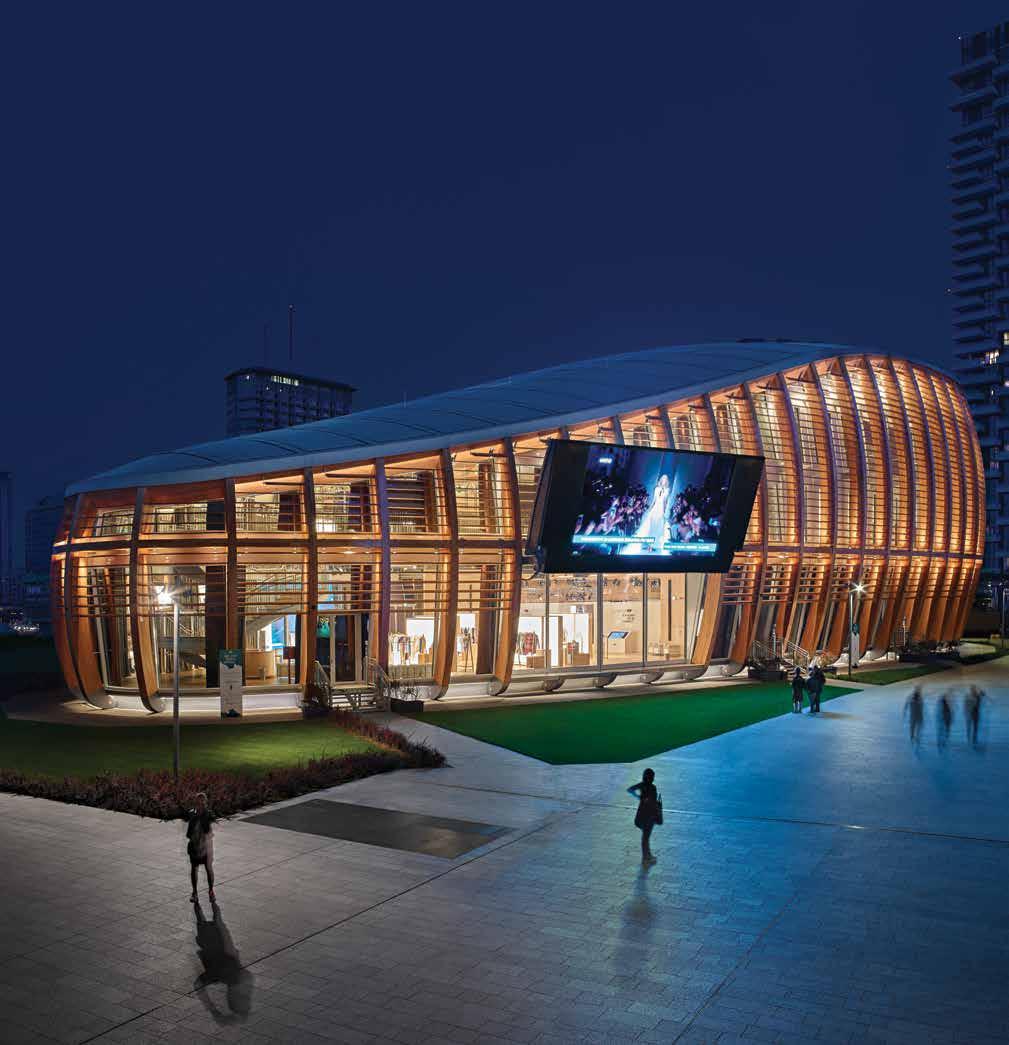
66 VOYAGER 3/2016
DESIGN
SALOME DADUNASHVILI
UniCredit Pavilion, UniCredit Business Integrated Solutions Scpa, Milano (Italia), piazza Gae Aulenti, 2013 – 2015. Ph. Tom Vack
ARTISTS HAVE MORE FREEDOM THAN DESIGNERS OR ARCHITECTS. THEY DO NOT HAVE ANY RESPONSIBILITIES. THEY CREATE WHATEVER THEY LIKE. ARCHITECTS ARE MUCH MORE ACCOUNTABLE. THE ARE ANSWERABLE TO SOCIETY AND PEOPLE. ARCHITECTURE HAS TO BE CONTEMPORARY – YOU CAN’T RUN AHEAD OF TIME, OR STAY BEHIND.
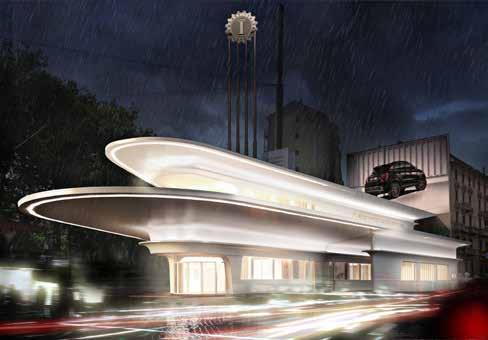
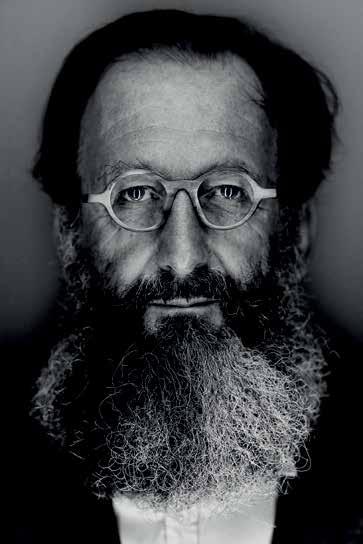

You step into people’s lives, you create space where they live, you make their everyday objects, and, I believe, you accomplish this very romantically and poetically…
I have never used the term ‘romantic’ when describing my work, but I really like it. My children make fun of me, as I like romantic films and sometimes cry during them. The main goal of an architect is to serve people, to enhance their lives. Architects aim to optimize people’s living spaces and influence their lifestyles. Humans have always aspired towards beauty. We currently recognize two types of beauty: the classical understanding of the term, implying that beauty follows certain regulations and everything has to be ideal, to achieve the ‘golden ratio’; and the second type,
which implies that everyone has their own perception of beauty. It can take many forms. Beauty belongs to everyone. I am absolutely certain that we are still living in an era of romanticism, and I really like it. I believe that all of us have rational and irrational sides. Nobody is fully rational or fully emotional. Every moment of our lives is an attempt to balance these two elements. That’s very important for my profession. When I take an order, I try to understand which wishes stem from rationality and which from emotion, and provide the client with the best project.
The Europe of the 70s was filled with romantic notions and art for art’s sake. You participated in this revolution. Did the changes in architecture reflect the revolutionary attitudes of the 1968
67 VOYAGER 3/2016
Ritratto Ph.GiovanniGastel 2014
Project Michele De Lucchi Garage Italia Customs
NOBODY IS FULLY RATIONAL OR FULLY EMOTIONAL. EVERY MOMENT OF OUR LIVES IS AN ATTEMPT TO BALANCE THESE TWO ELEMENTS. WHEN I TAKE AN ORDER, I TRY TO UNDERSTAND WHICH WISHES STEM FROM RATIONALITY AND WHICH FROM EMOTION, AND PROVIDE THE CLIENT WITH THE BEST PROJECT.
student movement? Can design revolution take place without social turbulence?


That was a time of change. Humanity searches for the correct definition of democracy to understand how to retain our individuality as well as to function as a whole. Society is not a uniform mass, but comprises individuals. That’s the main aim of civilization to create a society that consists of individuals; the aim of democracy. We want to be different, and I, an architect, create this difference. We want alternatives, and should look for means to integrate new systems. We may get carried away from this world, lose each other. Defining the means of integration is the biggest challenge of the modern world. Disintegration is the antonym of integration, it’s horrible and causes destruction and uncontrollable turns of events.
The world today is trembling much more than it did in the 60s. This energy is very negative. I wonder whether it’s possible to turn this trembling into something positive, to help create something new, just like in the past.
We have no other choice. That’s our hope. We have to be optimists. That’s the only way. I recently constructed a table shaped like Pangea, the ancient continent comprised all land. It was surrounded by an enormous ocean. We originated on this huge island, and, just as Pangea started to break apart, so did the people. We have to learn to integrate. We have to have the means to connect to one-anther and break up with one-another, painlessly. Like breathing in and out. Milan is the most international of Italy’s cities; talking about integration and disintegration, we picture a vessel carrying the best achievements of our civilization; Milan is like that vessel.
68 VOYAGER 3/2016
Museo Pietà Rondanini Michelangelo, Comune di Milano, Milano (Italia), Castello Sforzesco, 2013 - 2015. Ph. Tom Vack Museum Exhibition project: Michele De Lucchi
Padiglione Zero, Expo 2015 Spa, Rho (Italia), sito espositivo di Expo Milano, 2012 - 2015. Ph. Tom Vack
DESIGN
What denoted the beginning of a new stage for you as a designer?





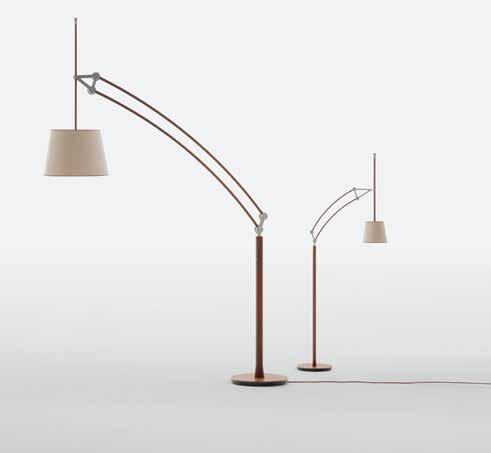
Art history is measured in decades. Hence, views change every decade, and that’s how it has worked for me too. As a student, I witnessed conceptualism, a radical architecture era that shaped my outlook. This was followed by avantgarde, which shattered the rules. Looking back, I now realize that I have been always breaking my own rules. Everything revolves around nature today, ecology is the most important issue. My children are vegans, and have asked me to become one too. I tried, but did not manage. That’s something that I can’t change (laughs).
Our planet’s resources are limited. We need to start using them wisely. Its population will soon double, and unless we come up with something, life will be impossible.
Not only is our planet’s population increasing, but some countries that we were not noticing due to crises now hold leading positions (for example certain Asian countries); they are becoming creative leaders too. Is it possible for the design and architecture axis to shift towards Asia?
Asia is the currently production center. Intellectual ambitions are still modest as consumerism is a novelty there, and they are enjoying it. Art is brilliant in China. They have a wonderful tradition of handmade art. Italy offers a lifestyle. We create new standards of how people should live. Freedom of choice changes lifestyles. We present the world with new choices. We have to get away from the consumerism and create thoughtfulness among buyers. Architecture and design aims to achieve this goal. We wish to create truly valuable things, while protecting nature.
Who is a thoughtful, smart client? I am asking because architects alone are not creating the new world, clients who place orders are creating it as well.
That’s very true. We are purposeless without clients. They are as important as the artists. First of all, an architect has to learn who the real client is. When a person walks in and asks for an office design, the product has to meet not only his/her needs, but also those of others who will work in that office. It also has to please passersby who see the office every day. We have to take everybody’s interests into account. Working in Georgia was a fantastic experience for me: I was inspired by the idea of building the new Georgia and waving goodbye to the Soviet Union. This is the greatest joy for an architect. The peace bridge is one of my favorite creations. It is a monument, not just a bridge. We will never accomplish effective communication if we don’t link our shores; this is why the bridge is the best symbol of peace.
New technology was used to build this bridge. Is new technology an architect’s best friend, or does it distract him from the important things?
That’s a good question, as technology can confuse you, but it can also be great, lead you to chase new opportunities. Technology allows you to see new horizons. It develops rapidly and connects us to the future. This is the future: right now, I am convincing a very wealthy man to destroy every building on the land that he owns in Milan and plant forests. I am sure he’ll do it, I can be very convincing. As he is saying this, Michele de Lucche smiles slyly and seems entirely likely that the architect will indeed convince him.
69 VOYAGER 3/2016
QUEEN OF RINGS
One can never be sure about people like Monica Castiglioni; she changes like the November sea. She changes often and is brutally honest If she likes something, she really likes it; if she doesn’t, she doesn’t. Don't even think about entering her store in a fur coat – you’ll regret it. You will be served but you will also receive Monica’s deadly stare.
One thing is for certain, Monica had two lucky occurrences: first, she was born into the family of the renowned Italian designer Achille Castiglioni; he was the creator of Italian design. Her second stroke of luck was that she inherited her father’s talent.


Monica did not follow her father’s footsteps; instead of creating human habitats, she decided to embellish the human body and began making jewelry.
Her store is in the center of Milan, at the heart of Italy’s daring architectural landscape. A vertical forest overlooks the small street that houses her store – the terraced house is created by the famous architect Stepano Boeri, resulting in trees that grow in the sky.
Monica makes all of the jewelry in her store herself. She does not like to sketch. She refers to herself as Dory - a forgetful fish from the film "Find-
ing Nemo". Her colleagues gave her that name. Monica’s store/workshop is the ring heaven. Her liquid metallic forms embrace your fingers and wrists and look like magical plants that bloom on your hand. There are no straight forms or symmetry – every ring is like a natural phenomenon, enigmatic and changing, just like their creator.
Rings are Monica’s favorite pieces of jewelry.
"I am selfish", claims the designer. "I make jewelry that I like and most importantly, wear. Rings are my favorite pieces of jewelry and this is why I have a nice ring selection. I sit down and begin to work. This is my workshop. I don’t care what people like, I make what I like. I make one piece first and then I multiply it. I don’t analyze how I do it.
I started working on metal 35 years ago. I was cutting, welding and creating rigid jewelry. I worked on aluminum, but then I discovered my own material and reached the desired plasticity. Recently
70 VOYAGER 3/2016 DESIGN
SALOME DADUNASHVILI
ITALIAN DESIGNER ACHILLE CASTIGLIONI’S ONE OF THE FOUNDERS OF ITALIAN DESIGN. FAMOUS LAMP. ARCO, 1962 FOR THE FLOS COMPANY.
I discovered a new technology: I use a 3D printer for some pieces that seem too heavy when done in metal".
“Your jewelry has an interesting gold color...”
“Don’t say ‘gold’! This is bronze, since I only use bronze, and sometimes silver. Sculptures are made of bronze and since my jewelry is practically a sculpture, it is made of bronze too".
80% copper and 20% tin – a perfect proportion that gives Monica’s jewelry its magical color, and, as she claims, its healing properties.
“I knew about the healing properties of copper but now I know from experience that wearing my jewelry is good for your health. Many times I have been approached by people with arthritis who wanted to hide their fingers under my massive rings. Now these people can move their fingers freely – something they couldn’t do before. I used to doubt it, but now I know for sure it’s true".
And I know for sure that these rings could adorn elf queens; it is a great happiness that Monica’s jewelry gives us; it enables us mere mortals to feel like princesses, forestial and urban at the same time. Monica lives in Milan and New York and likes to take pictures of the cities reflected in puddles, thus uniting nature and the concrete jungle.
NO STRAIGHT FORMS OR SYMMETRY, EVERY RING IS LIKE A NATURAL PHENOMENON –ENIGMATIC AND CHANGING, JUST LIKE THE AUTHOR.
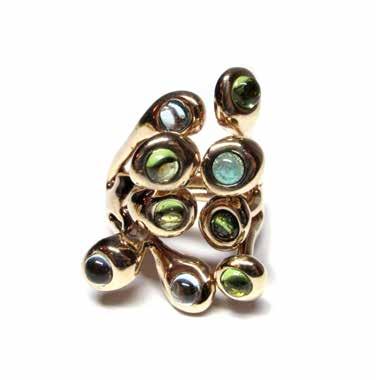


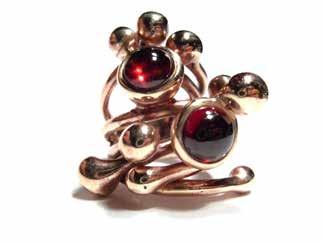

Castiglioni’s advertisements never use models. Rather it is Monica’s friends and co-workers –real people – who are depicted on in her promotional material, showcasing their diverse faces and hands.
"All of my rings are complementary to each other: you may buy one, then the other and create your own jewelry, wear it differently each time. My clients are no fashion victims - they are men and women who appreciate beauty".
VIA PASTRENGO, 4, MILANOPEN: TUESDAY, THURSDAY, AND SATURDAY – 11 A.M. – 8 P.M. www.monicacastiglioni.com
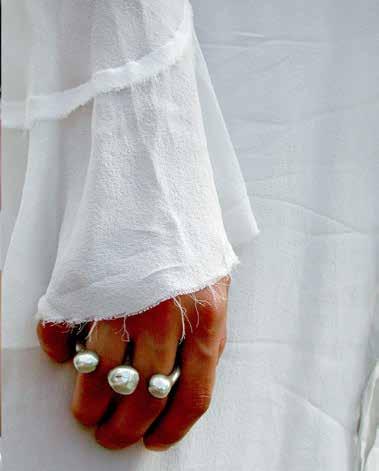
71 VOYAGER 3/2016
ALL ROADS LEAD TO … OPERA
DAVID SAKVARELIDZE
TUTTE LE STRADE PORTANO … ALL’OPERA
Opera had to be born in Italy. Opera, like Italy, unites other directions of art: painting, costume design, lighting, musical instruments, architecture, literature, the poetry of the libretto, compositional mastery, choreography, and finally, the human voice - the vocals.

When SOLO magazine approached me to write article about Italian opera, I was excited and felt a childish joy.
On one hand, I felt responsible; on the other hand, I knew it would be fun. This feeling is like remembering your first love - recalling your most cherished memories and writing about it. Italy is the most beautiful, interesting, cultured and wonderful country in the world. I have been in love with it for a long time.
They say all roads lead to Rome. Italy is the country to visit if you are interested in painting. Italy has the greatest architecture; Italy played an important role in history. Italy is also a leader in the car industry too.
Fashionable events took place in Florence in the sixteenth century: at parties at nobles’ palaces, dramatic readings of works of art would be paired with songs and instrumental accompaniment.
72 VOYAGER 3/2016 OPERA
Greek mythological stories and dramas were used for the song lyrics. A choir comprised of five or six singers performed harmonized musical compositions. These acts and songs were performed between the theatrical acts and were called the Intermezzi - musical compositions between the acts.
rigals, and got involved with a group of intellectuals called the "Florentine Camerata". The term "camerata" comes from the Italian "room" or "salon".
This group worked for the Medici family and sought to revive ancient Greek theater. Intellectuals argued that the
These intermedial songs become very popular; it was the period of remarkably sophisticated, exciting and technically perfected décor and scenic effects. Scenery, costumes, stage effects, and fireworks reached such high artistic quality that researchers are even following these early sketches and structures in modern theatrical stage technologies.

XVI-century Florence was host to a group of intellectuals who promoted the establishment of such performances; they created songs, madrigals, and texts.

One of the composers was Cristofano Malvezzi, born in Tuscany, in the town of Lucca (also the hometown of Giacomo Puccini). He later moved to Florence and led the Medici court choir; he composed some intermezzo, mad-
theatrical rituals of ancient Greece were finished with the song. The chorus and the orchestra performed it. Thus, the Greek theatre used works where the story could be expressed through song.

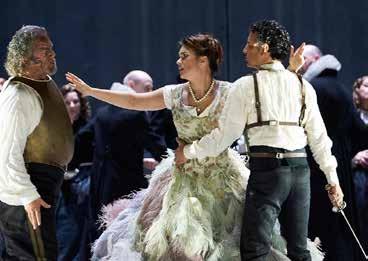


"Eurydice" is one such theatre piece, created in 1600 for a Medici wedding ceremony by the Florence-born composer Jacopo Peri. This was his second work – his first piece "Daphne" did not have any musical contours; thus, the opera historians believe that his second work, "Eurydice" is the origin of the art of opera.
The "Eurydice" Manuscript is perfectly preserved. Ottavio Rinuccini created it. This genre was called Drama per Musica ("music drama") but the word "opera" was not yet used.
73 VOYAGER 3/2016
In 1600, Maria de 'Medici, the daughter of Francesco I Medici and Queen Joanna of Austria, married the French king Henry IV of Navarre. The Camerata presented Jacopo Peri and Ottavio Rinuccini’s musical drama "Eurydice" at the wedding.
This performance saw the birth of a new genre of art, and Florence, my favorite city in the world, become the true cradle of opera.

Today several opera theatres operate in Florence. The oldest is the Teatro Della Pergola, which was built in 1656 by Cardinal Jean Carlo Medici. The second is the Teatro Comunale, built in 1862 as an open amphitheater for 6,000 spectators. Having been closed down due to a fire, the Teatro re-opened in 1864. The roof, electricity and heating were installed in 1911.
A world-renowned opera festival Maggio Musicale Fiorentino originated here. Zubin Mehta, a wonderful musician of Indian origin, has been its musical director for several decades. You may remember the famous concerts performed by “The Three Tenors” Luciano Pavarotti, Placido Domingo and Jose Carreras – these were planned and conducted by Zubin Mehta.
In 2017, Zubin Mehta will arrive in Georgia with the Israel Philharmonic Orchestra to perform at the festival hall of the

ZUBIN MEHTA, A WONDERFUL MUSICIAN OF INDIAN ORIGIN, HAS BEEN ITS MUSICAL DIRECTOR FOR SEVERAL DECADES. YOU MAY REMEMBER THE FAMOUS CONCERTS PERFORMED BY LUCIANO PAVAROTTI, PLACIDO DOMINGO AND JOSE CARRERA; THESE WERE PLANNED AND CONDUCTED BY ZUBIN META.
museum Tsinandali. I, as a founder of the festival, have already signed the contract. This will be a historic event as no such orchestra or conductor has ever visited Georgia.

Music historians sometimes claim that Claudio Monteverdi's "Orpheus" is the first opera. On one hand, this argument has various reasons: first, the authors never called "Eurydice" an opera; they mention their work as drama for music; second, Monteverdi significantly increased the orchestral requirements and many new nuances enriched the performances, which made it all the more perfect. The theatre in Venice was built for his operas;
Teatro San Cassiano (named after the district where it was located) was established in 1637, open to the Venetian public. The building belonged to the Venetian nobleman Tron. Many important operas premiered on this stage. Unfortunately, the building no longer exists. New opera houses were since built in Venice: Teatro San Giovanni Di Grisostomo, Teatro San Benedetto, and more.
La Fenice may be called the most important opera building in the world. It is the epicenter of the music world. When in Venice, make sure to visit it. If you are lucky, you might hear Georgian singers. The theater has a very interesting past.
Rossini, Bellini, Donizetti, and Verdi worked in La Fenice. Fire has destroyed the theater numerous times; after so many restorations, the people call it a "Phoenix". It was destroyed again by fire in 1994, which was a great tragedy for Italy. Luciano Pavarotti headed its restoration; he acquired the necessary funds in a short space of time and the theater rose from the ashes, stronger and more beautiful. Today La Fenice is the most important opera theatre in the world.
OPERA
Zubin Meta
Luciano Pavarotti
74 VOYAGER 3/2016
Arturo Toscanini
Most people know almost everything about the La Scala opera theater, located in Milan. It was built in 1778. Antonio Salieri’s "United Europe" was the first performance there. Salieri was later accused of poisoning Wolfgang Amadeus Mozart – a legend that has turned the former’s name into a byword for professional jealousy. In reality, he was a very successful composer. His work was most recently performed in La Scala in 2005, conducted by maestro Riccardo Muti.
La Scala is considered the peak of the art of opera. The are numerous reasons for this: it has hosted the most world premieres of some of the best-known opera composers, including Mozart, Rossini, Verdi, Puccini, Meyerbeer, Boito, Catalani, Ponchielli and Karlheinz Stockhausen.
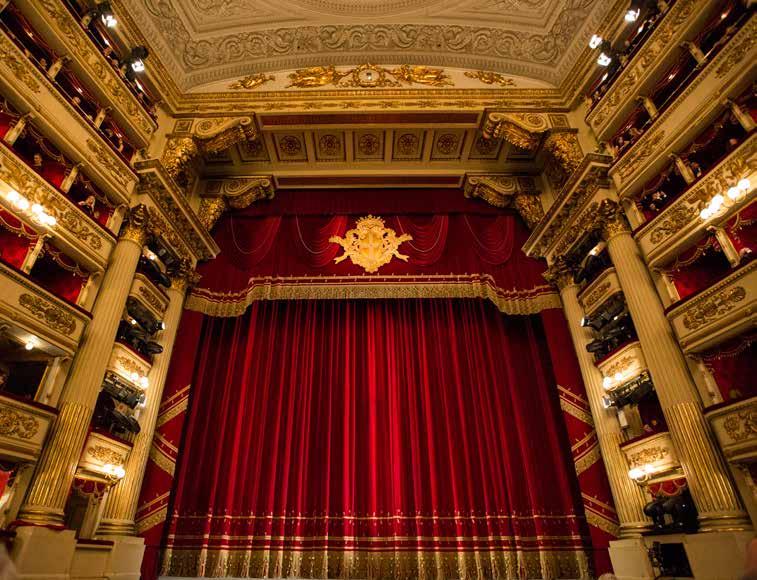
The excellent performance, organized theatre structure and system guarantees high quality. Its strong reputation has been built on its heritage of great musicians and conductors, including Arturo Toscanini who was the director of the theatre several times and revolutionized it, and has also benefited from Milan and Lombardia’s traditionally good economy.
This region has been wealthy for centuries. Its geography determined its economic prosperity as it borders with Switzerland to the north. Milan’s La Scala is an institution of national pride for the Milanese people. They try to make it economically sound. Many people have been visiting Mi-
lan to see opera performances for centuries. A new season commences every year on December 7 – St. Ambrosio’s Day.
Opera is a creative and technical endeavor; related professions are taught at the La Scala academy, thus ensuring the continuation of young skilled artists to guarantee a bright future for the theater.
Many opera legends have performed here. Three Georgian singers participated in one opera piece in 2015. Opera critics noticed it and wrote: "Could someone please explain what is going on in this small Georgia, the homeland to such singers?" When in Milan, observe the La Scala posters carefully, you will notice at least one Georgian name among the performers.
Every Italian city, town or village boasts at least one opera theatre. The number of these theaters is so large that theatre researchers have stopped counting them. Italian opera unites not only different art forms, but many stories, historical facts, political and social events; this is why I believe that learning about the history of opera provides an alternative way to learn about Europe and Italy.
Trust me, if you catch the opera virus, your life will become richer, more interesting and infinitely better! Sooner or later every road leads to opera because Tutte le strade portano … all’Opera.
THREE GEORGIAN SINGERS
PARTICIPATED IN ONE OPERA PIECE IN 2015. OPERA CRITICS NOTICED IT AND WROTE: "COULD SOMEONE PLEASE EXPLAIN WHAT IS GOING ON IN THIS SMALL GEORGIA, THE HOMELAND TO SUCH SINGERS?"
75 VOYAGER 3/2016
WHAT DOES BEING A 21ST-CENTURY ARISTOCRAT MEAN? HAVING A MUSICAL SOUNDING NAME? BEAUTY? GOOD UPBRINGING? ANYONE MAY HAVE THESE CHARACTERISTICS NOWADAYS. SO WHY ARE PEOPLE STILL INTERESTED IN PRINCES AND PRINCESSES IN THIS AGE OF POLITICAL AND ECONOMIC UPHEAVAL –DO PEOPLE STILL LONG FOR A FAIRY TALE?
Such thoughts played on my mind as I met Ketevan Bagrationi of Mukhrani and her son, Lelio Orsini. Suddenly, everything became clear, on that warm Roman spring evening.
Ketevan Bagrationi was born and raised in France. She married Raimondo Orsini, descedant of one of the most famous Italian noble families, and moved to Rome. Their children Lelio, Luisa, and Dorothea live in Rome, and look exactly like the beautiful princesses and prince charming from fairy tales.

Ketevan Bagrationi of Mukhrani:
"I grew up surrounded by old legends and photos: photos of St. Petersburg balls and parties at Mukhrani palace, residence of my great uncle Ivane of Mukhrani … that was the Georgia of our dreams.
Why didn’t I speak Georgian as a child?
My grandfather, George Bagrationi, passed in 1924. He was a handsome man, 2 meters 5 centimeters tall. When he was riding, his horse seemed small in comparison. He was heavily wounded in a battle with the Red Army. He was able to flee to Constantinople, passing through Batumi with his spouse and children. They travelled to Wiesbaden, since his father and mother, Alexander Bagrationi and Nino Tarkhan-Mouravi, lived in Switzerland. They sold all of their possessions during the journey, and had no means with which to survive. George Bagrationi died of gangrene due to belated surgery. His Ukrainian wife came from one of the wealthiest families in the Russian Empire (needless to say, everything was lost during the revolution). She didn’t have enough time to learn Georgian, and spoke to my father in Russian or French. This is why my father, who left Georgia at the age of seven, did not know Georgian well; he only remembered words that children use: milk, pants, etc. [laughs].
76 VOYAGER 3/2016
"ROME IS MY CITY, WHILE GEORGIA IS MY HOMELAND"
HISTORY
SALOME DADUNASHVILI
H.R.H. Princess Ketevan with her husband, H.R.H. Prince Raimondo Orsini D’argona and children: H.R.H. Prince Lelio Nicholas, H.R.H. Princesses Luisa and Dorothea Orsini D’argona. Rome, Villa Medici.
My brother and I had always planned to visit Georgia, so I started attending Russian Language courses in Bordeaux. Georgian was not taught. I obtained a scholarship to study in Russia. After eight months, I was finally granted right to come to Georgia in 1976.
THE "GEORGIA THAT I ENCOUNTERED AND THE GEORGIA THAT I IMAGINED PROVED TO BE ABSOLUTELY THE SAME".
This was a fairy tale; my dream come true. We travelled by train from Moscow. I heard the sea at night and asked one lady: "are we in Georgia?", and she answered, "yes, my dear, we are in Georgia". I still remember how strong my feelings were. All of the Bagrationi family met me on the platform, and suddenly I saw my father’s cousin, and he looked so much like my father that I got very emotional and could not leave the train.
Light is different in Georgia, and so is the wind; the wind is different. It tastes delicious. The wind is not delicious here. I did not want to leave Georgia, I was crying so much. My family was in France, my future husband was awaiting me in Italy, but I wanted to stay in Georgia. I almost got off the train several times".
Lelio: ”I was lucky as I went to Georgia when I was 10 years old. It’s difficult to explain. When a man meets a woman and they decide to be together…that’s how it was with Georgia.

Almost everything was familiar. Georgian culture was everywhere in our home. We often hosted wonderful guests from Georgia, and we constantly talked about the country. I loved my grandfather Constantine dearly, and despite the fact that there was an Italian father in the house, a Georgian man’s presence was evident”.

Ketevan: ”Oh, that journey was wonderful. We decided to follow the route that my father used to leave Georgia. We flew to Turkey and took a bus: my husband and me, our three children, one of them nine months old, two nannies, and 40 suitcases. The first bus was beautiful, the second was fine, but the third was horrible, it broke down. We almost didn’t make it to Georgia".
When her now-husband proposed, she answered that she had to visit Georgia first. Raimondo agreed, and observed his wife’s homeland with interest, knowledge and love. Raimondo Orsini D’argona supports Georgia. When the civil war began, he asked his spouse to visit homeland.
What does it mean to be an aristocrat today: is it a privilege, responsibility or punishment?
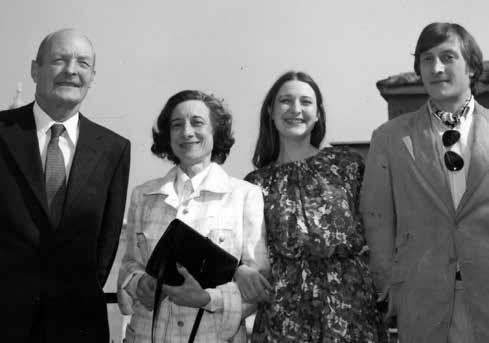
Ketevan: "It is not a privilege anymore, and does not imply influence in political decisions. Today it is a tradition".
Lelio: "Some families have existed for centuries. It is important to pass on traditions of history, love and respect. Material wealth does not carry meaning. We have a choice in this consumerist world: to get involved in the media circus, or to use our heritage to serve worthy causes".
ONE NIGHT, CONSTANTINE BAGRATIONI OF MUKHRANI HAD AN INTERESTING DREAM: A HUGE HAMMER AND SICKLE GLOWED ON A FOGGY MOUNTAIN TOP; THE HAMMER AND SICKLE SUDDENLY SHATTERED, AND THE MOUNTAIN TOP BECAME ILLUMINATED. CONSTANTINE REALIZED THAT IT WAS A SIGN, THAT HE WOULD ONE DAY RETURN TO GEORGIA. HIS CHILDREN KETEVAN AND ALEXANDER GREW UP IN THE AFTERGLOW OF THE GEORGIA DREAM. RETURNING TO HIS FOREIGN BUT DEARLY MISSED HOME BECAME PARAMOUNT FOR THEM.
77 VOYAGER 3/2016
2 1
3
1. H.R.H. Prince George Bagrationi of Mukhrani with his spouse in Poland, before the WWI
2. H.R.H. Princess Ketevan Bagrationi of Mukhrani with parents and brother, Rome, May, 1978.
3. H.R.H. Princess Ketevan visiting Georgia after the independence, with Nino Ramishvili, Tengiz Sukshishvili, and Inga Tevzadze (Ilia Dzenko photo)
Ketevan: "Lelio recently organized an interesting conference that aimed to promote Georgia. The conference covered Georgian history from Dmanisi to present. The world has to know about our contribution.
Lelio’s is educated in philosophy; he is a real Roman – he heads a real estate agency in Rome, and manages an agricultural enterprise in Puglia".

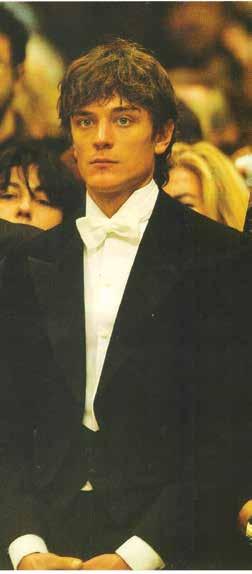
Where do you take your guests to enchant them with Rome?

Ketevan: "[We take them to] St. Peter’s tomb, which is located in St. Peter’s Cathedral. The enormity of the Cathedral makes it difficult to feel a sense of mystery, though St. Peter’s tomb is truly miraculous. Also, [we take them to] St. Angelo Fortress, since it is connected to the Orsini family".
Lelio: "The period of emergence of Rome is my favorite. The truth epoch is symbolic of the city’s antique past. St. George’s skull is kept at the nearby St. George’s Cathedral. This saint is very important for Georgia.
You will encounter all epochs in Rome. It is a mix of historical layers. You may see a residential home built upon an antique theatre. Old layers create new ones. That’s how it will continue always, and why Rome is an eternal city.
Rome and Georgia have always had close relations. I am very happy when I take my friends to Georgia and see their respons-
es. I am happy that Georgia is becoming ever-more beautiful. I liked it even after it was destroyed in the civil war, because the country’s beauty lies in its people and culture.
78 VOYAGER 3/2016 HISTORY
"WHEN A MAN MEETS A WOMAN AND THEY DECIDE TO BE TOGETHER… THAT’S HOW IT WAS WITH GEORGIA".
H.R.H. Prince Lelio Orsini D’argona
H.R.H. Princess Ketevan with her husband, H.R.H. Prince Raimondo Orsini D’argona
THIS IS WHY I AM SAYING THAT ROME IS MY CITY, WHILE GEORGIA IS MY HOMELAND".
FASHION & MAN
NINO DARASELI
Why is men’s fashion all over the world based on Italian traditions?
What is the secret of Italian-style clothing? How are elegance and simplicity combined?

Italian tailors and designers have been the unconditional leaders of the men's fashion industry and classical suits for a long time. The main feature of their work is a tailored fit on a man’s body. Italian pants do not wrinkle and a shirt cuff peeks proudly from a suit sleeve; shoulders are broadly set but the jacket fits closely.
It is known around the world that Italian men have an amazing ability to dress fashionably, elegantly, distinctly but at the same time, subtly. Only an Italian man can suddenly wrap a scarf around his neck in the middle of a walk and achieve a true aristocratic look.
Men’s suits managed to free themselves from intense colors and excessive decorative elements half a century ago. A desire to demonstrate one’s success without vivid symbols has since emerged.
Italian designers had to wage a small war in the 1980s to prove that men have the right to look attractive too.
The Italian suit style is known for its trendiness. The jacket is mostly a tailored fit and made of soft fabric, in a modern and fashionable style.
THE ITALIAN SUIT IS SHORT AND TAILORED FOR A CLOSE FIT; THE SHOULDERS ARE FILLED WITH PADS BUT THE BUTTONS AND THE BOTTOM FOLD ARE HIGHER THAN IN AMERICAN OR BRITISH SUITS. THE JACKET HAS A V-SHAPED NECK. UNLIKE THE BRITISH EQUIVALENT, THE ITALIAN SUIT IS MADE WITH SOFT FABRICS AND THICKER SEPARATOR STITCHING. PANTS HAVE A TIGHTER AND THINNER WAIST WITH THE FABRIC SITTING SNUGGLY ON THE HIP. THIS CONCEPT BECAME THE BASIS FOR MALE COLLECTIONS OF THE FOREMOST DESIGNERS, WHEN THEY STARTED TO CREATE SUITS WITH LARGE COLORFUL PRINTS, HYPERTROPHIC AND EASILY RECOGNIZABLE LOGOS OR GOLD-COLORED DECORATIVE ELEMENTS. SUCH REBELLION AFTER YEARS OF ASCETICS DROVE THE POPULARITY OF ITALIAN TAILORING.
STYLE
Modern Italian male fashion does not rule out bright colors even today. Handmade items are often used in collections. The fabrics are high tech, ultra-comfortable and therefore, exquisite. This clothing is attractive but does not stand out. The new Italian elegance is universal. Everything looks natural, simple and even affordable. However, there is one detail, which nullifies the affordable impression of Italian style: all of the fabrics in the suit must be of the highest quality and the work of the tailoring ideal.
They use traditional methods fully, as hand-tailored clothing is much more comfortable.
Italian fashion carries an abundance of colors, just like in the past. Designers use color with an amazing virtuosity in this country. This will not be surprising if we recall the lavishness of the color and beauty in which Italians have been living for millennia. Incorrect combinations do not exist in Italian design, as in the nature that surrounds them.
Lemons, sunburned grass, light-colored sea, lilacs and rust-colored mountains of Tuscany are all well reflected in the collections of Italian designers. They professionally use complex natural colors, which a priori complement each other. Hence they make buying easier for potential customers and increase sales for themselves.
Italian fashion fits all types of appearances, since Italians themselves are very different – the blond and pale population of the Lombardy and Piedmont regions look nothing like the dark-haired Sicilians and Neapolitans.
It seems like the washed-down colors of Milan and Venice are specifically intended for men with light eye and hair color; the rich color variety suits people with contrasting southern looks. The mixed options are ideal for Romans and Florentines. The new approach to matching dress codes and styles is also important. Fashionable designer and classical brands are continuing to approach each other. There is a growing amount of modern interpretations in designer collec-

80 VOYAGER 3/2016
STYLE
PITTI UOMO
Florence traditionally hosts Pitti Uomo – a men’s fashion exhibition. The guests and participants of Pitti Uomo compete with each other on the distinctiveness of their outfit and accessories. Pitti Immagine was first conducted on February 12, 1951. This date is considered to be the birthdate of Italian high fashion.

The 76th exhibition will take place this year on June 16-19. It will be dedicated to the key trends in men’s fashion for the Fall-Winter 2016 period. Contracts for the upcoming season will be signed during the exhibition.
tions. Classic male brands introduce clothing with a modern fit more frequently, in trendy or even avant-garde styles.
This is not only a way to increase customer base. The outfit that sits with equal confidence on the grandfather, son and grandson gives one the ability to extend one’s youth.
Mixing classic and casual has already defied conventional rules. Classic jackets already match well with a padded coat, while a woven textured jacket goes well with a formal vest and strict tie; flannel pants resonate not only with a cashmere coat but with a biker leather jacket. Such attire can be worn in a wide variety of ways when all items are of high quality, have fashionable proportions and fit and are made based on the classic male suit within the palette of natural colors.
Modern Italian style allows you to dress based on the principle of "whatever comes first in the wardrobe", but this principle works only when the wardrobe content is properly selected.
Italians love sunglasses. Luxottica, who owns the cult Persol sunglass brand, is the largest sunglasses company in the world. The six factories sell 7 billion euros worth of sunglasses annually.

The key recognizable feature of Persol are the yellow-brown colored crystal glasses – best for sunlight protection. Many Hollywood stars wear Persol sunglasses. Steve McQueen’s glasses from The Thomas Crown Affair have become one of the cult collectible styles. Both Pierce Brosnan in "Die another Day" and Daniel Craig in another Bond movie "Casino Royale" wore Persol glasses. Craig’s Bond wears various classical and modern styles in the films. It is known that Angelina Jolie’s favorite model is the black largesized Persol with the frame made from Italian materials and grey glasses. If we take a look at politicians, Ray Bans are worn by rightists while leftists opt for Persol.

81 VOYAGER 3/2016
ARCHITECTURAL RENAISSANCE IN ITALY
NICK CKHAIDZE
The 300-year Renaissance, or Rinascimento in Italian, is an important era in world history; it was the era that pulled Europe out of the dark Middle Ages, implemented new behavioral codes and moral principles, applied new outlooks and esthetics, and established the world as we knew it until the end of the twentieth century.
The Renaissance was chiefly an Italian event; this can still be seen among Italians today in terms of their attitude towards life and their world-view.
Europe experienced chaos during the Middle Ages. Small kingdoms chose new orientation according to the political changes of multiple polarities. Trade prospered in the cities. The bourgeois elite formed in the free cities and started accumulating capital.
Financially strong families started exerting their influence over their communities. They adopted ancient philosophies; at parties, philosophers like Marsilio Ficino would discuss the tastelessness of contemporary life, praise the brilliance of the past, and would charm wealthy citizens with ideas of antiquity.
The city of Florence became leader in finance and trade . The richest Florentine family, the Medicis, based their views upon the teachings of Plato and other
ancient philosophers. They believed that beauty depicts an orderly world and expresses God’s will on earth. The Medicis, like the Neo-Platonians, sought Christian goodness in beauty and order, harmony and rationalism, perspective and proportions.
Beauty, truth, and wisdom – that is the Medici credo. They believed good management to be imperative for creating harmony and tried to create as much beauty as possible through philanthropy. Like philosophers, they considered that by generating beauty and magnificence, they would revive the lost world of perfection and
knowledge. Thus, the term "Renaissance" means resurrection and rebirth.
The aims and demands of this period were clear – the creation of perfect architecture/ art using principles of classical esthetics. Consequently, this explains the concentration of so many geniuses in one place.
LET’S RETURN TO ARCHITECTURE
During this time the plague was upon Italy, and some 60% of the population died from this Asian disease. No craftsmen were left to carry on building. Architecture faced a dilemma: the empiric, gothic style was predominant and was centered on craftsmen’s ability: technique determined taste rather than the other way around.
Craftsmen were difficult to find due to the damage wrought by the plague and architects had to be imported. However, the new bourgeois elite and their philosophers questioned this pratice. Hence, architecture clearly reflected the fundamental outlook of the Italian trading elite. A competition for the construction of the entry door to the Baptistery of Saint John (Florence) was announced and the Renaissance began.

Where did Renaissance architects look to for ancient architecture principles and examples? Ancient Rome, of course! Architects, artists and sculptors visited the ancient capital and observed, analyzed and sketched what they deemed important to create new art. The most outstanding architects – Filippo Brunelleschi and Leon Battista Alberti – found their inspiration in the art of antiquity.
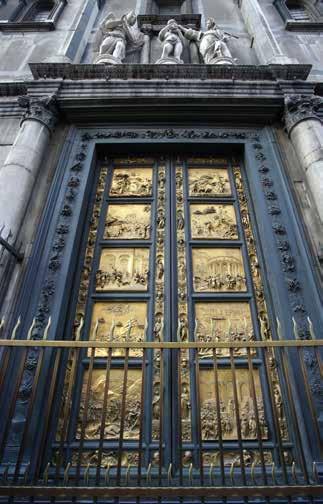
82 VOYAGER 3/2016
ARCHITECTURE
Baptistery of Saint John in Florence
"Ideal City" Piero Della Francesca
Order of antiquity
NEW PRINCIPLES IN ARCHITECTURE
Renaissance architecture borrowed a number of principles from ancient architecture – regularity, symmetry and proportion. It is hard for us to imagine how long it took to implement these principles, as our architectural environment already relies so heavily on them, largely as a result of the Renaissance. Until that time, everything was made using the empirical, medieval approach. Gothic architecture was empiric. A search for perspective played an important role in the implementation of this principle. Rulers and compasses were essential in the planning of buildings. This regular, rectangular typology was retained in church construction but was completely lost in public buildings, which were built chaotically and accordingly to their surrounding landscape.
The Renaissance brought back rigid geometric forms and angular connections. Non-regular planning became prohibited and façade designs were used recurrently. In the past, this principle was partly retained in religious architecture, while windows in public buildings were constructed chaotically. Afterwards, openings started following a straight line.


The "symmetry conception" was a product of a new reality. Buildings were now separated along central lines, resulting in functional rationalization.
Central facades were purposefully not separated, after the fashion of the ancient temples. This ensured that the symmetry of openings and main proportions – the calcu-
lated harmony – was retained. Proportions between different parts of buildings in relation to each other and their numerical formulas were the main focus of the Renaissance architects. Gothic architecture dealt with this issue simply by only taking into account the proportions of nave height and width.
Renaissance intellectuals believed in the sanctity of numbers. They regarded harmony as a calculated substance. The great architects of the Renaissance, such as Brunelleschi and Alberti, tried to calculate architectural harmony based on the ancient tracts concerning harmony in music. On outstanding architect, Palladio, refined this concept in his creations.
The idea of modular proportions finally pulled architecture out of the Middle Ages. Consequently, a new language of architecture was formed based mainly on the order system.
NEW LANGUAGE OF ARCHITECTURE
The new language of architecture that was formed during the Renaissance was based on a new interpretation of ancient forms. It mainly included columns, domes, ornaments and other decorations. Most importantly, the order system was formed – distinguished by its proportions and characteristic profiles and details, columns and pilasters (rectangular columns attached to a wall). The antique system was a mechanism for correcting visual imperfections while the Middle Ages architecture minimized techniques of correction.

Antique order columns stood on pedestals, like statues. Horizontal entablatures had three subdivisions: architrave, frieze and cornice. The entablature on the top of the column presented the transformation of ancient wooden architecture.
Filippo Brunelleschi, a super star of Renaissance architecture, sought to reestablish the classical order of antiquity. If you visit Florence, a fine example of this school of though is the Ospedale Degli Innocenti building. Its façade is an excellent example of free interpretation of the classical order. You may also notice similar interpretations inside the Basilica of St. Lorenzo, the Pazzi Chapel and numerous other buildings.
The architectural vocabulary of antiquity was revived for a long time. It is difficult for us to imagine a time without it as we live in architectural environments and cities that are established entirely on this vocabulary.
83 VOYAGER 3/2016
Medici Riccardi Palazzo, Florence
Palazo Rucellai
ARCHITECTURE
However, it was a revolutionary move at that time, and one that was difficult to execute.
Brunelleschi and his followers clearly understood that column proportions changed according to the ornaments used. The use of such ornaments was therefore labeled the "order system".
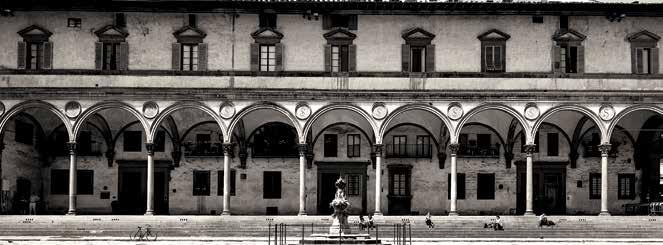
This idea is based on a simple optical illusion: if we look at the multistory building with equally-spaced floors, higher floors seem smaller proportional to the distance between us and the building.
The order system sought to correct such visual imperfections. Perfect proportion was achieved by increasing floor height from the bottom up. Order proportions and column types were strictly defined. Tuscan and Composite order was added to the three original ancient Greek orders (Doric, Ionic and Corinthian). According to the strict regulations surrounding orders, they had to form established proportions. Different models were based on the column diameter. These models were used for buildings of different height and function.
The architectural language of the Renaissance in also visible in other features of buildings of the time: domes, ornaments, rustication.
The Dome of Brunelleschi’s Cathedral of Santa Maria del Fiore is thought to be the most important dome of the Renaissance. It is one of the most beautiful features of Florence. Brunelleschi had never constructed a dome before and was able to complete this cathedral due to his relentless industriousness and imagination.
He constructed the dome on the existing open cathedral. Later, Renaissance architects declared the circular dome model to be the ideal building model. Antique ornamentation also found its way into the architectural glossary. Gothic fantasies
were replaced by strictly regulated, styled antique ornamental motifs.
The building process became more technologically advanced throughout this period too: ornaments were no longer carved on the surface but rather the surface was treated and spatial ornamentation took place. Rustication was applied to public buildings, having previously been used exclusively on military buildings.
One will encounter many rusticated palazzos in Florence (the residences of the city-dwelling bourgeois elite were known as a palazzo – a palace) despite the fact that their exterior are reminiscent of castles. Renaissance architecture lightened up these facades and rustication made palazzos more elegant.
NEW TYPES
Renaissance and Middle Ages buildings - churches, palaces, and castles - carried the same function. However, Italy added
two types of buildings to this list: villas (private home) and public squares. Buildings with traditional functions were modernized.
Brunelleschi’s innovations completely changed church architecture. He constructed the roof of the Santa Maria del Fiore cathedral in a Latin cross shape and built his dome on the intersection. Centralized (circle-shaped) planning was used for small cathedrals.

Such centralized planning was regarded as the ideal model for cathedrals. Michelangelo used this planning in many of his works, including St. Peter’s Basilica. However, "mixed" types were more common: centralized planning with the altar in the front part of the nave. A wide nave with a dome on top of the intersection of the nave and transept became the basic model for churches. Classical elements features on church facades.

84 VOYAGER 3/2016
Ospedale degli Innocenti, Florence Santa Maria Del Fiore, Florence
Piazza Del Campidoglio, Michelangelo, Rome
The above-mentioned palazzos, homes of the Italian bourgeois, formed the main type of civic architecture. A palazzo typically had a rectangular form and contained a wide courtyard connected to the main building via loggias. Despite the fact that most palazzos are located in Florence, the ideal model - Sangallo’s palazzo - is


Using pools and jets of water and organizing central lanes and lines of trees is best exemplified by the Tivoli gardens in Rome and the Boboli gardens in Florence, both products of the Renaissance.
The Italian Renaissance also accounts for one of the most important elements
that globalization has on the planet today.
Building construction went hand in hand with urbanization. The Renaissance patrons knew that orderly and harmonious cities formed populations with the same traits. Ambrogio Lorenzetti’s fresco "Good and Bad City" in the Siena palazzo depicts two cities: chaotic versus organized build-
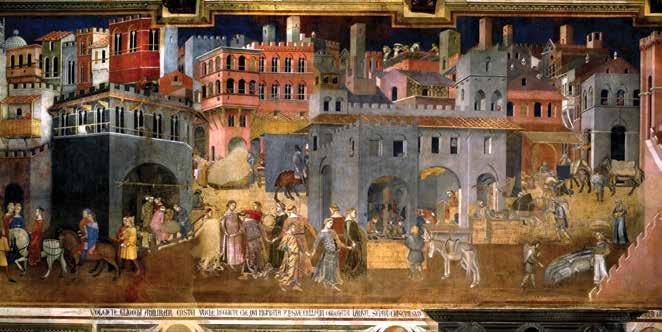
built in Rome. The Renaissance palazzo interior contains lighter classical elements, which nonetheless look quite rigid, giving palazzos special charm.
Private houses, or villas, were another gift of the Italian Renaissance. Architects erected the first villas by Lake Como and other picturesque places. When it comes to villas, no architect can come close to Palladio. He mastered the proportional system in his creations. His villas did not consist of separate buildings but presented harmonious unity with the environment.
Wonderful examples of gardens and landscape architecture were created during the Renaissance as well. Landscape architecture developed further, culminating in the beautiful baroque style of garden.
of urban architecture – organized public squares. Piazza San Marco in Venice and Piazza del Campidoglio (Michelangelo) brilliantly depict the importance ascribed to public squares in that period. The idea that not only a single building but the city as a whole required exterior correction was also formed during the Renaissance.

THE RENAISSANCE, ARCHITECTS AND ITALY
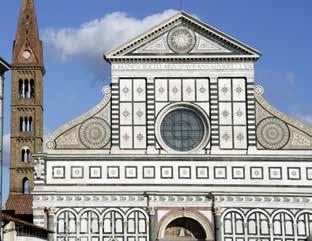
You need to travel to Florence in order to see the main Renaissance creations. Florence is a perfect actualization of Renaissance ideals. Everything is imprinted with emotions. It depicts a period of genius competition that defined the lifestyles, thinking and tastes of modern Europe. These new ideas and creations changed the world eight centuries ago with the same force
ings. The people in the fresco correspond to their cities. This is why Renaissance thinkers deemed the creation of ideal cities to be of paramount importance.
What is the Renaissance and what should we see while visiting Italy? The whole country bears the marks of the Renaissance, especially the north. No matter where you are in Italy, you will feel the soul of the Renaissance and bear witness to the fruits of its ideas. You will see amazing creations of people who believed that nothing is impossible. You will understand its importance and its influence on our thought process and outlook on life. However, you may feel disappointed that society did not maintain the Renaissance ideas. The philosopher Alain de Botton said, "They don’t need us, we need them. If we could see the world through the Renaissance notions, we would create a far more beautiful world".
85 VOYAGER 3/2016
Santa Maria Novella, Florence Palazzo Farnese
Villa La Rotonda, Antonio Palladio
Ambrogio Lorenzetti fresco "Good and bad City", Siena
Piazza Del Campo, Siena
MADE IN ITALY
MARIKA SHALIKASHVILI
A car provides the means to demonstrate wealth, power, and influence. Owners get judged by their cars; they often reflect the owners' personality and character. In the world of the rich, a car is an object of competition.

86 VOYAGER 3/2016
VEHICLES
What can a car tell about the owner and where does one draw a line between needs and wants?
Is car a source of transportation or an object of vanity? Pragmatic people believe that there is no need to own an expensive 320-horse-power toy, in the environment where you can’t speed up for more than 60 km/per hour.
However, some like speed and adrenalin, some like to collect and some simply like to display their egos. Car business is one of the most developed in the world, Italy, a veteran manufacturer country being a prime example. You may encounter museum pieces driving around the Italian Riviera, Milan, Rome and Florence.
One such veteran, Fiat concern originated in 1899, on Dante Street, in Turin. The company was founded by a group of investors, including Officer Giovanni Agnelli. His assembly was based on the military order and discipline.
Fiat manufactured airplanes and tanks during the WWI. It held the market monopoly in 1980ies. This brand has gained "European Automobile of the Year" award 12 times since the 60ies. Fiat engineers are called the craftsmen of the car world. The Fiat 500 is the classic Italian car. It became an icon in 50-60ies and broke all the photo shooting records - it is the subject of numerous tourist photos. Historical Fiat center is open in Turin since 1963. It exhibits collection of models, relics, archives and posters.
RAISED IN NEW YORK, THIS ITALIAN INNOVATOR CAME UP WITH SEVERAL ORIGINAL PAINTWORKS, USING SOME OF THE COMIC BOOK COVERS. LAPO ELKANN’S HAS BEEN COLLABORATING WITH FERRARI SINCE 2011. HE GIVES THE CAR-OWNERS OPPORTUNITY TO PLACE ANY IDEA ON THE SURFACE OF THE CAR.
The automobile business was transformed both technically and design-wise. It has reached the peak in the 21st century. It seems that a surprising advance is hard to come by in this epoch of innovations, though the "Garage Italia Customs" accomplished just that. Giovanni Agnelli’s (the company founder), grandson, Lapo Elkann’s idea broke all the stereotypes and pushed the limits. Instead of matching clothing to the car, now anyone can match car to the clothing and "dress" the car according to their taste. Classic and modern combination – black and white and a famous geometric pattern known as pied-de-poule in the fashion world got established during the reign of Eduard VIII in Scotland.
After the WWII, leading brands started employing this combination. Today the pied-de-poule pattern is used in car design, thanks to Lapo Elkann’s creativity. It was first used on the Fiat 500, a car that is the calling card of Italian automobile industry. He demonstrated that nothing is impossible.
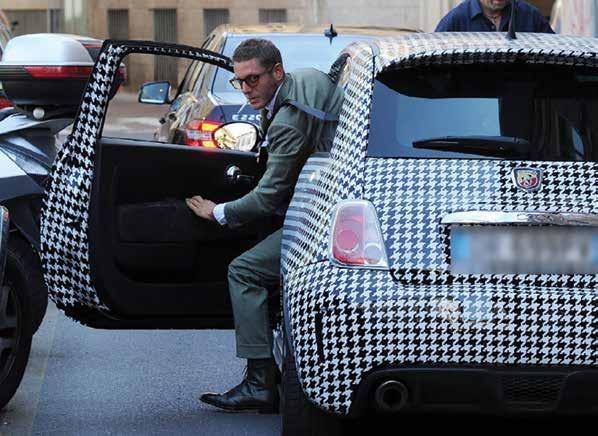
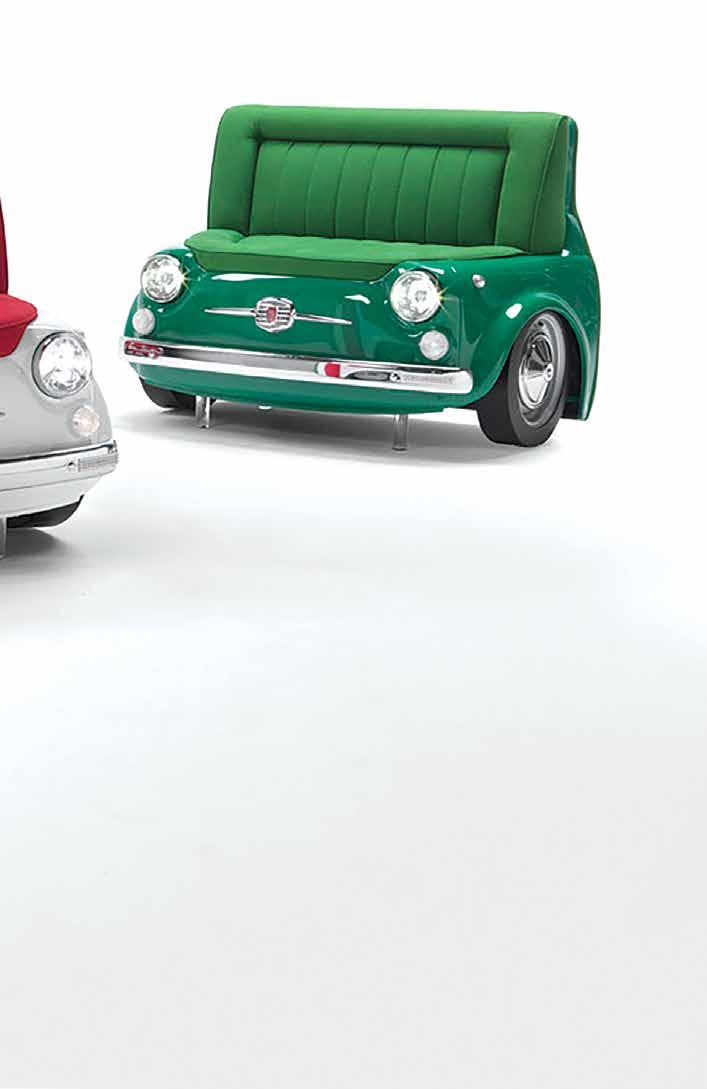
87 VOYAGER 3/2016
ITALY IS THE CENTER OF EUROPEAN CAR WORLD. "MADE IN ITALY" IS A QUALITY REASSURANCE STATEMENT. DESIGN, SPEED AND TECHNOLOGY ARE EQUALLY PERFECTED HERE.
VEHICLES
THE FERRARI 250GTO WAS MADE IN 1963. IT WAS SOLD FOR A RECORD PRICE – 52 MILLION DOLLARS IN 2013. IT IS THE MOST EXPENSIVE CAR IN THE HISTORY. ANONYMOUS BUYER RECEIVED THE CAR FROM A PRIVATE OWNER. IT WAS A RED FERRARI, 5111 LICENSE PLATE. THIS MODEL COST 18000 DOLLARS 50 YEARS AGO. ONLY 39 OF THEM WERE MANUFACTURED.
FERRARI
Ferrari is the first vehicle that comes to mind when thinking of the Formula 1 rally. Ferrari Museum in Maranello is a real heaven for the car-lovers.
FERRARI, LAMBORGHINI, MASERATI, ALFA ROMEO, FIAT AND LANCIA – THESE ARE THE BRANDS THAT MADE ITALY INFLUENTIAL IN THE AUTOMOBILE INDUSTRY.
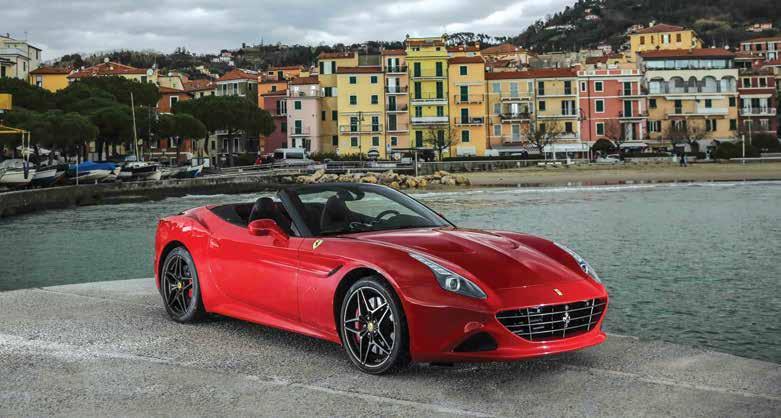

A tour of the Ferrari Gallery is a must for tourists; it hosts 240 000 visitors annually. The museum exhibits Ferrari models that left a mark in history, like the first model, the 1947 Ferrari 125; it also displays cars that have won the Formula 1 and were driven by different famous racers. The model workroom of the Ferrari founder, Enzo Ferrari is the treasure of the museum.
Enzo Ferrari, an Italian race car driver and constructer, debuted in 1919. He was hired by Alfa Romeo as a test pilot. Ferrari worked in Alfa Romeo for 20 years: first as a driver, then as a director of the sport department. He founded Scuderia Ferrari in 1929.
In the beginning, Ferrari manufactured race cars only, then he turned the company into a sports car brand. It became the leading manufacturer in the industry. Enzo Ferrari died when he was 90 years old. Roberto de Niro will star in a Hollywood biopic dedicated to this entrepreneur.
ALFA ROMEO FOUNDERS, ALEXANDRE DARRACQ, UGO STELLA, AND NICOLA ROMEO AIMED TO MANUFACTURE PRESTIGIOUS SPORTS CARS. BRAND HISTORY INCLUDES PRODUCTION OF WEALTHY CARS AND RACE CARS FOR THE FORMULA 1. IT HAS ALWAYS BEEN AN INNOVATIVE BRAND.
88 VOYAGER 3/2016
MASERATI
This Italian brand became famous for its exclusive sports cars, in the beginning of the XX century. The Maserati brothers started the car manufacturing in 1914, in Bologna.
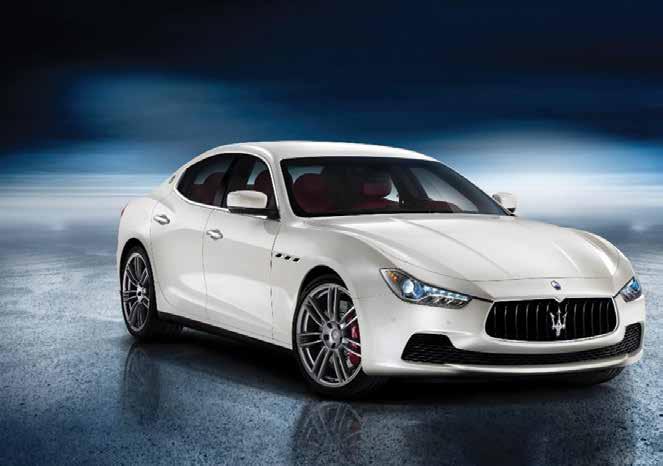
Maserati Bora is the most successful model that competes with Ferrari and Lamborghini. This 70ies sports classic was designed by the legendary Giorgetto Giugiaro. Maserati Quattroporte is a four-door sedan. It is not only the symbol of Maserati, but also the most exquisite Italian car.
Presently, Fiat owns Maserati, with annual turnover of 8000 cars. 5 years ago, Maserati presented the first concept model - Kubang - a synthesis of the past and future.
LAMBORGHINI
Lamborghini Automobili is one of the leaders of the car world. It is also called the choice car of successful people. Ferruccio Lamborghini was the founder of the brand.

• Lamborghini Veneno is the most expensive Lamborghini car. Only 3 cars were made, each costing 4 million dollars.
• The most expensive Italian handmade cars are: Lamborghini Reventon – 1 million 600 thousand dollars with 6-speed e-gear 6-speed manual transmission and Ferrari Enzo: 700 000 dollars; max. Speed –320 km/hour. Only 15 cars were made.
• Pagani Huayra is the fastest Italian car, often called the "Speed God". It is made entirely of the carbonatrium, the sturdiest and light material. This car weights 1350 kg. the engine: AMG 6000 cc bi-turbo V12, speed _ 371.76 km/per hour; Ferrari LaFerrari engine - 6.3 L V12, speed_ 349.23 km/ per hour; Lamborghini Aventador (2011 ) engine 6.5 L V12, speed 349.23 km/per hour; reaches 93 km in 3 seconds.

He was already a rich entrepreneur when he decided to manufacture the most expensive sports car. His idea was received skeptically in the 1960ies but 50-year-old Lamborghini was sure that he wanted to compete with Enzo Ferrari. He observed his factory (located 50 km outside of Bologna) work for almost 24 hours and when something went wrong, he pulled up his sleeves and got involved in the process.
The brand became famous in 1966, when it manufactured the Miura. It became the car of an era. 10 years later, Countach became the dream car for speed-lovers. Its design is used by many companies today. It was the first model to use the "lambo door".
89 VOYAGER 3/2016
VEHICLES
THE VESPA COUNTRY
Vespa scooter is the main symbol of an elegant, free and riding Italy. It is emblematic of a post-WWII, prosperous Italy. The Vespa scooter was designed by an aviation engineer Corradino D'Ascanio, 70 years ago. He believed that Italians had to have comfortable means of transportation, available for all.
Vespa had to accommodate both men and women and was supposed to be easy to operate and provide an additional seat.
"I imagined a person that was sitting comfortably, then I sketched a wheel in front and behind him, put a protective cover around and the design was complete" – this is how the engineer describes his scooter.
Vespa models have been changing from the 1940ies to the present day. 17 million scooters ae now part of the history. Italy is often called the Vespa country. It caused a social revolution and became an integral part of the "dolce vita"; this is why many famous Italian directors placed it in their films.

Luxury stretches beyond the Italian race cars, as evidenced by the Italian yachts, an object of interest for many famous people. Leading Italian designers are proud not only of their brand line, but also of their exclusive yacht collection.

Giorgio Armani’s yacht was being constructed for 3 years. Armani and Milanese architect Giancarlo Ortelli designed it. The mega yacht was built by the Codecasa Yachts of Viareggio Toscana company and it cost 60 million Euros. The yacht owners, Dolce and Gabanna called their boat "Italian Queen". It is their 51-meter-long kingdom on water. It unites 4 hotel apartments, equipped with gyms. Roberto Cavalli owns a 42-mter-long yacht, adorned with gems, silk drapes, cheetah prints and snakeskin chairs.
Valentino’s yacht carries the name "T. M. Blu" in honor of his parents, Teresa and Mauro Valentino. It was constructed by Perini Navi Group in 1988. Yacht is decorated with Picasso and Warhol art pieces. Princes Diana often visited it.
Leonardo da Vinci’s "Atlantic Code" contains a sketch of something that resembles modern bicycle: two wheels, wooden axis, steering wheel and chain that connects pedals to the rear wheels. This sketch never left the paper.
First bicycles appeared in Europe in XVIII. Italy started manufacturing bicycles in XIX century. Annual race Giro d'Italia covers most of the country and continues for 3 weeks. Italian race cars have been partic-

RIVA ITALIAN YACHTS ARE INDIVIDUAL AND EXQUISITE, THUS MAKING RIVA SYNONYMOUS OF ELEGANCE AND HIGH CLASS. THE HISTORY OF THIS LEGENDARY YACHTS BEGAN 100 YEARS AGO. THIS BRAND IS KNOWN FOR A PERFECT BLEND OF TRADITIONAL AND CONTEMPORARY TECHNOLOGIES. CELEBRITIES THAT HAVE MADE THEIR MARK ON THE XX-CENTURY HISTORY HAVE OWNED THESE YACHTS, AMONG THEM: ARISTOTLE ONASSIS, BRIGITTE BARDOT, AND PRINCE RAINIER OF MONACO.
ipating in famous races for years and the famous race track is one of the best in the world.
90 VOYAGER 3/2016
TIFOSI ITALY
BIDZINA BARATASHVII
Soccer is the love of every Italian man’s life. The majority of women are not indifferent to the number one sport either; And the women who claim the opposite, do so due to their husband’s negligence during matches!
Italian football is an integral part of Italian life. Only here can Paolo Rossi – a football icon from yesteryear - be imprisoned for fraud, released from prison, and sent back to the World Cup to be turned once again into an icon. Here the city's patron saint was "bribed" by a promise to buy the local team Eusebio. You’re only allowed to support the opposing team when the opponent is Maradona!
They say that sports and politics are incompatible. That’s true in theory, while in practice sport and, above all, soccer has repeatedly been the political playground. After all, it can bring huge dividends! The Italians were the first to understand this...

A team from England, the birthplace of soccer, visited Rome in May 1933. British visitors were offered a cultural program, including meetings with Pope Pius XI and the nation's leader, Benito Mussolini.
The official version was that “Il Duce” was the #1 "tifosi"; he cheered for the Fascist-founded "Lazio" and later started supporting his native "Bologna"; it demonstrated its fi-
delity by winning six championships. However, naysayers claim that the dictator did not like soccer - he was an apologist for ancient Rome and tried to replicate everything Roman, and soccer could never fit into this concept.
However, the insightful dictator realized that the entertainment of the XX century had a structure different from antiquity; soccer was a modern magnet for attracting the masses – masses who had to form a main pillar of the new regime. Right after winning the 1921 elections, the national and fascist party leader came up with the perfect plan on how to achieve a bright future: total tyranny and country-wide "soccerization". Italy began the construction of stadiums and training bases which proved to be the right decision - Mussolini conquered the world on the soccer fields and beat his ally Hitler.
This triumphal move was not easy. The selection of a qualified coach posed the first challenge. Luckily, such a specialist was soon found - a young enthusiast by the name of Vittorio Pozo, who had gained experience in Lon-
SPORT 91 VOYAGER 3/2016
don and Manchester. In any case, Mussolini paired him with the "Genoa" English coach William Garbati and sent them to the 1924 Olympic Games to win. However, the quarterfinals against Switzerland in Paris shattered this "dream".
After four years, "Skuadra Azzurra" equally competed with the Olympic and world champion Uruguay in Amsterdam. Italy was defeated with a minimum point difference: 2-3. By that time, Mussolini launched his knowhow "oriundi," system, which involved the repatriation of foreign players (mostly South American) with Italian roots to draft them into the national team.
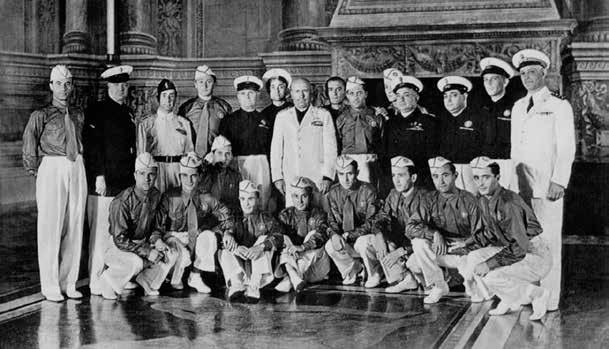
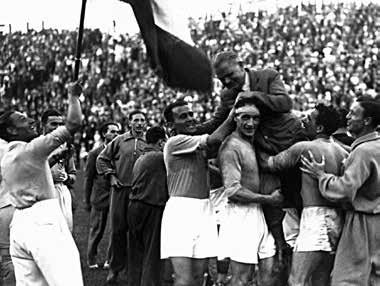
The result of this experiment became apparent in the 1934 World Cup appearance, where Pozo brought in four Argentineans. Despite the improved game, Italy had a hard time winning but Mussolini so intimidated (or seduced) the Swedish referee Ivan Eklind that he judged a “one-sided match” during the match with Austria and during the Finals.
History repeated itself in 1938 in Paris. Hitler claimed that 60 million Germans, not 11, would play in Paris (thousands of Germans did arrive in Paris, but not to play soccer; they rode tanks instead). As a result of the Austrian Anschluss, strengthened Germany suddenly choked during a match with the "dwarf" Switzerland in the play-offs (the Fuhrer refused to eat vegetables for five days to emphasize the number of missed goals). Thus, Italian black T-shirts gave the fascist salute during the final; moreover, it ruined the Fuhrer’s domestic Olympics too, by winning the gold medals (Germany was beaten, the Fuhrer fled the stadium and refused to take his dinner that night). Before the Paris game, soccer players received a telegram from Il Duce: "Victory or death!" Later, the Hungarian goalkeeper Antali Chabot was heard saying “Yes, I missed four goals, but saved 11 lives”.
Silvio Berlusconi carries on the Mussolini method in Italy's modern political history: just like Il Duce, he saw the career development opportunities in soccer and to this end bought one of the country's most popular but ailing clubs, "Milan", in 1986. The club had just returned from the B- series, and fans obviously hated the previous utterly incapable presidents, Giuseppe Farina and Rosario Lo Verde.
A young theorist coach Arrigo Sacchi was Berlusconi’s "Pozo", who was assigned to rebuild the "super club". There was no need for the "oriundi" – he provided this line by importing a trio from the Netherlands (Van Basten, Gullit, Rijkaard). The first one received three golden balls as the best European player of the year and Gullit received another one, while all of them led the club into two wins of the Italy Championship, two European Cups and an Intercontinental Cup.
Berlusconi formed his own party for the 1994 national elections named after stadium slogan Forza Italia ("Go, Italy!"); he befriended Mussolini's successor neo-fascists, received a record-breaking 43% of the vote and settled on the Prime Minister's chair for the first time (only to return three more times). This victory was signed on March 27, 1994, while the new "Milan" won over the star-packed "Barcelona" in the Champions League final in Athens, and dominated to win 4-0. This is how he got elected. The next victory (2003) coincided with Berlusconi’s second premiership (2001-2005), as did the next (2007) victory with his triumphant 2008 campaign.
Italian soccer is very similar to the Italian character. In general, Italians lack any idea of a national identity. Locals regard themselves as Romans, Milanese, Florentines, and Sicilians in the first place and Italians second. Highways, railways and the Catholic Church is what connects
92 VOYAGER 3/2016
1. Vittorio Pozo and the national team after the victory over the Czechoslovak team.
2
2. The Italian team victory in the 1938 World Cup.
1 SPORT
Turin and Bari, Naples and Milan and Trieste or Palermo. Additional connections are difficult to see.
Soccer fans act accordingly: they have a favorite team, they admire it and all the rest are despised; they perceive people from other regions as outsiders and same-city dwellers as enemies.
I remember a story that took place in October 2003; the former Italian Olympic Committee President Mario Peskante visited us. A Champions League match was being broadcast – Moscow “Locomotive” vs “Inter” Milan – as we were drinking coffee in my office. In the second half, Mikhail Ashvetia scored against the Italians. The score turned 2-0. Imagine my surprise and shock when a 65 year-old Signor Peskante started screaming with joy and ran in the hallway. His daughter Kristina told me that her father was fan of Rome, “Lazio”, and hated all other Italian teams.

Similarly, two years ago “Reuters” Regional Director Massimo Di Gregoriom (who hates “Lazio” and supports “Roma”) told me that they are a idiots – they could have named the team “Roma” but they named it “Lazio” instead!
Italian regional insularity is easy to explain: the country only united as a single country in 1861; its history before then was therefore the history of independent counties and municipalities with plenty of wars amongst themselves. Uniting them together as one nation was thought to be almost impossible.
The Risorgimento (National Union) leader Camillo Cavour’s famous claim reflects this complex process: “We have sculpted Italy, more or less. Now let’s create Ital-
ians!” I suspect if Cavour were alive, he would be involved in this work even today.
Italian patriotism mainly comes to life during national team matches. In such cases, tifozi “forget their region and devoutly support “Skuadra Adzura” like those played by Nino Manfredi in the film “Bread and Chocolate”.
But here, too, not all is certain! The north/south rivalry is above everything else. This was the case during the 1990 World Cup in Naples, where the city hosted Argentina. Diego Maradona, an idol for the people of Naples, reminded them of the “treacherous northern” indifferent attitude towards them, and more than half of the public who came to the stadium supported Argentina…and he won!
On the other hand, this feature of the Italians helps avoid chauvinism and militarism. Italians believe that any kind of confrontation is disastrous, and that conflicts can be solved through negotiation, or – in extreme cases –through bribery.
So much for the notorious “calciopoli” root cause. Unfortunately, dishonest games happen in all countries across the world; however, these cases are investigated in Italy and the culprits punished. In addition, the rehabilitation of offenders in the community goes smoothly. In 1980, Paolo Rossi was sent away for soccer match-fixing; he came back and helped Italy win the World Cup just two years later.

93 VOYAGER 3/2016
1. Silvio Berlusconi, Arrigo Sacchi and Franco Baresi. 1990.
2. Paolo Maldini celebrates Champions League win. 1994.
1 2
AN EVIL THING
A number of Italian political films were screened in the 1970s. They were heavily edited, selected and dubbed but still, they were presented on TV and in movie theaters and you got the sense that nothing was well in Italy. It was all bad, actually: communists and fascists with their machine guns, people in the middle, the government on top, and the horrible mafia monster devouring everything.
The worst things about these films was that the good, righteous rebels always died. They were murdered. While we were watching these movies, a war took place in Italy. A real war.
Terror walked up and down Italian streets. Finally, the Reds killed Prime Minister Aldo Moro. Sicily was also at war. A different kind of war. Man, did they kill. They murdered journalists, prosecutors, businessman, and judges. These films did a good job depicting the woes of righteous men.
Movies carried a sense of an evil force that participated in government and politics and permeated everything. It was omnipotent and unseen; it used politics and generally everyone; murder was no obstacle.
Damiano Damiani was a craftsman of that genre and his TV series provided the perfect closure. They were broadcast towards the end of the Soviet Union. He shot only the first season but it choked Soviet viewers like an octopus.
This is how the story went: it all starts with Corrado Cattani being appointed police commissar in Sicily. The series depicted a dead-end lot better than all of the films we had watched before, though finally the commissar had fought so much, got so miserable that everything turned conventional. Maybe not really but it did look conventional.
Well, of course these series depicted a famous cancer – the Sicilian mafia.
IT TURNS OUT THAT AMERICAN SYNDICATES WERE ALSO CALLED MAFIA: IRISH MAFIA, NIGERIAN MAFIA, MEXICAN MAFIA AND SUCH. THIS WORD SURPASSED THE PRETTY ISLAND. AND COSA NOSTRA IS NOT THE ONLY ITALIAN MOB. CALABRIA HAS NDRANGHETA, CAMPANIA CAMORRA. AND SO IT GOES, ALL OVER THE SOUTH.
Each mafia has its own story; nonetheless all of them originated in the middle of the nineteenth century. It happened differently everywhere. In some places, it was the child of the city; elsewhere it was the product of a little town.
Yes, they claim that the mafia has always been around, but really, it started in Sicily after the island got absorbed into a newly-formed Italy.
ISLAND.
THE ETYMOLOGY OF THE WORD "MAFIA" IS UNKNOWN. PEOPLE LOOK FOR ARABIC, GREEK AND SICILIAN ROOTS, THOUGH MOST LIKELY IT COMES FROM THE WORD "MAFIUZU", MEANING THIS TOUGH GUY, YOU KNOW THE ONE THAT IS OH-SO-MANLY.
94 VOYAGER 3/2016
MORCHILADZE STORY
AKA
THE MAFIA IS A SICILIAN THING, I BELIEVE IT IS SPECIFICALLY WESTERN SICILIAN. THEY CALL IT COSA NOSTRA ON THE
At first, it was about land and safety. Almost no police existed in Sicily and property regulations pushed land-owners to seek protection. This is how the bands were formed, mostly including peasants. The seniority was created based on the military model. Then these gangs started making money and formed hierarchies amongst themselves.
This is the time when they probably became named mafiuzu. After a while, it became apparent that formal governors and legislatures were on one side and the real and non-formal rulers were on the other. The mafia divided valleys, cities and villages, something that the government was unable to accomplish. Nothing surprising there.
This is what they named the Cosa Nostra – Our Thing. The Cosa Nostra members called themselves dignified men. They were united under secrecy, called omerta.
Sicilian emigrants transported the Cosa Nostra to the US and world history began here. But, that’s another story. The US is very big and different. The Italian mafia started mob adventures in the big cities. This became depicted in books and films under a veil of romance and melodrama.
The time came when the mafia got destroyed in the states, though the popular films prevailed. Conversely, mafia art was never romantic or melodramatic in Italy. It was always dramatic, even in TV series.
That’s not surprising – American mafia history is centered around WWII and takes place in the big cities, with the Italian mafia affecting every facet of real life; it is prominent even now, though much less, of course.
ITALIANS DON’T LIKE TO TALK ABOUT THE MAFIA. FOR SOME REASON, FOREIGNERS LIKE TO BRING IT UP, LIKE IT IS A PICTURESQUE THING. BUT ITALIANS DON’T LIKE IT. THEY HATE IT AND THEY TRY TO ELIMINATE IT.
THE MAFIA IS WILD, DARK AND CRUEL. IN THE END, ITS MAIN AIM IS TO MAKE EFFORTLESS MONEY. THE MAIN PROBLEM IS THAT THE MAFIA WANTS TO MAKE MORE AND MORE MONEY: THE MOB SEEPS THROUGH EVERY CRACK.
Most mafia bosses are illiterate people that were brought up in poverty, in peasant families; they participated in gangs from their boyhood and started their clandestine career at the lowest level – racketeering and murder. The mafia is relentless; it looks horrible from the outside but is far more dangerous on the inside. When your finger pains you, better cut off the hand.
Sicily has finally won over the mafia. Well, not Sicily, the government, along with Sicily. Today’s Cosa Nostra is a defeated party. It may never die, but it is sick and on life support. That’s a great victory.
Many people worked to accomplish this. Many good people. Many died. Finally, the mafia is not present in the streets anymore and big bosses (those that managed to escape) have been hiding in cellars and remote farm cabins for years.
"Thousand Days of Palermo" was one of the old political films. Lino Ventura played the legendary General dalla Chiesa. The film was nothing special; however, the story is real.
General dalla Chiesa became famous for opposing the Red brigades. He was appointed as a Palermo prefect in 1982. Palermo was an undefeated fort at that time; the Corleone and Palermo mafias were at war and since the mafia soaked up everything, the war concerned everybody.
This is what judges, politicians, journalists and prosecutors had to deal with. The government tried to eliminate the mafia through this war. It resulted in many victims and life became unbearable. Dalla Chiesa decided to strongly oppose the mafia. The mob hates when someone is researching it. The general and his wife were murdered four months later.
This war stretched for a while and the Corleone mafia won (Michael from the movie would’ve been proud). The mafia people claimed that there were no winners and losers, since all who lost were dead.
This cruel and stupid practice is Italy’s gaping wound. It contains feudal traditions and means killing half of the city to control the illegal cigarette business.
GENERAL DALLA CHIESA WAS ADVISED TO PUT PRESSURE ON PRISONERS TO LEARN MORE BUT HE SAID: “ITALY CAN SURVIVE THE DEATH OF A PREMIER MINISTER, BUT ITALY CANNOT SURVIVE TORTURE”. I BELIEVE WE SHOULD OPPOSE EVERYTHING EVIL IN THE SAME MANNER.
95 VOYAGER 3/2016
FOREST AREA: 104 675sq.km.
LENGTH OF THE COASTLINE: 7375km
AREA OF PROTECTED TERRITORIES: 63 791sq.km.
OUT OF 14 VOLCANOS, 3 ARE ACTIVE. ALL 3 OF EUROPE’S ACTIVE VOLCANOES – ETNA, STROMBOLI AND VESUVIUS – ARE IN THE SOUTH OF ITALY.
39% OF ITALIANS REGULARLY ATTEND SUNDAY WORSHIP
ITALY
ITALY’S GROSS AREA: 302 071sq. km.
POPULATION: 60 795 612
30 862 EURO - PER CAPITA GDP IN THE NORTH OF THE COUNTRY
17 416 EURO - PER CAPITA GDP IN THE SOUTH OF THE COUNTRY
AVERAGE MONTHLY OUTGOINGS FOR A FAMILY WITH TWO CHILDREN IS 3,237 EURO.
FOREIGNERS WHO ARE PERMANENT RESIDENTS OF ITALY: 5 014 437
61% OF ITALIAN IN THE 18-29 AGE CATEGORY LIVE WITH THEIR PARENTS
THE OLDEST UNIVERSITY IN EUROPE WAS FOUNDED IN 1088 IN BOLOGNA; 13 ITALIAN UNIVERSITIES ARE MORE THAN 500 YEARS’ OLD.
THE FIRST MODERN BANKS WERE FOUNDED IN GENOA IN THE 12TH CENTURY.
THE FIRST SECURITIES WERE ISSUED IN 1150 IN GENOA; GENOA IS ALSO KNOWN FOR THE FIRST INTERNATIONAL CURRENCY EXCHANGE AGREEMENT.
THE OLDEST WORKING BANK WAS FOUNDED IN SIENNA IN 1472.
420 108
• ST. PETERS CATHEDRAL IN ROME IS THE LARGEST CHRISTIAN TEMPLE IN THE WORLD. IT TOOK 120 YEARS TO CONSTRUCT.
• THE CATHEDRAL OF FLORENCE HAS THE LARGEST UNIFIED BRICK DOME.
• "HEAVEN" BY TINTORETTO, STORED IN THE PALACE OF THE VENETIAN DOGES, IS THE LARGEST CANVAS PAINTING IN THE WORLD (22.6 X 9.1 M)
200 112 THE STATE MANAGES:
CULTURAL INSTITUTIONS MUSEUMS ARCHEOLOGICAL SITES MONUMENTS
LIBRARIES
4340
PRIVATE CULTURAL INSTITUTES:
12809 ARCHEOLOGICAL SITES MONUMENTS
MUSEUMS
47 OF UNESCO’S 962 WORLD HERITAGE SITES ARE IN ITALY: 44 CULTURAL AND 3 NATURAL. 129 802
3409
96 VOYAGER 3/2016
STATISTICS
WINDING CLOCK
THERMOMETER; BAROMETER
ITALIAN INVENTIONS:
TELEPHONE
ITALY
OPTIC GLASS FORTEPIANO
VIOLIN, VIOLA, CELLO
98.8 MILLION PEOPLE HAVE VISITED ITALY, SPENDING 375.5 MILLION NIGHTS THERE.
n 34.9 MILLION PEOPLE HAVE VISITED CITIES OF HISTORIC AND ARTISTIC SIGNIFICANCE.
n THEIR VISIT RESULTED IN 10 BILLION EURO INCOME.
HAVE VISITED A HISTORIC CITY
Number of visitors: 50 263 000
6.5%
OTHER
37% 26.5% 13.9% 12.7% 3.4%
SPENT THEIR HOLIDAYS ON A SEASIDE RESORT WENT FOR VACATION ON THE LAKESHORES
spa
VISITED MOUNTAIN RESORTS
70,000 COMPANIES IN THE INDUSTRY, 654,000 PEOPLE EMPLOYED
ITALIAN FASHION INDUSTRY: INDUSTRY INCOME: 63,8 BILLION EURO
INCOME FROM EXPORT: 42.6 BILLION EURO
DESIGN:
7805 TRADEMARKS 9036 REGISTERED COPYRIGHTS
39 800
NEW BOOKS ARE PRINTED ANNUALLY
MEMBERS OF ITALIAN PARLIAMENT HAVE THE HIGHEST MONTHLY SALARY IN EUROPE –11 000 EURO.
1,775,882 SQ. T. OF PASTA WAS EXPORTED FROM ITALY, WHICH ACCOUNTED FOR 54% OF TOTAL PASTA PRODUCTION IN THE COUNTRY.
EACH ITALIAN CONSUMES ON AVERAGE 25 KG. OF PASTA ANNUALLY.
1.6 MILLION BICYCLES WERE SOLD IN 2015. IN CONTRAST, THE RESPECTIVE NUMBER OF CARS WAS 1.4 MILLION.
THE MOST RENOWNED ITALIAN DESSERT TIRAMISU APPEARED IN THE 1970S.
THERE ARE 300,000 CATS IN ROME, WHO ARE RIGOROUSLY PROTECTED BY THE LAW. ONLY THEY CAN VISIT ANY ARCHEOLOGICAL SITE.
97 VOYAGER 3/2016
BECAME WORLD SOCCER CHAMPION 4 TIMES, SURPASSED ONLY BY BRAZIL WITH 5 WINS.
NAPLES
AKA MORCHILADZE
Let's go to Naples (Napoli). The oldest place by the water; a lagoon, a magical environment, a city reclining under the sun; an everlasting neighbor, Mt Vesuvius painted in perhaps a million ways, erupted and unerupted.
Painted since time immemorial. Hundreds of Vesuviuses painted and sold today; the volcano, the sea, the city, and a song. Pizza was created in Napoli some 200 years ago, and the city’s oldest pizzeria is called Antica. Older people may remember Naples’ song contests, as old as Antica; we remember them from old Italian films, with a heart-clenching melody accompanying Italian women quarrelling. These quarrels included screaming, fighting, and fun, and even reached Tbilisi – communal back yards were called ‘Italian backyards’ during Soviet times.
Many stories and pictures. Naples for tourists is huge and never-ending, completely different from what you see in the north of Italy.

Can one compare Rome to anything? The eternal city, they say. History comes alive, they say. A history of so many things. Everlasting. Great.
Those phrases sound funny in Naples. They’d probably tell you: "Rome was a closed, sad, boring city; the Pope sat there and everything was forbidden. No fun or poetry. Naples has better theater than Rome, better opera, better painters, and that’s how it has always been ... the food is better, and Naples was a capital city for many centuries".
Yes, that’s how they’d answer. It indeed was a capital city. Not the capital city of Italy, of course, but the capital of the Kingdom of Naples, Kingdom of Sicily, etc.. Bourbon kings, the past, wars of chivalry, ships, hopes, and this volcano…yes, Naples looks like a capital city. It looks more like a former capital city.
CITY
98 VOYAGER 3/2016
A capital city of a kingdom gone, lost. Still, it does wag its tail like capital cities wag their tails. There was a time when almost half of Naples descended to the port and boarded ships. The ships left for America. Great footprints of the Naples poor are imprinted on the United States and Argentina, the most Naples-like countries outside Naples.
Do you remember this story? The biggest story of the recent past? Diego Maradona moved to Napoli football club from Barcelona and became a real hero to the locals. It made a good story. Napoli visited Tbilisi twice. The team is a jewel in the city’s history and emotions; Maradona and his friends elevated it. The story goes like this: during the 1990 world cup, hosted by Italy, the Italian team had to play Argentina, with Maradona as its captain. The game took place in Naples’s San Paolo stadium.
This was the talk of the town: Maradona playing against Italy at his club’s stadium. Diego surprised everyone when he declared that he believed that no Naples citizens would cheer for the Italian team, as Naples is not Italy. Argentina won on penalties, though the declaration was harsh. Not for Naples citizens, but still…
"What, do you think anything they make can compare to my mom’s limoncello, or do they bake such fine bread as we do?" a friend from Naples asked me, while seemingly pointing towards the North. This is the thing in Italy: some people in the North believe that they support the South. Poverty was Naples’s distinctive trait for a long time. One cannot say that this distinction has been eliminated – it was mentioned in De Filippo’s writing and spun into a pillar of Neorealism in film; Still , it did bring us a love of simple, suffering people, who are governed by music and fun… something about the beauty of poverty.
Sun, the other kind of sun; Naples’s trash cans, garbage that needs to be taken out; flowers nearby; districts by the mountain, palazzos and buildings mashed together, the dirty whiteness of the walls and the noble stones; aromas; and acrid smoke from a moped’s exhaust.
On the subject of tourism, let us mention the unique, narrow, and seemingly endless Spaccanapoli, a road built by the Romans. A road then, now a street, perhaps one street with two names; a sky, hidden in the street’s narrowness and high buildings. An amazing descent. Unknown. Rows of cars against ancient walls, palaces with windows that face one another. The ‘city divider’ –that’s how the street’s name translates. The divider of Naples.
Indeed, it has the splendor of a capital city. That of the hot, ancient capital, one that does not care about when, what or how, it still is proud of its grandeur and importance, and money should do the rest. And also, Bellini piazza in the evening: that special sip of coffee among the chocked orange, terracotta, maroon, red, and numerous other shadows. Street food. You walk around and sample hot Neapolitan bread, baked with sausage, hard-boiled eggs and cheese; you wash it down with wine in a plastic cup; and you believe that the world is yours, since you’re walking towards the port. Oh, the port.
Norman Wall, King Palace, Castel Sant'Elmo viewed from above, and Vesuvius right there, you can’t escape it. It is a wonderful lagoon. Over there, the island of Capri; to the South, Sorrento.
"Come back to Sorrento" – let’s mention another old Neapolitan song. It was composed because the city mayor wanted to impress a minister passing through Sorrento and obtain the right to open a post office. The minister clearly liked the song, as there is now a post office in Sorrento. The song – as are most Neapolitan songs – is about love: leaving but coming back.

Naples is a place of such lyrics, a simple heart that carries sadness and hope. It’s the Neapolitan language, more like a dialect. They say that the dialect includes many Spanish and French words: that’s where the city’s kings were from. The political history of Naples is very rich, with the city having been a kingdom and a republic. In the end, however, it is sad. The past that is still lot more alive than anything new. However, with this city, you just want to be there. Here’s how it is: do you remember the film, shot 50 years ago, called Treasure of San Gennaro? It is called "Januarius" in our country. Dino Risi’s eternal comedy, with Toto’s enigmatic movement and Nino Manfredi’s inimitable style. Do you remember the fun, the attitude, the humor, the life? Yes, it is fictional and comedic, but it really expresses the city's mischievous soul.
After half a century followed "Gomorrah", a film using the Neapolitan dialect, depicting war within the Scampia clan and the public distress that it caused. It is a relentless story of today, written by Roberto Saviano, shot as a film and featuring real members of the Camorra syndicate. Scampia is a distressed, multi-apartment district of Naples, a kingdom of drugs and guns, where poverty and cruelty live hand in hand, just as poverty and kindness used to live hand in hand in the Naples of the past.
THE VOLCANO STILL STANDS BY THE CITY; POMPEII ISN’T FAR AWAY, AND THE EXPERIENCE IS ETERNAL. NONETHELESS, THIS IS A MILLIONAIRE’S CITY. ALL THINGS ASIDE, NAPLES IS RICH WITH ITS CITIZENS’ GESTURES AND LANGUAGE. IT IS A VERY RICH CITY, VERY RICH. PROBABLY BECAUSE WHILE NOT MANY NEED IT, IT IS SO FINE WHEN YOU SEE IT AND FEEL IT.
99 VOYAGER 3/2016
THE STORY OF VENICE
AKA MORCHILADZE
Once, as I was wandering around museums, I encountered XVIII-century Venetian landscapes. Venice was painted often: its grand regatta, tides, carnivals, bullfights, and such like. I believe that painting Venice was a commercial endeavor. While it used to be an amazing city, strong, leading the world in many areas, Venice eventually turned into candy, offering a lifetime of sweetness to those who walk through it.
It’s probably silly to write a short piece about Venice. Tourism is a strange phenomenon, ungrateful and rough. Sometimes tourists seem angry; after a whole year of work and saving for a vacation, they want to visit dream destinations. Venice, is often first among those.

Thus, people returning from Venice often complain that a 20-minute gondola ride costs 40 euros, the price doubles in the evening, and every additional minute cots a fortune. Everyone knows how sly the gondoliers are, yet they are more
honest than the taxi drives in the south. They ask for a high price right away, rather than driving newcomers back and forth to cover more distance. That won’t do in Venice.
That’s what the tourists talk about, that and the coffee. Tourism is about participation, not just sightseeing. Everyone wants to sit down, look around. In Venice, this means relaxing by the waterfront and sipping coffee, which is best done on the Piazza San Marco. Tourists will say "the coffee meter may run to 20 euros or higher. An atrocity!"
CITY
100 VOYAGER 3/2016
They are right, an atrocity, but that’s how that is! Coffee is strange in Italy; for example, if you drink it while standing, it is cheaper than if you sit down on the veranda. That’s how it is.
The Venice skyline has been crafted for centuries. Maybe the view is so unique that it determines the coffee experience. Who wouldn’t pay for it? Especially while sitting between the two pillars on the Piazza San Marco.
They also say: "Yes, it was good. It’s Venice, you’ve got to see it. It’s so expensive, though! That’s their only source of income. And also, the water is dirty. The smell. I don’t know. It encompasses the stones, the buildings. Lots of palazzos are abandoned, with no money spent on maintenance. Someone told me, they are for sale; no-one wants to buy them, and no-one is taking care of them. The frescoes are fading. No, no, lots of nice places. But still, I don’t know, it’s drowning. It was probably better in the past. Also, it’s so humid. I was there at a bad time". That’s what they say.
That’s what they say.
I do not believe that one should write about Venice if one shares these sentiments. Gondola rides and coffee prices are uncommonly high because the city attracts people. This is a city based on and ruled by tourism, and everything depends on it.
20 million people annually, staying for a short time in this frail place. That’s just horrible.
NO-ONE CAN TELL HOW THIS SAD STORY WILL END; VENICE IS NOT A CITY ANYMORE.
It’s something that you have to see. You have to run through this kaleidoscope; eat pizza on the move; buy a mask, a souvenir golden gondola for your desktop, and a Murano glass for a girl; leave the city map at your hotel, buy a rush hat, and that’s it.
Venice’s airport is like a manger for tired travelers. Ponte dei Sospiri Airport – the airport of sighs. Let me use this analogy and compare the airport to the small bridge that connects the New Prison to the interrogation rooms in the Doge’s Palace. Even Byron wrote about this bridge. However, the airport does not deserve any songs. That’s tourism for you.
Nonetheless, some places do thrive on tourism, for example old Hollywood studios. Some cities attract more tourists than Venice, for example Paris, London or Barcelona. Still, none of them is Venice. That would be impossible, because nowhere else like Venice can exist on this earth. Venice has been hosting tourists for 400 years now.
I wonder what the people who built this city on an island were thinking? Probably nothing. What could they be thinking?
There is only one way to recreate the Venetian experience in one’s own heart and soul. You should not visit as a tourist. You should not admit that you’re a tourist.
IF YOU WANT TO SEE VENICE, YOU SHOULD STAY THERE FOR A LONG TIME AND GET USED TO THE TOURIST CROWDS, IMAGINE THAT THEY DO NOT EXIST AND BEGIN EVERYTHING ANEW, TREADING LIGHTLY. TO RECREATE VENICE, YOU SHOULD OMIT NOTHING, SINCE EVERYTHING IS IMPORTANT.
YOU MAY NEED MONTHS TO DO THIS. THAT’S A LUXURY. YOU’D NEED BIG NOTEBOOKS AND LOTS OF ENERGY. OTHERWISE, ESPRESSO COULD COST YOU 20 EUROS; NUMBER OF VENICE PICTURES WILL GET LOST IN YOUR IPHONE; PHOTOS OF SOMETHING. SOMETHING BEAUTIFUL: RIALTO. FOSCARI. SANTA MARGHERITA. DORSODURO. GRAND CANAL COULD BE JUST PRETTY NAMES.
You have to imagine Venice in motion, to live Venice. Otherwise, it’s a pity: IPhone-pointing foreigners on the bridges is all that is left of the grand city, grand kingdom.
Perhaps it would’ve been better if Venice could have put on its famous Buta mask and tried to survive veiled in this world, veiled from the promenaders. True, it was always a promenade city, but no one cared while it was alive.
The state of Venice ceased to exist more than 200 years ago. The area has since had multiple names. Many writers have called Venice a Disneyland for the adults, a medieval Las Vegas, a feeling you get when you eat a whole box of chocolates at once.
Venice needs so much to come to life. Nobody wants that. Venice is enough as it is. Until it drowns. And it won’t drown for a long time, they say. It will drown slowly. That’s not a bad ending for such a grand story.
One of the advantages of great sadness is its ability to silence other pain. It’s a kind of gratifying despair. Something of Jacomo Casanova, the Venetian.
That’s the Venice of today.
101 VOYAGER 3/2016
VENICE
ST. MARK’S SQUARE AND BASILICA
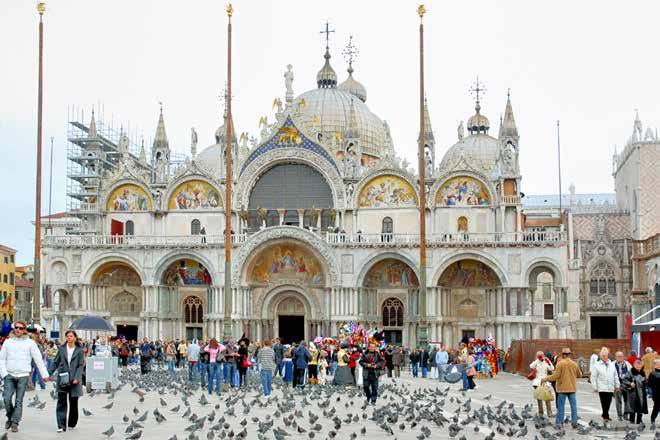

St. Mark’s Square has been the center of Venice since olden times. For many centuries, it was a focus of political and religious power. The basilica, upon which the best Italian and European craftsmen worked for centuries, has a unique façade and interior.
Its byzantine style is apparent in the frescoes of New and Old Testament scenes and the mosaic depicting St. Mark. The light descending into the basilica seems to draw a line between the earthly and heavenly realms and is reflected in the golden mosaic.
DAZZLING AND MAGICAL, VENICE IS MORE THAN A CITY, IT IS A WORK OF ART. A UNESCO WORLD HERITAGE SITE, VENICE IS SPREAD OVER 118 ISLANDS LINKED BY COUNTLESS SMALL BRIDGES AND CANALS FULL OF GONDOLAS.


The square houses the government seat of what was once the oldest city-republic in the world – La Serenissima (her highness), Venetians’ name for their city. Seven streets meet the square: Merceria, Frezzeria, Vallaresco, Via XXII Marzo, Campo San Luca, Campo Manin and Campo San Bartolomeo. Take a walk down nearby Campo Santo Stefano to see the Pinault collection in Palazzo Grassi, which has hosted legendary exhibitions since 1951. Visit Museo Fortuni for its jewelry exhibitions, and make sure to visit the San Grigorio Maggiore monastery, which includes the Giorgio Cini cultural collection.
CASTELLO, one of Venice’s most popular districts, hosts the main space of the biennale exhibition. It starts at the Bridge of Sighs and continues to Giardini. It then turns toward the churches of San Zaccaria and San Giorgio dei Greci and on to the arsenal shipyard and medieval port. This is the most popular tourist route.
The oldest ghetto in the world is located in cannaregio, which has many unique temples. The Fondamenta di Misericordia canal flows through the middle of this district. Walk to Madonna dell'Orto to see the tomb and frescoes of legendary Venetian artist Tintoretto.
DORSODURO ISLAND is located opposite of St. Mark’s Square by the entrance to the Grand Canal. Initially, the island was full of aristocratic gardens and parks and afterwards factories were built there. Presently, it is the domain of intellectuals, artists and wealthy foreign art patrons. There are four main museums here: François
Climbing the bell tower offers the best views of the city.
102 VOYAGER 3/2016
1. San Marco Basilica
2. The Piazza San Marco
3. San Marco Basilica. Detail
4. Santa Maria della Salute Basilica
5. Arsenale
1 2
4
6. Rialto bridge
3
DOGE'S PALACE –GOTHIC MAJESTY

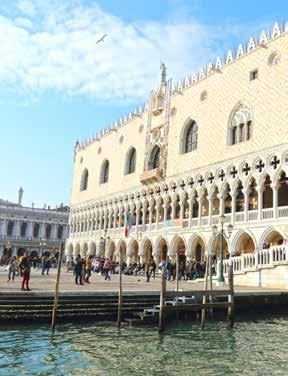
This grandiose architectural complex comprises many buildings and decorative works. Three main buildings unify the previous structures and create a cohesive whole.
The structure that faces the lagoon is the oldest, erected in 1340. It houses the Grand Council hall. Built in 1424, the Poll Hall faces the square. The Renaissance-style structure includes the doge’s residence and various government halls. It was renovated in 1483-1565.
Visitors can enter the palace from the so-called Wheat Gate (Porta del Fru-
mento), called after the nearby fodder office.
Pinault’s modern art center at Punta della Dogana, Peggy Guggenheim’s legendary private collection, Gallerie dell'Academia and Ca'Rezzonico.
Visit SANTA CROCE island to see the Ca'Pesaro modern art gallery and Ca'Corner della Regina, which contains the Prada collection. San Polo Rialto market is the liveliest sight on the Grand Canal, the Scuola Grande de San Rocco contains Tintoretto frescoes, and check out the interior of the Basilica dei Frari as well.
THE GHETTO
Jews that had emigrated from Germany settled in the areas near the glass factories called ghettos. The Venetian ghetto is located in one of the six main districts - Sestiere Cannaregio. The small streets and square and antique atmosphere makes it unique. There are five synagogues in the ghetto with simple façades and rich interiors. Here you can sample various Jewish-Venetian delicacies.
THE GRAND CANAL
The Grand Canal is the city’s main waterway. Almost 3,800 meters long, it crosses the whole city and divides it into two parts. Countless palazzos – 13th- to 18th-century palaces – are located on both sides. They bear witness to Venice’s wealth and glory. The canal was the principle trade route of the Republic of Venice until the Middle Ages.



Four bridges cross the canal, all of them built in a different era. The lat-
MURANO has been renowned for producing glass since the 14th century. Unfortunately, today the island is populated by mediocre souvenir stores. Burano is a beautiful fishing island with small colorful houses. It is famous for the restaurant Da Romano.

est, Constitution Bridge, was opened in September 2008, designed by architect Santiago Calatrava. It connects the Santa Lucia station to the Piazzale Roma. The next bridge is located by the station.
The following bridge, the Rialto, is a stone bridge completed in 1588. The Rialto district houses a famous market, open for business daily. It is located in the San Polo quarter at the base of the bridge. Venetians always visit the market in the morning, at which time the space comes alive with people and boats.
The last bridge is the oldest. It is called the Academy Bridge and connects the Dorsoduro and San Marco quarters. The four bridges are not the only means of crossing the Grand Canal: the gondolas are at your service and will take you to the other side for a small fee. The Grand Canal ends at San Marco, with a wonderful view of the lagoon.
103 VOYAGER 3/2016 VENICE
5 6
The entrance to this luxury hotel is located in the 18th-century Palazzo Dandolo, on the opposite side of the famous Harry’s Bar. According to Casanova’s memoirs, this is where Venetian aristocrats got ready for the carnival. The
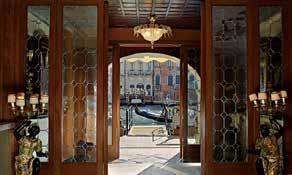
hotel restaurant is located on the Grand Canal side and attracts Venetian high society to this day.
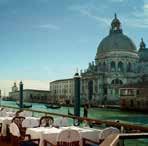


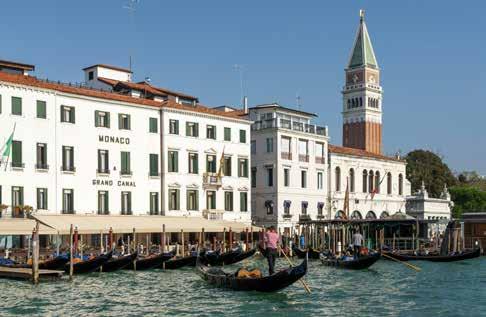
Prices starting at €225.
Calle Vallaresso (San Marco)
HOTEL FLORA
One of the most traditional and mesmerizing Venetian hotels housed in an 18th-century building.


Prices starting at €150.
2283/a, via XXII Marzo (San Marco)
AL REALI HOTEL
This beautiful hotel is located in the heart of the city. It has a typical Venetian façade on the canal side and a typical neoclassic style on the other side. The hotel has a restaurant, bar and spa.
Prices starting at €150.
Campo della Fava
HOTEL CONCORDIA
Stay in this hotel if Venice is St. Marks Square for you. It offers a unique view of the piazza.
Prices starting at €250.
The Piazza San Marco 367 (San Marco)
BAUER PALLADIO HOTEL & SPA
This hotel is located on La Giudecca Island. It occupies the space of the former 17th-century Zitell monastery. It was designed by famous Renaissance architect Andrea Palladio.
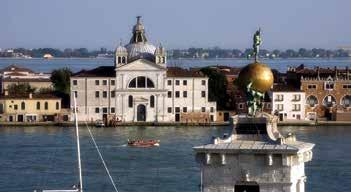
Its fantastic location, beautiful courtyard, celebrated restaurant l'Ulivo (overlooking the Grand Canal and St. Mark’s Square) and renowned spa are worth the expense. Prices starting at €500.
La Giudecca 33 (Giudecca)
CLUB DEL DODGE, GRITTI PALACE HOTEL
Amazing terrace overlooks the Grand Canal. Chef Daniele Turko offers simple yet unforgettable menu. Enjoy Pinot Griggio and a mix of the Venetian antipasti. Prices starting at €65.
Campo Santa Maria deal Giglio 2467 (San Marco)
DE PISIS
This restaurant was named after famous painter de Pisis and was inspired by a fresco of his. It is located in the Bauers L'Hotel. If you feel like taking a break from traditional Venetian food, Hiraki Masukozu offers modern cuisine; its high prices are matched by the pleasure derived from the food. Prices from €100.
San Marco 1413 (Campo San Moisè)
TAVERNA ALLA FENICE
AL PONTE ANTICO HOTEL
This small 17th-century palace is tastefully decorated. It is famous for a terrace that offers views of the Rialto Bridge. It is the perfect place to read Casanova’s memoirs. Prices starting at €350.
Cannaregio 5768 (Cannaregio)
Traditional old restaurant serving local dishes. Try risotto ‘de Secoe’. Prices starting at €53.
San Marco 1939
Campiello della Fenice
AL COVINO
A favorite among Venetians, this wine bar is a great spot to try marinated sardines and Spaghetti alla Bottarga.
Prices starting at €30.
Open: 12:00-15:00 / 19:00-01:00.
Calle del Pestrin 3829 (Castello)
CORTE SCONTA
Try marinated anchovies, crabs and shrimp with polenta.
Calle del Pestrin 3886 (Castello)
104 VOYAGER 3/2016
HOTEL MONACO & GRAND CANAL
LAVENA
A historic café that has hosted Wagner, List, Balzac, Rostropovich and Moravia.

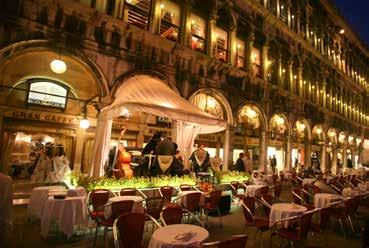
The Piazza San Marco 133-134 (San Marco)
CHIOGGIA
Cinematographic café.
The Piazzetta San Marco 8-12 (San Marco). Opposite side of the Doge’s Palace.
AL DUCA D'AOSTA
A multibrand store. Calle Larga San Marco 248 (San Marco)
ARNOLD'S & BATTOIS
DA ROMANO
This popular restaurant is located on Burano island. Venation artists, writers and intellectuals used to gather here.
Prices starting at €60.
Via Galuppi 221 (Isola di Burano)
Handmade bags by the Venetian craftsman

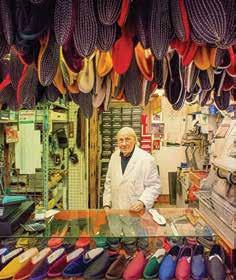
Calle dei Fuseri 4271 (San Marco)
ARCO DEL PARADISO
Perfume concept store. Calle del Paradiso 5751 (Castello)

ANNELIE
Legendary Venetian lace. Vaporetto Ca'Rezzonico (Dorsoduro)
GIORGIO NASON
Venetian glass, souvenirs Campo San Gregorio 167/a (Dorsoduro)
IL GRIFONE
ANTICHE CARAMPANE
This fashionable fish restaurant is located between Rialto and Campo San Polo. It offers a diverse fish menu, fantastic Gran Fritto Misto, Spaghetti Casopipa (with fish), tagliolini ‘coi zotoi’ (seppiole), fish with black ink.
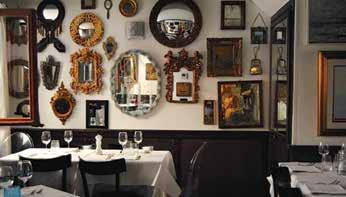
Prices starting at €65.
Rio Terrè delle Carampane 1911 (San Polo)
L'OMBRA DEL LEONE
The upper floors of Ca' Giustinian house the Biennale’s offices, while L'ombra del Leone is located on the first floor and offers the best view of the Grand Canal. It is the best place to go for an affordable aperitif.
Ca' Giustinian, Calle del Ridotto 1364/a
Venetian leather. Fondamenta del Gaffaro 3516 (Dorsoduro)
COSTUME NICOLAO ATELIER
Venetian costumes. fondamenta della Misericordia 2590 (Cannaregio)

VIZIOVIRTU
Viziovirtu is a chocolate shop located in the heart of the lagoon, between the San Marco and Rialto, exactly where Marco Polo lived and where the spice, coffee and cocoa trade prospered. These are the ingredients that Viziovirtu uses for making its best chocolate.
The store is open every day at 10:00 – 7:30. You can learn about the history of chocolate, and chocolate-making lessons are also available.
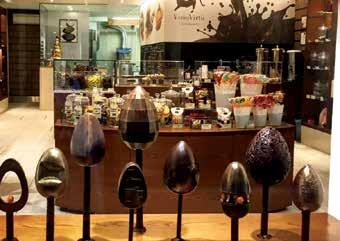
105 VOYAGER 3/2016 VENICE
Castello 5988, 30122
THE SANTA MARIA DEL FIORE (DUOMO) - this cathedral is one of the architectural treasures of the world. It holds the symbol of Florence – the famous Brunelleschi dome. The baptistery is right by the cathedral, adorned by the bronze Gates of Paradise and Giotto’s bell tower.


The bell tower is embellished with different types of marble and offers a spectacular view of the city.
THE PIAZZA DELLA SIGNORIA - here you can see different famous buildings such as the Palazzo Vecchio government building and the adjacent Uffizi Gallery.

Would you like to see exceptional works of art in an open air museum? Visit Loggia dei Lanzi, by the Palazzo Vecchio. Several magnificent statues stand under a picturesque dome, including Cellini’s "Perseus" and Giambologna’s "The Abduction of the Sabine Women". Michelangelo’s "David" greets visitors at the entrance.
FLORENCE
THE UFFIZI GALLERY - the Renaissance paintings and statues are the gems of this gallery. Additionally, it exhibits German, Flemish, Dutch, and French art. The Uffizi hosts a long list of famous artists: Cimabue, Giotto, Duccio di Buoninsegna, Botticelli, Perugino, Leonardo da Vinci, Giorgione, Correggio, etc. Interestingly, the architect designed a special hallway that connects Uffizi, the Palazzo Veccio and the Palazzo Pitti to the Boboli Gardens.
1. Santa Maria del Fiore (Duomo) cathedral
2. The Palazzo Vecchio
3. The Uffizi Gallery
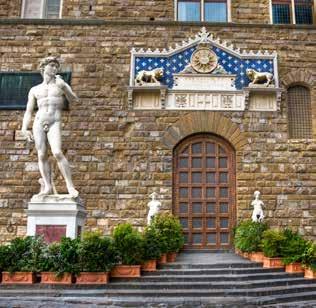

4. Santa Maria del Fiore (Duomo) cathedral

5. The Neptune Fountain
6. Basilica of Santa Croce
7. The Piazza della Signoria

8. The Boboli Gardens

9. Santa Maria Novella Basilica
10. Ponte Veccio
BASILICA OF SANTA CROCE –
this is the principal Franciscan church. Construction began in 1294, according to Arnolfo di Cambio’s blueprints. An impressive gothic structure with amazing frescoes and icons, magnificent vitrages and numerous statues, the basilica is an important example of Florentine art. It houses works by Cimabue, Giotto, Giovanni da Milano, Brunelleschi, Donatello, Domenico Veneziano, Bronzino, Vasari,
106 VOYAGER 3/2016
2 3 5 6 7 8 4 1
Canova and other masters. The Basilica is often referred as the "Pantheon of Italian Glory", since Machiavelli, Michelangelo, Galilei, Rossini and others are buried here.
PONTE VECCHIO - is the oldest bridge over the Arno River. Architect Giorgio Vasari constructed a secret hallway in the east part of the bridge, where trade was conducted. It is 1 km long and connects the old Medici residence (the Palazzo Pitti) to the new (the Palazzo Vecchio).

THE PALAZZO PITTI AND BOB -
OLI GARDENS - the Palazzo Pitti was the residence of Tuscan nobility. It was the biggest and most grandiose building of the Florentine palaces. It houses a number of museums. Here you can see works of Raphael, Titian and other great artists. Additionally, the porcelain museum, carriage museum and other sights impress visitors. The monumental Boboli Gardens are located behind the palazzo. This big elegant park was built for the
Medici family. It is designed in Italian style and contains another amazing open air museum: visitors can see statues from the antique times till the 17th century.
SANTA MARIA NOVELLA - this basilica was constructed for the Dominican Order in 1246. It is one of the most important and beautiful cathedrals in Florence, located on its namesake piazza.
The Gothic marble façade was designed by Leon Battista Alberti. It houses a number of exceptional art pieces: Masaccio’s "The Holy Trinity", a chapel painted by Ghirlandaio, and two crucifixes by Giotto and Brunelleschi.

ACCADEMIA GALLERY MUSE -
UM - this museum receives the largest number of visitors per year in Italy. Here you can enjoy Michelangelo’s work, including: “Slaves", “St. Mathew", and the famous "David" statue, which was moved into the museum in 1873.
1. "Madonna Del Granduca". Raphael

2. "Birth of Venus". Botticelli
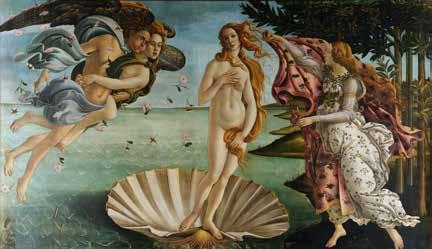
3. "The Holy Family". Michelangelo


4. "Madonna with a Rose" Piero di Giovanni Tedesco

5. Annunciation, Leonardo da vinci
6. "The Sacrifice of Isaac". Caravaggio.

7."The portrait of Pope Leo X"

ORSANMICHELE
This cathedral has a unique form. It was built from 1337-1404 and was used as a grain storage as well as a cathedral. It houses wonderful statues sculpted by: Donatello (St. George, St. Mathew, and St. Peter), Lorenzo Ghiberti (John the Baptist, St. Peter, St. Mathew, St. Stephen) and Andrea Del Verrocchio (Christ and St. Thomas). The church contains a unique sculpture by Piero di Giovanni Tedesco called "Madonna with a Rose".
107 VOYAGER 3/2016 FLORENCIE
9 10 1 2 3 5 4 6 7
SAN FIRENZE SUITS AND SPA

This hotel is located by the Piazza della Signoria across from the Bargello Museum, right in the heart of historical Florence. Price: starting at 200€.
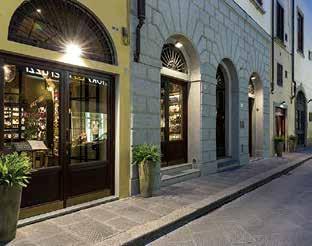
The Piazza di Firenze 3a
PALAZZO NICCOLINI AL DUOMO
A unique palace located by the Duomo piazza with interiors dating from the 18th century. Price: starting at 250€.
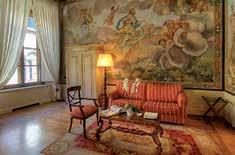
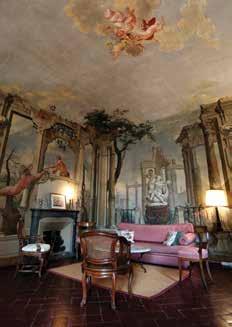
Via dei Servi 2
ST. REGIS
A luxury hotel located in a 15th century palazzo building with a breathtaking view over the Arno River. Price: starting at 500€.

The Piazza Ognisanti 1
ZEB GASTRONOMIA
Traditional family cooking in a contemporary stetting. Chef Alberto Navari and his mother Giusepina will gladly introduce their dishes.

Price: starting at 40€.
Open: 12:00-15:30 / 19:30-22:30.
Via San Miniato 2
SIMON BOCCANEGRA
This celebrated restaurant is on the first floor of the 16th-century Palazzo Salviati. The restaurant is famous for its Florentine steaks and wine cellar.

Open: 12:30-14:30 / 19:00-24:00.
Via Ghibellina 124/r (Santa Croce)
UNA HOTEL VITTORIA
A modern hotel by Ponte Veccio. It was designed by Fabio Novembre. Price: starting at 150€.

Via Pisana 59 (Piazza Pier Vettori)
IL LATINI

Tuscan trattoria: the real thing; reservations recommended.
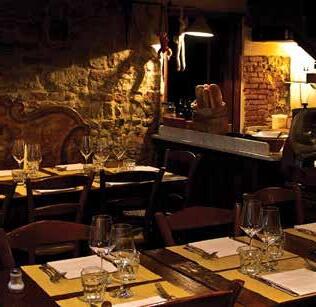

Price per person: starting at 50€. Open: 12:30-14:30 / 19:30-22:30.
Via dei Palchetti 6
CUCINA TORCICODA
This multifunctional space contains a confectionary, pizzeria, osteria and a restaurant. All four are culinary heaven. Open: 12:30-15:00 / 19:00-23:00; Closed on Sundays.
Via Torta 5 (Santa Croce)
MERCATO CENTRALE
IL SANTO BEVITORE
This high-class restaurant serves exquisite seasonal produce. Price per person: starting at 75€. Open: 12:30- 14:30 / 19:30-23:30.
Via di Santo Spirito 64/66
– an old Florentine market that has become the new gourmet center where you can taste unique Tuscan produce. Also, visit the Tosca pizzeria.
Open: 10:00-24:00.
The Piazza San Lorenzo
108 VOYAGER 3/2016
OFFICINA PROFUMO-FARMACEUTICA DI SANTA MARIA NOVELLA
A unique historical Florentine perfume house (1612) and drug store (1221). Natural products are beautifully wrapped in designs that have not changed for centuries. Open: 09:00-20:00.

Via della Scala 16
CAFFÈ LETTERARIO
Locals like to gather in this fun multifunctional space for drinks and music which contrasts with its morose origins as the Le Murate prison built in the 15th century. Open: 09:00-01:00.

The Piazza delle Murate
GROM
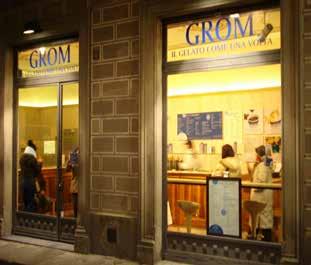
Huge queues testify to the popularity of this place; the ice-cream ingredients are imported: chocolate cocoa beans from Columbia and Venezuela and pistachio from Sicily and Sardinia.
Via del Campanile/Via delle Oche (Duomo)
ENOTECA PITTI
GOLA E CANTINA
This wine store adjacent to the Boboli gardens serves the best Tuscan wines and selected Tuscan cold meats. Open: 13:00-24:00.

The Piazza de'Pitti 16 (Oltrarno)
VOLPI E L'UVA
Small, cozy wine store offers the best wines. Open 11:00-19:00.
The Piazza dei Rossi 1r (Oltrarno)
PASTICCERIA GIORGIO
Offers the most celebrated Florentine cake, Dolc. Via Ducca Boninsegna 36
LA BOTTEGA DEL CIOCCOLATO Famous for coffee and croissants. Via de Macci 50
GELATERIA DEI NERI
Offers a wide variety of ice-cream, among them rose and gorgonzola icecream. Via dei Nerri 9/11
SALVATORE FERRAGAMO
Visit to the Ferragamo store and museum situated in the Middle Ages palazzo is a must.
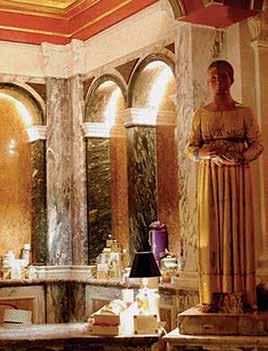



The Piazza Santa Trinita 5
GUCCI
This store was opened in 1921. Conceptual store/museum offers exclusive display of the brand’s history. Make sure to visit the café.
The Piazza Della Signoria 10
LUISA VIA ROMA
Popular luxury clothing, shoes and accessories store; houses every important international brand. Via Roma 19-21
RASPINI
Luxury clothing boutique; original store.
Via Martelli 5/7r
MARIE ANTOINETTE
Unique vintage store. Piazzetta dei del been 6/5
DONATO ZACCARO
Florentine goldsmith.
IL MICIO
Born in Japan and trained in Florence, Fukaia Hidekati makes exceptional handmade men’s shoes.
Via dei Federighi 6

109 VOYAGER 3/2016
FLORENCE
THE PIAZZA DEL CAMPO IS ONE OF THE BIGGEST AND MOST IMPORTANT SQUARES IN THE WORLD. IT IS SHAPED LIKE A SHELL AND HAS A RED COLOR. THE SPACE IS DIVIDE INTO NINE SECTIONS, WITH A COPY OF THE HISTORIC FONTE GAIA FOUNTAIN IN THE CENTER.

Climb 400 stairs of the tower of THE PIAZZA DEL MANIA to enjoy some amazing sights over Tuscany.

SANTA MARIA DELLA SCALA (XIII) is a museum complex in a charity hospital that took care of homeless children and pilgrims. It was decorated with frescoes in 1330. The museum houses an archeological and children’s museum, a photo gallery and library.

THE BAPTISTERY (1325) is a sacred place covered with unique frescoes and an elaborate baptismal font built with bronze and marble. Entry costs €4.
SANTA MARIA ASSUNTA CATHEDRAL was erected in 1215-1263 by Giovan-
ni and Nicola Pisano. This gothic cathedral is famous for its striped marble façade and colorful mosaic floor. It was created by the 40 best Sienese artists in the XIV-XVI centuries. Most of the panels are covered for conservation. They are only revealed during the Palio race. This year you will be able to enjoy 56 masterpieces from the beginning of June till mid-September.
You may also see the blue and golden dome painted by Bernini; the earliest round vitrage painted by Duccio di Buoninsegna; the last judgment scenes by Nicola Pisano (1268); statues of Donatello and a young Michel-
The old city stands upon three hills: TERZO DI CITTA: The following are located here: the Piazza Postierla; the smallest window in the world; via di Castelsenio (according to the legend, Romulus was hiding here); Capella della Ceneri di Sant’Ansano (the first city saint was martyred here); one of the first hospitals in Europe; and the Palazzo dele Papese.
THE SECOND HILL BOASTS (Terzo di Camollia) the main shopping street via Banchi di Sopra; two wonderful piazzas (the Piazza Salimbeni and the Piazza Tolomei), basilicas and an impressive fort - Fortezza. Here you will find Santuario di S. Caterina which houses the head of St. Katerina, the patron saint of Siena.
TERZO DI S. MARTINO – THE POLITICAL AND SOCIAL LIFE CENTER.
DA TROMBICCHE (via Del Terme 66) is a cozy, family place and the best eatery for lunch. Here you may taste sausage, prosciutto, panzanella (Tuscan salad) and wonderful homemade wine.
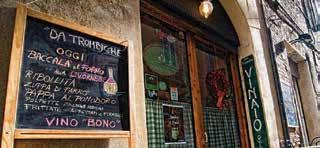

angelo, and a miraculous icon Madonna Del Voto. Open: 10:30-17:00; admission price €7.
You may also pay €2 to see the Piccolomini Library located on the premises.
THE PINACOTECA NAZIONALE (via San Pietro, 29) is a national gallery that exhibits an excellent collection of XII-XVII-century Sienese artists.
Open: 8:15-19:15 (Tuesdays - Sundays), 8:15-13:30 (Mondays); Admission price €4 (free of charge for under 18s).
TERZI (via dei Termini 7) serves typical Tuscan course - Bistecca Fiorentina, grilled stake. It is best paired with the Tuscan wines: Brunello di Montalcino, Montepulciano and Chianti.
LA TAVERNA DI SAN GIUSEPPE (via g. Duprè 32) also offers a traditional Tuscan menu: pici is a handmade spaghetti with a meat and tomato sauce; ribollita is a vegetable soup; gnocchi is a round potato pasta; florentina di chianina is a meat course of exceptional beef.
110 VOYAGER 3/2016
1 2 3
SIENA
Bank Monte dei Pasci was one of the first banks in Europe that was created in this medieval city-state in 1472. It is presently open for business. The university was founded 775 years ago. The center was closed to cars for preservation purposes in 1966.
MUZEO DEL OPERA DUOMO - the unfinished cathedral holds art pieces, including one of the most important Middle Ages painting, Duccio’s two-sided icon. Open: 10:30-16:30; closed on Tuesdays.
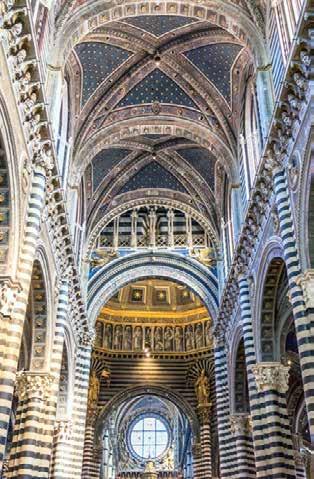
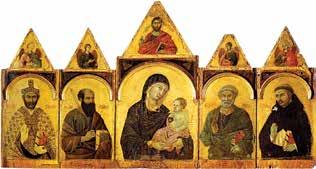

Admission price: €7. Purchase an OPI pass to enjoy all five historical buildings located on the Piazza Duomo. It costs €15-20.

GRAND HOTEL CONTINENTAL ; Via dei Banchi di Sopra 85
CAMPO REGIO RELAIS ; Via della Sapienza 25
PENSIONE PALAZZO RAVIZZA ; Via dei Mantellini 34
B&B PALLAZO BRUCHI ; Via Pantaneto 105
THE PALAZZO PUBBLICO (XIII) building houses city hall. The treasured Sala dei Nove (hall of the nine) exhibits world-renowned frescoes.

You may visit it 10:00-19:00, admission price €9 (free of charge for under 11s).
• To purchase handmade ceramics, visit: Bianco e Nero di Staccioli Sonia, via die fusari 21; Gift Shop 5, The Piazza San Giovanni 5.

Hand-illustrated books with leather binding: La Stamperia di Nanni Mario, via Camollia 126.
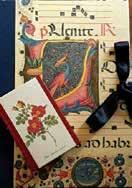
• Hand-stitched sheets: Siena Ricama, via di Città 61.
• High-quality Italian cashmere clothing: Dolci Trame, via Del Moro 4.
• Different Italian brand stores: Mag, via dei Termini 49
• Tuscan mushrooms: Siena Tartufi, vicolo dei Pollaioli 6/8.
• Local produce is sold on the premises of the ancient drug store: Drogheria Marganelli, via di Citta 71/73.
• For best coffee and Tuscan desserts, visit the historical center: Pasticceria Nannini, via Banchi di Sopra 22/24.
The traditional horse race began in 1655. Tickets are sold several years prior to the event and cost €250-500. This is a bareback horse race. The winner receives a handmade silk flag (no cash price) and a right to proudly ride their horse in the city for a whole year.
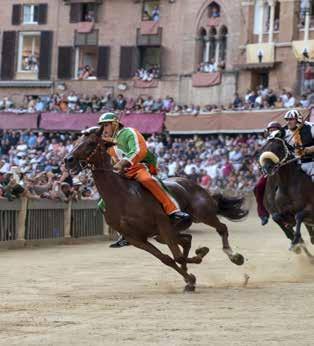
111 VOYAGER 3/2016 SIENA
PALIO
A legendary costume ball takes place on Piazza del Campo twice a year on July 2 and August 16.
1. the Piazza Del Campo
2. tower on Piazza del Mania
3. Santa Maria Della Scala
4. Piccolomini Library
5. Duccio’s two-sided icon.
6. Santa Maria Assunta cathedral
4 6 5
PERUGIA IS THE CAPITAL CITY OF THE UMBRIA REGION; IT WAS ONE OF THE MAIN ETRUSCAN CITIES AND A SIGNIFICANT MIEDIVAL CITY OF CENTRAL ITALY. THE CITY ELEVATION IS 450 M. IT IS OPEN TO TOURISTS ANY TIME OF THE YEAR. PERUGIA IS AN INTELLECTUAL CITY; ITS UNIVERSITY WAS FOUNDED 700 YEARS AGO. VISIT PERUGIA FOR A CULTURAL EXPERIENCE, BUT DON’T FORGET TO ENJOY THE LOCAL CHOCOLATE AND JAZZ MUSIC, WHICH CREATES A UNIQUE ATMOSPHERE IN THE CITY.
THE CATHEDRAL OF SAN LORENZO is located in the city center, near the Piazza IV Novembre. It was erected in 1345-1490 on the site of a Romanesque cathedral. The gothic interior is decorated with XVIII-century frescoes, among them the “Transfiguration of Jesus" (1569). St. Mary’s chapel contains a relic: a wedding band of the holy mother.

SAN DOMENICO BASILICA is the most monumental cathedral in Umbria. Only part of the rich XVII-XVIII-century statues and XIV-XV-century frescoes remain in the basilica; Napoleon’s soldiers left with the rest.

THE GRAND FOUNTAIN is a medieval fountain sculpted by Nicola and Giovanni Pisano, in 1278-1280.
PERUGIA
1. Perugia square
2. The Etruscan arch
3. Benozzo Gozzoli, the Virgin and Child Enthroned among Angels and Saints

The annual Umbria Jazz Festival has taken place every July since 1973. It is the largest jazz festival in Italy. Local trader, Paolo Ponetti came up with the idea. Presently it is a real celebration for music connoisseurs. Elite jazz musicians from all over the world perform here.


THE PALAZZO DEI PRIORI – the residence of the Perugia governors – looks over the square adjacent to the old street, Corso Vannucci. Three stories of the building house the Umbria national gallery – a treasure box of Italian art. The gallery exhibits Benozzo Gozzoli’s “Madonna and Child with Saints”.
THE ETRUSCAN ARCH also called the Augustus arch, was constructed in III
B.C. Roman emperor August renovated the arch in 40 B.C. when he defeated Marcus Antonius and conquered the city.

THE ROCCA PAOLINA castle was built by Pope Paul III in 1540; it surrounded the whole block of medieval buildings, including the church of Santa Maria dei Servi. It was a symbol of the Pope’s governance and the local population destroyed large sections of it.
LA TAVERNA (via delle Streghe 8) serves dishes prepared according to traditional recipes.

Pizzeria MEDITERRANEA (the Piazza Piccinino 11/12) is a popular place due to its delicious pizza. open: 13:00-16:00 and 19:0023:00).
Gelateria GAMBRINUS a perfect place for dessert-lovers. Here you can taste a variety of gelatos.
PIAZZA DANTI Piazza
Danti is a perfect place for dessert-lovers. Here you can taste a variety of gelatos. Piazza Danti hosts a farmers market every Monday from 8 a.m. Palazzo Della Prefetturax and Rocca Paolina (during winter) hosts a ceramic and jewelry market every last Sunday of the month.
The chocolate festival Eurochocolate is dedicated to the chocolate production traditions in Italy and around the world. It was established in 1993 by the architect Eugenio Guarducci. Perugia hosts theatre performances, exhibitions, culinary events and other spectacles during the festival. The most important event is the exhibition of giant chocolate cube statues.
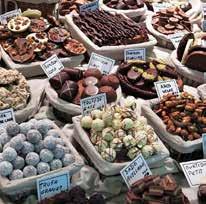
112 VOYAGER 3/2016
4. San Domenico Basilica
PERUGIA 1 2 4 3
ASSISI IS A WORLDRENOWNED RELIGIOUS, CULTURAL AND HISTORICAL CENTER. ST. FRANCIS - THE PATRON SAINT OF ITALY AND A SYMBOL OF PEACE - WAS BORN THERE IN 1182. ALMOST THE WHOLE TERRITORY OF ASSISI BECAME A UNESCO WORLD HERITAGE SITE IN 2000.
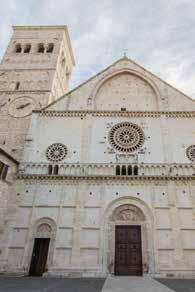
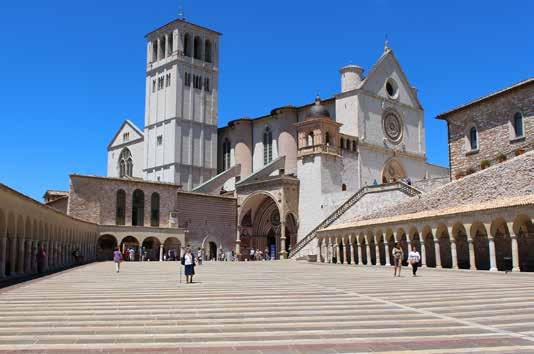
Since 1230, SAINT FRANCIS BASILICA has held the remains of the saint. His tomb is located in the crypt. The Basilica has a two-level structure. The lower square, which is adorned with 15th-century porticos, leads visitors to the lower temple. The basilica interior was embellished by great artists in the 13th to 15th centuries, including: Chimbaue, Giotto, Lorenzetti, and Simone Martini. It contains beautiful vitrage windows.
THE PIAZZA SANTA CHIARA was built in the 19th century and offers incredible views of the Umbria Valley. Here you can find St. Clare of Assisi basilica. The monastery and cathedral façade is decorated with white and pink stripes. The structures commemorate St. Francis’ first and devoted student, Chiara Offreduccio.
SANTA MARIA SOPRA MINERVA CA -
THEDRAL gives the Piazza delle Comune a sense of grandeur. It was originally a Roman temple; Pope Paul III reconstructed it as a Christian temple in 1539.
THE PALAZZO DEL PRIORI COM -
MUNE is also located here. It is the main political and cultural Assisi centre. The palace was built in the 14th century, on the site of three other structures that were erected in 1275.

EMBROIDERED ASSISI

According to legend, an Assisi nun copied Giotto frescos from the Saint Francis Basilica by stitching them on fabric and embroidering the background.


According to another legend, St. Francis returned with the crusaders and introduced Arabic embroidery (1219) and Italian craftsmen created unique style based on it. The Assisi technique uses a method known as voiding; red, blue and green silk thread is traditional.
EREMO DELLE CARCERI is located in the forest, 4 km away from Assisi, in the Mount Subasio foothills. Here you may feel the mystical attraction of living ascetically and harmoniously with nature. This is where St. Francis retreated with his first companions to dedicate his days to prayer. The monastery was later built by the cave and St. Mary chapel.
You may find traditional Umbria produce in TERRA UMBRA (via Patrono d’Italia 10): olives, prosciutto, cheese, wine and other ingredients for a delightful Italian picnic.
SAN RUFINO cathedral is located in San Rufino square, in the old city. It has a magnificent Romanesque façade, adorned with many statues. The interior was renovated in the 16th century. It houses the baptismal font that was used for the baptism of St. Francs, St. Clara, and Friedrich II, emperor of the Holy Roman Empire.
TRATTORIA DEGLI UMBRI (The Piazza del comune 40)
OSTERIA OTELLO (by the Chiesa Nuova Cathedral)
FINNEGAN'S PUB (The Piazza Matteoti)
BASILICA, a family restaurant, is located at Santa Maria degli Angeli (Via Protomartiri Francescani 11)
Locals also enjoy TAVOLA ROTONDA, which is located by the drug store.
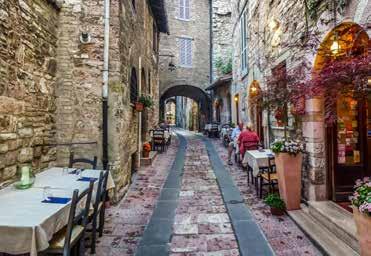
113 VOYAGER 3/2016 ASSISI
1. Saint Francis Basilica
2. Fresco in Saint Francis Basilica
3. Dome fresco detail in Saint Francis Basilica
4. Santa Maria Minerva Cathedral
1 2 3 4 ASISI
LUCCA IS KNOWN AS THE CITY OF A HUNDRED CATHEDRALS. IT IS LISTED AS UNESCO WORLD HERITAGE SITE. THE CITY HAS RETAINED ITS MEDIEVAL APPEARANCE.


THE CENTRAL PART OF LUCCA IS FULL OF HISTORICAL STRUCTURES. IT CONTAINS A PEDESTRIAN ZONE THAT HOSTS OPEN AIR EVENTS IN THE SUMMER. SURROUNDED BY HILLS, IT LIES 30 KM FROM THE SHORELINE AND 50 KM FROM THE MOUNTAINS.
The architect and designer FABIO NOVEMBRE created the silver-plated brass trays for the DRIADE brand, reconstructing piazzas located in Italian cities.

BISHOP OF LUCCA - St. Frediano built San Martino cathedral in the sixth century; it was completely renovated in 1060. Its interior includes Tintoretto's (15181594) "Last Supper", Bartolomeo's (1449-1494) "Madonna and Child", and a tombstone with Civitali (1436-1501) ornaments.
SAN MICHELE IN FORO BASILICA – This is a fine example of typical Lucca and Pisa architecture. It was built in 1070. This marble three-nave basilica is located in the midst of the city center. The main nave sits on rows of arches and the barrel vault stretches the length of the whole basilica. The bell tower is erected on the south side. Its façade is rich in ornaments and faces the ancient Roman forum. This is a favorite gathering place for locals. The main city streets begin here.
BASILICA OF SAN FREDIANO – Follow Fillungo Street from San Michele to approach this historical
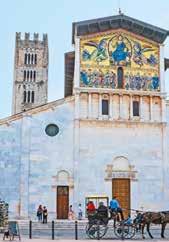


basilica. It was established by St. Frediano, bishop of Lucca. It contains the XIII-century mosaic "The Ascension of Christ the Savior". The latter is believed to be a masterpiece of Romanic architecture. The basilica’s unique XIV-XVI-century chapels are adorned with various works of art, among them the St. Augustine chapel with Amico Aspertini (1474-1552) frescoes and the Trenta family statues by Jacopo Della Quercia (1374-1438). Make sure to see the XII-century baptismal font.
THE BELL TOWER is the highest building in the city and offers spectaculars views. This mystical structure is associated with Lucida Mansi, who is fabled to have made a deal with the devil there to stay forever young.
NAPOLEON SQUARE is the political center of the city. The Ducal Palace houses the administration of the province. It was established in 1806, during the rule of Elisa Bonaparte Baciocchi, Napoleon’s sister.
BUCA DI SANT’ANTONIO - Established in 1782, this restaurant offers a traditional dishes such as lamb with olives, pasta with rabbit, and roasted goat kid with artichokes. It is located near the Piazza San Michele.

VINERIA I SANTI – The perfect place for dinner. It offers the best views of the amphitheater and a variety of wines.
“You can use these trays as amarcord (the neologism "amarcord "comes from the Emilia-Romagna dialect and means "I remember"). Everything happens on the piazza, they are the places of contact for the before-cell-phone civilizations". His silver-plated brass trays make the best souvenirs. They cost 200-500 €.
VECCHIA TRATTORIA BURALLI - A gourmet restaurant hidden on St. Georgio Street. It offers traditional and original dishes.
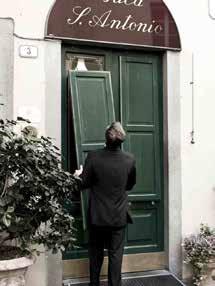
CAFFÈ DI SIMO - Puccini performed in this art nouveau café that offers a delightful breakfast: cappuccino and cornetto.
THE POPULATION OF LUCCA IS 88,000; AVERAGE INCOME IS 18,472 EUROS. THE CITY HOSTS 14 BOOKSTORES, 8 MOVIE THEATERS AND 197 RESTAURANTS.
114 VOYAGER 3/2016
1. San Martino cathedral
2. Amphitheatre square
3. Basilica of San Frediano
4. San Michele in Foro basilica
LUCA 1 2 3 4 LUCA
PISA USED TO BE ONE OF THE STRONGEST MARINE REPUBLICS OF THE MEDITERRANEAN, THOUGH IT IS RENOWNED FOR ITS TOWER: THE LEANING 56-METER BELL TOWER ADORNS A XII-CENTURY CATHEDRAL. IT BECAME TILTED 10 YEARS AFTER IT WAS ERECTED, DUE TO THE GROUND INCLINE. THE LEANING TOWER OF PISA IS ONE OF THE MOST FAMOUS STRUCTURES IN THE WORLD.
PROMINENT PIAZZA DEI MIRACOLI IS AMONG THE UNESCO HERITAGE SITES.
SANTA MARIA ASSUNTA CATHEDRAL
is located on Piazza dei Miracoli. Constructed by the architect Buscheto, it represents the Pisan Romanesque style of architecture. Its interior includes Byzantine, early Christian and Arabic influences.
PISA BAPTISTERY OF ST. JOHN The Pisa Baptistery of St. John is another symbol of the city located in Piazza dei Miracoli. The baptistery was designed by Diotisalvi and construction began in 1153. The interior is simple, lacks décor and provides an

excellent acoustic. The pulpit was sculpted by Nicola Pisano and presents scenes from the life of Christ.

Take a walk on the aristocratic embankment of the old city. The night lights are magically reflected in the water. Every embankment has its own name.
Here you will find many architectural treasures, among them Santo Sepolcro and San Paolo a Ripa d'Arno cathedral, and the palazzos: Agostini, Gambacorti, Pretorio, Reale, alla Giornata, etc.


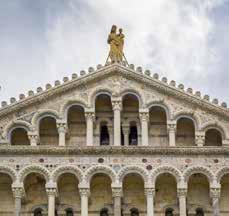
Two summer events take place in Pisa. Luminaria is held to celebrate San Ranieri, the city’s patron saint. The embankment is lighted with 10,000 candles. Concerts, performances, contests and fireworks take place.

The so-called "bridge games" take place at the end of June. According to the Middle Ages tradition, the populations of both shores of the Arno River participate in a historical march, which ends with competitions by the bridge.
You will find Osteria di Culegna on the main pedestrian street (via Mercanti). It offers a wide menu. You may also visit Vineria di Piazza (piazza delle Vettovaglie) for tasting wine and national cuisine.
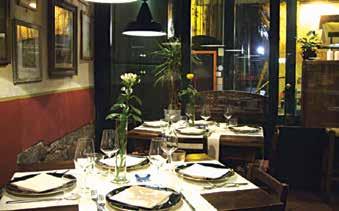
The Campo Santo is one of PISA’S MAIN SIGHTS , a 130 m long cemetery. Its wall faces the square and carries 43 arches.
PIAZZA DEI CAVALIERI is an ancient public square where the so-called "seven roads" met; it held the ancient Roman forum. Cosimo de Medici turned it into the center of the Order of St. Stephen to protect the Mediterranean shoreline from the Turkish fleet and pirates. The biggest site in this square is the Palazzo Della Carovana, with its impressive façade designed by Giorgio Vasari. A school established by Napoleon Buonaparte is situated here. The Palazzo dell’Orologio is right next to it. Del Consiglio dei Dodici is on the south side of the square. This palace is painted by XVIII-century artists. The Piazza delle Vettovaglie contained the city market in the XVI century. Borgo Stretto (XIV) street starts here, embellished with arches from the Middle Ages.

115 VOYAGER 3/2016 PISA
1. Piazza dei Miracoli
2-3. Fragments of Santa Maria Assunta cathedral
4. Interior of Santa Maria Assunta cathedral
5. Campo Santo
1 2 3 4 5 PISA
SAN GIMIGNANO IS SURROUNDED BY XIII-CENTURY WALLS AND RETAINS THE ATMOSPHERE OF THE MIDDLE AGES. STRUCTURES TYPICAL OF THE XIV-XV CENTURIES ARE PART OF THIS UNESCO WORLD HERITAGE SITE. SAN GIMIGNANO IS A RARE EXAMPLE OF A COMMUNE CITY OF THE MIDDLE AGES WITH HIGH TOWERS AND MAGNIFICENT CASTLES.
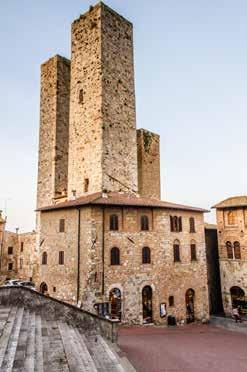
San Gimignano had a booming economy until the middle of XIV century. Trade and pilgrims that followed the so-called "road of Franks" were the source of San Gimignano’s riches. This ancient "highway" divided the city into two parts. San Gimignano’s architecture was influenced by competition between its rich families: whoever erected the tallest tower was deemed to be the most important in the city. However, legislature stated that the Rognosa tower had to be the tallest.
70 such towers graced the city in 1300, representing 70 rich families; only 13 have survived to the present day.
THE PALAZZO DEL POPOLO - is the main sight of the city; presently, it houses a museum which mainly exhibits works of the XII-XIV-century Florentine and Sienese schools of art - including the "Crucifixion" by Coppo di Marcovaldo, Taddeo di Bartolo’s triptych and Filippino Lippi and Pinturicchio paintings. The palace hall is decorated with magnificent frescos.
SAN GIMIGNANO
You will find out everything about San Giminiano’s best wines and its wine-making tradition at Villa Della Rocca di Montestaffoli wine museum.


SAN GIMIGNANO CATHEDRAL - is a prime example of Tuscan architecture; its walls are embellished by frescoes featuring New and Old Testament scenes, painted by Bartolo di Fredi. Benozzo Gozzoli‘s fresco the "Martyrdom of Saint Sebastian" graces the cathedral entrance. The cathedral includes impressive wood statues made by Jacopo della Quercia,

and Taddeo di Bartolo’s scenes of the last judgment. The real pearl of the cathedral is an altar painted by Domenico Ghirlandaio (1468). Make sure to see the altar sculpted by Benedetto da Maiano (1475).
TORRE GROSSA – is the only tower built in 1298, which is open to tourists.


You can taste San Gimignano’s best wines in this Enoteca. Make sure to pair it with a Tuscan crostini. Open: 11:30-18:30.
You can try delicious gnocchi with sausage in the city’s best restaurant. Also, try pasta pappardelle Cinghiale.
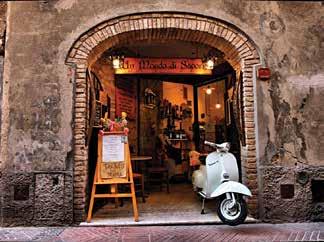
116 VOYAGER 3/2016
VERNACCIA DI SAN GIMIGNANO
Via della Rocca 1
UN MONDO DI SAPORI
Via San Martino 51
1. Palazzo Del Popolo
2. Torre Grossa Tower
3. Fresco ornament, Bartolo di Fredi
4. San Gimignano Cathedral
1 3 2 4 SAN GIMIGNANO
PERUCA
Via Capassi 16
AFTER ROME, VERONA BOASTS THE LARGEST CONCENTRATION OF HISTORICAL STRUCTURES IN ITALY. THESE INCLUDE AN ANCIENT ROMAN AMPHITHEATER, A STONE BRIDGE OVER THE RIVER ADIGE, THE TRIUMPHAL ARCH AND THE CITY GATE .


THE ARENA AMPHITHEATER that hosts large rock concerts and festivals. It is the third-largest ancient Roman amphitheater after the Coliseum in Rome and the Capua amphitheater.
It was erected in the first century B.C. during the rules of Augustus and Claudius. It has an elliptic shape and is surrounded by 27 double-stone arches. Gladiator fights, duels, dance and circus performances took place here. Bulls were trained in the amphitheater. Large opera festivals have taken place in the Arena since 1993.
THE PIAZZA BRA – visit Palazzo Barbieri and Palazzo Della Gran Guardia, the fountain of the Alps, the Listone pedestrian bridge and the adjoining aristocratic palace. Enjoy the city walls (constructed during the Visconti’s rule), the statue of Victor Emmanuel II and the tower.

THE PONTE PIETRA BRIDGE - completed in the first century B.C., this bridge is probably the oldest and most beautiful ancient Roman structure in Verona. It is one of the symbols of the city.
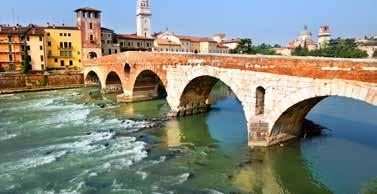
LAMBERTI TOWER - - located above the palace, the tower was erected by the Lamberti family in 1172. Visi-
The golden axis of shopping is via Mazzini, located between Piazza Bra and Piazza delle Erbe. The window displays of the exclusive Italian fashion boutiques attract tourists 24 hours a day.
Corso Santa
Those that appreciate rarities and small souvenirs will enjoy the Anastasia antique store.
tors can access the tower via stairs or elevator to obtain a spectacular view of Verona.
DOMUS MERCATORUM - a striking building built in 1301 to house the local merchants’ association when a new market was opened in the square.
II DESCO (VIA DIETRO S. SEBASTIANO 7) _ located on a narrow street in the old city, this restaurant serves great seafood.
RESTORANTE GREPIA (VICOLO SAMARITANA 3) _ with its marble interior and stone columns and arches, this restaurant transports diners to another world. It offers exquisite dishes and a variety of desserts.
12 APOSTOLI (CORTICELLA SAN MARCO 3) _ a well-established restaurant serving traditional cuisine, this eatery enables diners to feel the old city atmosphere.
BARRAKA (VIA LEGNAGO 120) _ This restaurant’s modern retro interior, including leather couches and colorful pillows, pairs really well with the original dishes on offer.
MAKE SURE TO TASTE HORSE MEAT (CAVALLO), THE MAIN DELICACY OF VERONESE CUISINE.
Juliet’s house – a 14th-century building that belonged to the Dal Cappello family. This is where the most famous love story of all took place, according to the legend. The façade features the famous balcony

THE DUOMO SANTA MARIA MATRICOLARE VERONA CATHEDRAL – the most beautiful of the city cathedrals, it was consecrated by Pope Urban III in 1187. The cathedral’s architecture is a fantastic blend of Romanesque and Gothic elements. The portal is decorated with images of saints and animals, and colorful bas-reliefs depict a nativity scene.
and the interior is renovated in 16th-century style: the walls are cover with frescoes, alongside chairs, trunks and brick fireplaces. Nereo Costantini’s statue of Juliet is located in the courtyard.


117 VOYAGER 3/2016 VERONA
1 2 3
1. Piazza Bra
2. Arena amphitheater
3. Ponte Pietra Bridge
4. Palazzo Della Gran Guardia
4 5 VERONA
5. Duomo Santa Maria Matricolare, Verona Cathedral
When the wind brings the scent of the sea
First you feel the scent of the sea. Then, pampered cypresses and cedars appear on the serpentine road, as if they were theater statists of antiquity, in an unnatural orderly manner and exuding southern splendor. The Oleander flowers blooming beside the road become more vivid. One more turn and . . . the Amalfi coast, the cradle of Dolce Vita, emerges. Words cannot describe the beauty of this road or coast. One thing is certain: your breath will be taken away and you will feel giddy with happiness when gazing out at this view.
AMALFI is Italy’s most vivacious coast, partly because it does not have a single city. It is a set of small villages, attached to the mountain like swallows’ nests, and castles atop the rocks, stirring nostalgia for Sorento’s 19th century tourism. It culminates in Sorento port. A constant trail of cabriolets and scooters move in Italian rhythm along the Amalfi serpentine. Amalfi conjures up images of a blue coastline and Bellini cocktails. It is personified by constant movement, by constant flow:like walking in espadrilles and straw hats along the wisteria-covered streets, with a Positano tan, up to Ravelo, where the row of grand hotels hosts musical festival guests and relaxed tourists.
Praiano, Amalfi, Positano, Maiori. Isn’t it


118 VOYAGER 3/2016
reminiscent of a song? The first glorious place in Amalfi – and, incidentally, the first stop on the way to Italian summe – is Sorento. Though Sorento is formally located at the edge of the Gulf of Naples, the route to Amalfi starts here.
Before moving to the warm waters of the Gulf of Solerno and visiting the fishing villages, wealthy tourists made Sorento their base. Naples and the must-see Pompeii and Herculaneum are in the vicinity, as is Vesuvius, sleeping majestically. The rocky coast of Sorento, which dives steeply into the azure sea, boasts numerous hotels, which breathe the air of southern version of the "Magic Mountain".
Byron, Goethe and Ibsen stayed in these hotels. Many of them still retain the spirit and glory of the past.
One fine day in 1817, a Frenchmen felt weak in the knees and felt his heart beating rapidly while at the Basilica of Santa Croce in Florence. He had become over excited at being near the graves of Machiavelli, Michelangelo and Galilei. This emotional French writer was Stendhal, author of one of the first books about travelling in Italy. Inadvertently, he started two interesting phenomena – cultural tourism and the psychosomatic disorder hyperkulturemia.
The latter is also known as Stendhal Syndrome, which can take hold when encountering works of art or coming into contact with significant artifacts from ages past. In its lighter form, it manifests itself in a rapid heartbeat and dizziness; in its heavier form, in a state of shock.
Stendhal also travelled to the south, and forged the way for many with his book. If you wish to experience Stendhalian Italy, you should stay at the Grand Hotel Excelsior Vittoria, or at least pop in for a coffee.

Most of the hotels on the coastline of Sorento are five-star, and in addition to the unforgettable view of Naples, they offer private beaches. This is rare as Sorento’s coast is mainly steep and rocky. To get from the hotel to the beach requires taking an elevator or stairs. Nothing compares to the view from this coast, though if you are dreaming of indulging yourself with sandy beaches, this place is not for you.
It is better to drive to the Amalfi shore, and Naples provides the perfect starting



point. After three hours on this beautiful road, and you arrive in Positano. Wherever you decide to stay in Amalfi, sooner or later you will probably wish to travel to the nearby villages and towns.
Taking public transport in the August heat is quite the challenge. I remember the hour I spent in a small Positano bus ‘bonding’ with 100 other people; I strongly recommend renting a car.
This will afford you much more freedom, though do bear in mind that parking in Italy in the summer can be a real challenge, and you should opt for a smaller car.
The most popular villages on Amalfi shore are Positano and Amalfi. You will understand why when you see them. Amalfi has a large sand beach with ample amenities, while Positano has a smaller sanded area.
This all is determined by the size of the gulf in which the village is situated.
It costs around 10 euros to visit most of the beaches, which includes an umbrella and a sun lounger. Unless you are staying in a four-five star hotel (most of which have swimming pools or their own beaches), then we recommend selecting a place to stay near the largest beach. This will not be hard, as every second house on the Amalfi shore is either a hotel or up for rent.
This area is famous for its beautiful houses overhanging from the mountain and for its church domes decorated with colorful tiles, as well as for its restaurants offering delicious fare.
My friend, culinary expert and generally very good ‘Positanologist’ Keti Bakradze, will help to make these special places unforgettable.
119 VOYAGER 3/2016 AMALFI
GRAND HOTEL EXCELSIOR VITTORIA Via Papa Leone X, 84011 Amalfi SA
BELLEVUE SYRENE Piazza Della Vittoria 5, 80067 Sorrento
1 2 3
GRAND HOTEL AMBASCIATORI Via Califano 18, 80067 Sorrento
LE SIRENUSE
This is a premier hotel which, in addition to a breathtaking view, swimming pool, and spa, features a wonderful restaurant. The restaurant terrace affords a superb view of Positano in the evening. It makes the best Rosini in Positano here. The hotel has a shop where you can buy everything you need for the beach, as well as more formal attire.
Via Cristoforo Colombo 30, 84017 Positano (SA)
The Amalfi coast is overlooked by several delightful villages within five-10 minutes’ drive. The relatively long distance from the sea is compensated for by the breathtaking view. If you are travelling with a child and are looking for a quieter environment, you might consider Scala or Ravello. Ravello is a small, charming city with Palazzos, stunning Villas, and squares. Every second picture showcasing the beauty of Amalfi is shot in the gardens of the famous Villa Cimbrone of Ravelo. This view is comparable only with the panorama from Anacapri. Ravello's most beautiful hotel is situated in this villa, a dreamlike place and the venue for many romantic weddings.
BELMOND HOTEL CARUSO

Caruso is Ravello's most famous hotel. In addition to having the most beautiful swimming pool in Europe (which seems to merge with the sky and the distant sea), the hotel is known for its restaurant, set in a beautiful garden. You can enjoy a delicious Bellini at the bar before dinner, then dine on lobster while appreciating the nighttime view of the bay.
HOTEL PALAZZO MURAT
This is another hotel with astounding gardens and a beautiful restaurant. The hotel itself is a Positano landmark. You can enter the garden from the famous glycinia covered street.




Having a coffee here during the day is very enjoyable, and if you are tired of wearing a swimsuit and would like to spend an evening in stylish dress, the Murat’s restaurant is the best place to go.
via dei Mulini, 23
If you would like to enjoy dinner in a Michelin-star restaurant with one of the best wine cellars in Italy, consider visiting La Caravella. According to chef Keti Bakradze, in addition to the wonderful selection of wines, the black raviolli with lobster is a must.
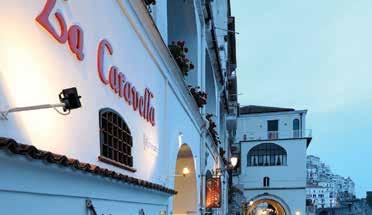
The restaurant is closed on Tuesdays. Lunch is served from 12:00 to 14:30, dinner from 19:00 to 23:00.
DA ARMANDINO restaurant, set at the bottom of the rock at the Marina di Praia, is typical not only of the Amalfi coast, but of a familyowned Italian restaurant.
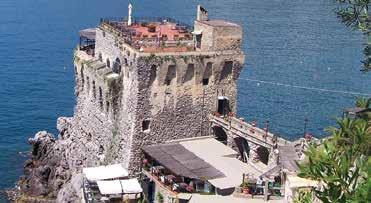
Delicious fresh seafood and the wonderful culinary art of Mr.Armandino and his wife Carmella is a great pleasure and a truly Italian experience. The shrimp risotto and seafood pasta are true wonders. Lemon cake for dessert is highly recommended.
If you walk down the shore at 10 in the morning, you will find a boat with a local red fish. This boat will take you to the Da Adolfo restaurant. There is no other way to get there. The boat service is free for visitors to the restaurant, and will take you back to Positano at 16:00.

120 VOYAGER 3/2016
The Piazza San Giovanni del Toro, 2
CAPRI
In 27 BC, Roman Emperor Tiberius decided to manage his empire from Capri. The island's enchanting beauty is still thrilling visitors today.

Everybody has their own Capri story. This island, which split off from the Amalfi coast, stirs numerous emotions in me. Unsurprisingly, Capri became a tourist destination during the Roman Empire. This is evidenced by Tiberius's villa, and Roman historian Tacitus chronicled that 12 villas were built on Capri.
This warm island has something to offer everyone. Quiet evenings spent with friends in a white villa set among the vibrant colors of the Buganvilia flower gardens, or a vibrant bar in a five-star hotel on Via Camerelle, Anacapri’s main street.
You can meet many different people on Via Camarelle, which is the most elegant street on Capri, hosting world-famous brand stores and jewelry boutiques. From Naomi Campbell to Dasha Zhukova (Roman Abramovich has bought one of the most impressive villas in Anacapri), many famous people enjoy this island’s beauty and the gentle sunshine.
If you are not planning to stay on Capri, oneday tours are available. You can reach the island from Positano by ferry, or rent a yacht (the ferry may be preferable if you suffer from seasickness) . As you approach Capri, an plethora of cabriolet taxis will meet you, offering to show you the island for 200-250 euros. This is a good way to get around, and especially to get to Anacapri. The tour includes the Grotta Azzurra, one of Capri’s landmarks.
If the celebrity villas and hotels do not interest you, you can always enjoy the shopping, though we really would recommend taking in Anacapri’s panoramic views.


TIBERIO PALACE via Croce 11 - 15, Capri
PALACE HOTEL & SPA via Capodimonte 14, Capri

HOTEL QUISISANA via Camerelle 2, Capri
HOTEL EXCELSIOR PARCO via Provinciale Marina Grande 179, Capri
HOTEL VILLA BRUNELLA via Tragara 24, Capri
AMALFI / CAPRI
121 VOYAGER 3/2016
CINQUE TERRE
If you have seen Talented Mr. Ripley, you can probably picture Cinque Terre. It is a unique formation of little fishing towns in Liguria on the Italian coast. If you dream of taking a break from car exhaust and noise and are willing to tackle hundreds of steps on foot, than Cinque Terre is the place for you.

Despite its inaccessibility (it is almost impossible to move around by car due to the lack of roads), tourists still reach the narrow streets and colorful villages. They bravely attack the hundreds of stairs and sample genuine Italian village life.
It is best to move between the villages by train, or you can use the narrow (and not particularly comfortable) road built in 2012 to reach the village of Vernazza; you will need to park your car there and continue on foot. Therefore, if you do not own a yacht (which is the best means of transportation in this area), you should park your car at La Spezia and continue by train. You can also reach La Spezia by train from Genoa. This takes two hours, as does the journey by car.
Cinque Terre’s everyday life is best viewed from the sea. In the past, the fishermen painted their houses different colors so that they could recognize their homes quickly from the sea and see what their families were doing. You can travel from one


CINQUE TERRE, WHICH MEANS ‘FIVE LANDS’, COMPRISES FIVE VILLAGES:

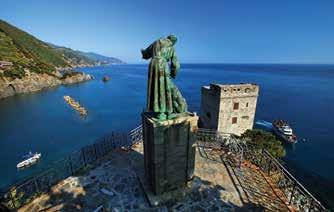
MONTEROSSO AL MARE, VERNAZZA, CORNIGLIA, MANAROLA, AND RIOMAGGIORE.
village to the next by train or on foot. Each trip takes five-10 minutes by train, and you can use a full-day unlimited ticket. You can quickly reach all of the villages except Corniglia by ferry.
You will need to climb 368 stairs to reach Corniglia. Despite the significant physical strain, the roads between the villages have romantic names such as Love Road and Turquoise Road.
You will not have to exert yourself to find food – all of the villages have ample to feed hungry tourists.
Naturally, fish is the main dish in the fishing villages. The EU has even granted special status to Monterosso’s anchovies.
Grapes, olives, and vegetables grow in abundance on Cinque Terre’s terraces. Its famous pesto is made from local basil, pecorino cheese, garlic, and olive oil, being the signature souse of Liguria. The famous Corniglian ice cream is flavored like the local honey. Focaccia, a type of Italian bread, and Ligurian cuisine can easily be found in Cinque Terre’s bakeries.
HOTEL PORTO ROCA VIA CORONE 1, 19016 MONTEROSSO AL MARE
HOTEL LA POSADA B&B VIA ALLA STAZIONE 11, CORNIGLIA
HOTEL LA TORRETTA VIA VICO VOLTO 20, MANAROLA
GAMBERO ROSSO PIAZZA MARCONI 7, VERNAZZA (CLOSED ON MONDAYS)
LA GAMBUSA VIA ROMA 6, MONTEROSSO (CLOSED ON MONDAYS)
122 VOYAGER 3/2016
MONTEROSSO AL MARE VERNAZZA
PISA
CORNIGLA MANAROLA RIOMAGGIORE
CINQUE TERRE

K ARLIE KLOS S LON G ISL AND, NE W YO RK SEP TEMBER 2015 MARELL A CO M TBILISI PUSHKINI STREE T 15 T 0322200 042



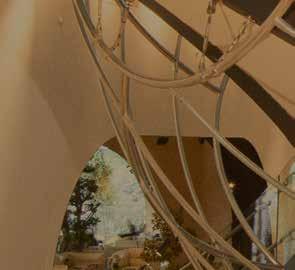








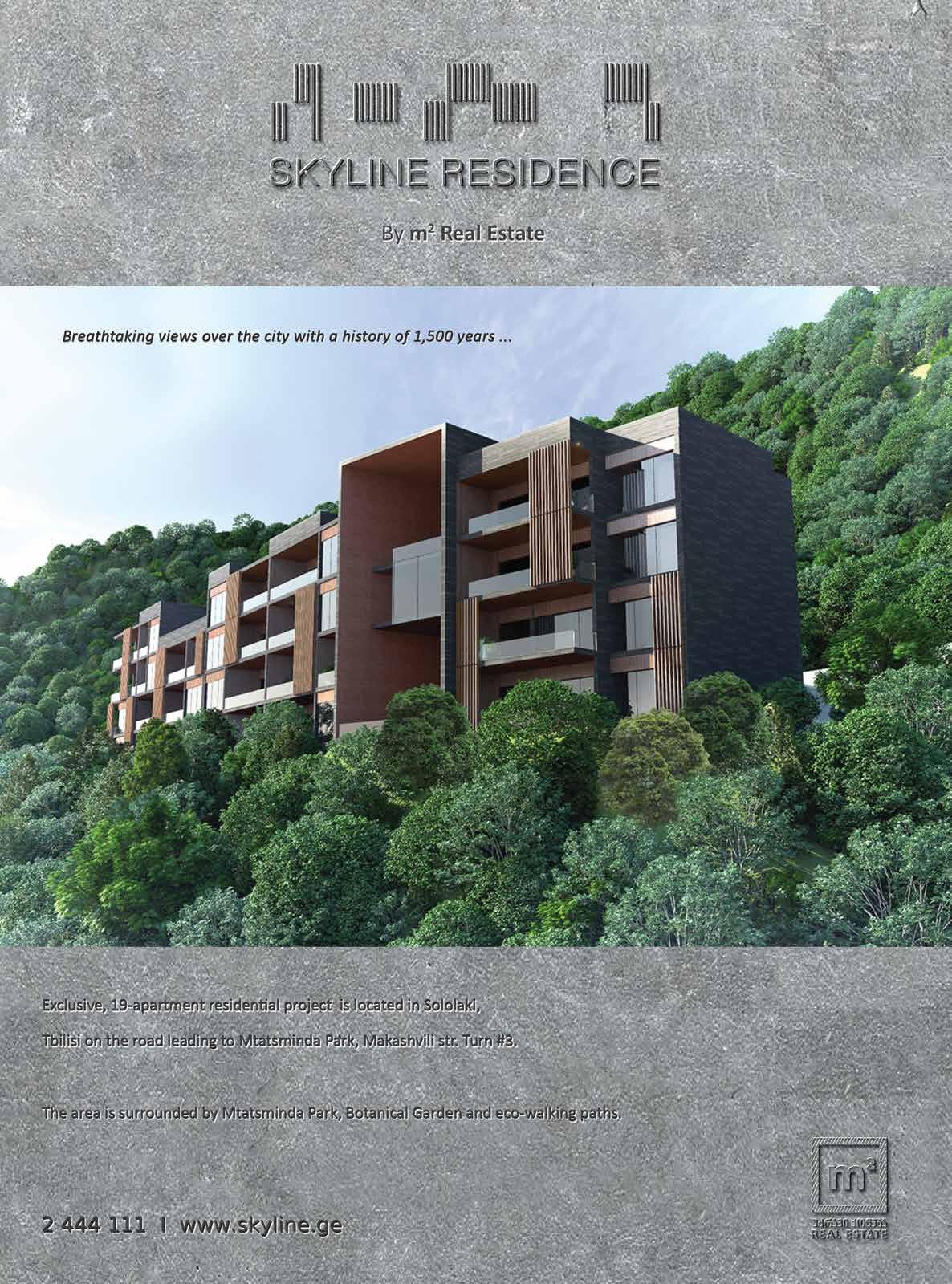




























 ANTONIO BARTOLI
ANTONIO BARTOLI













 SALOME DADUNASHVILI
SALOME DADUNASHVILI































































































 Simon Baker
The Longines Master Collection
Simon Baker
The Longines Master Collection








































































































































































































































































































































































































